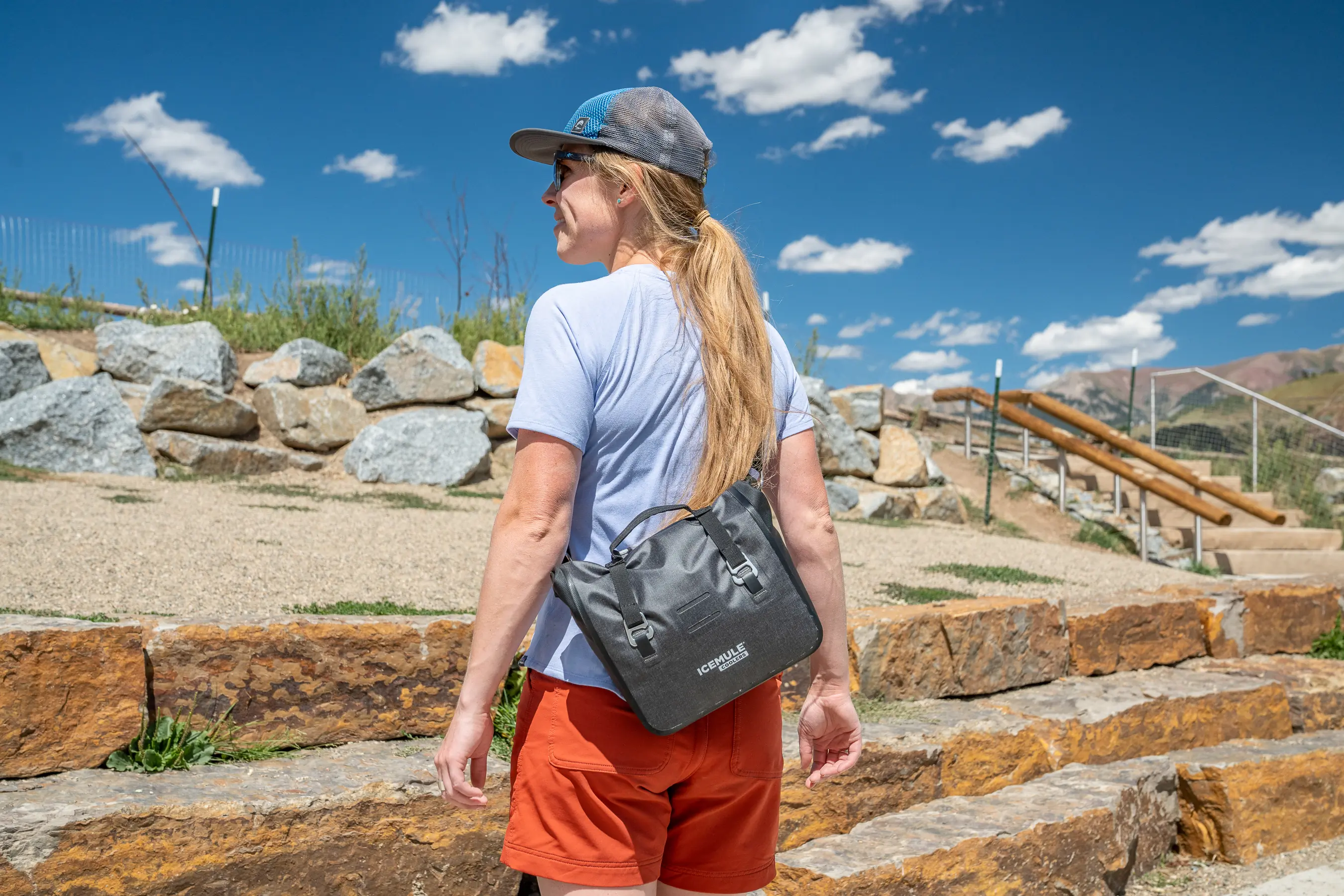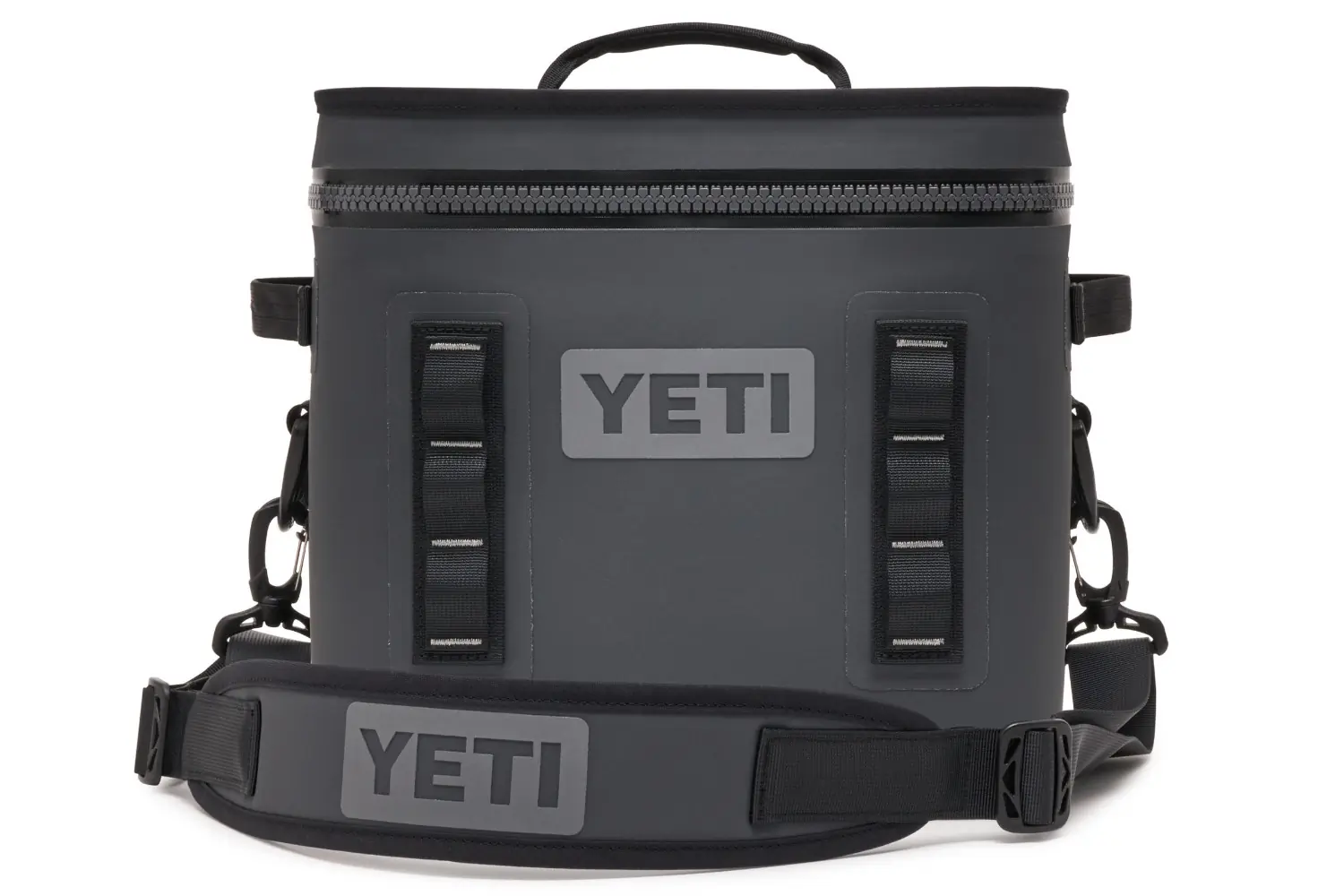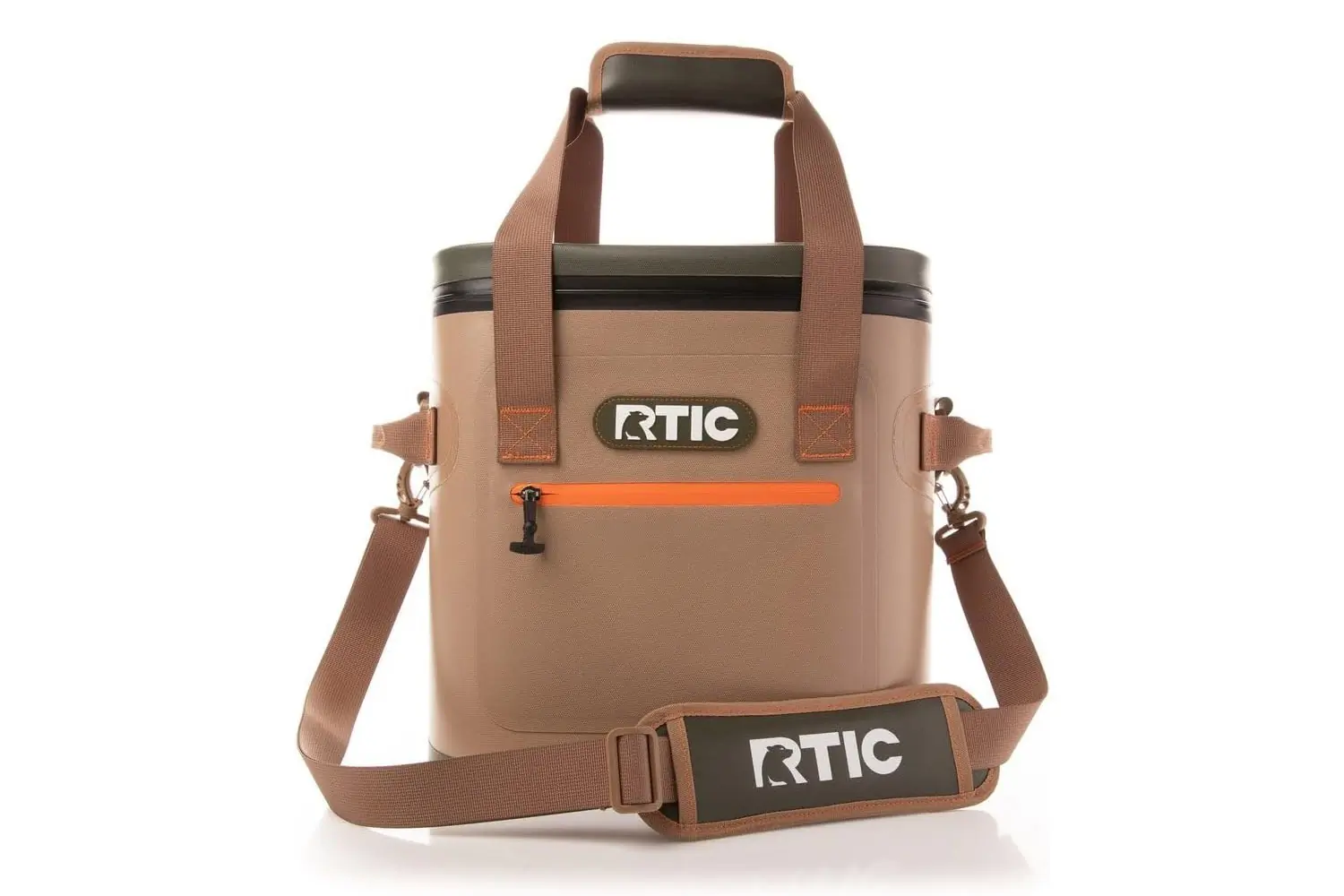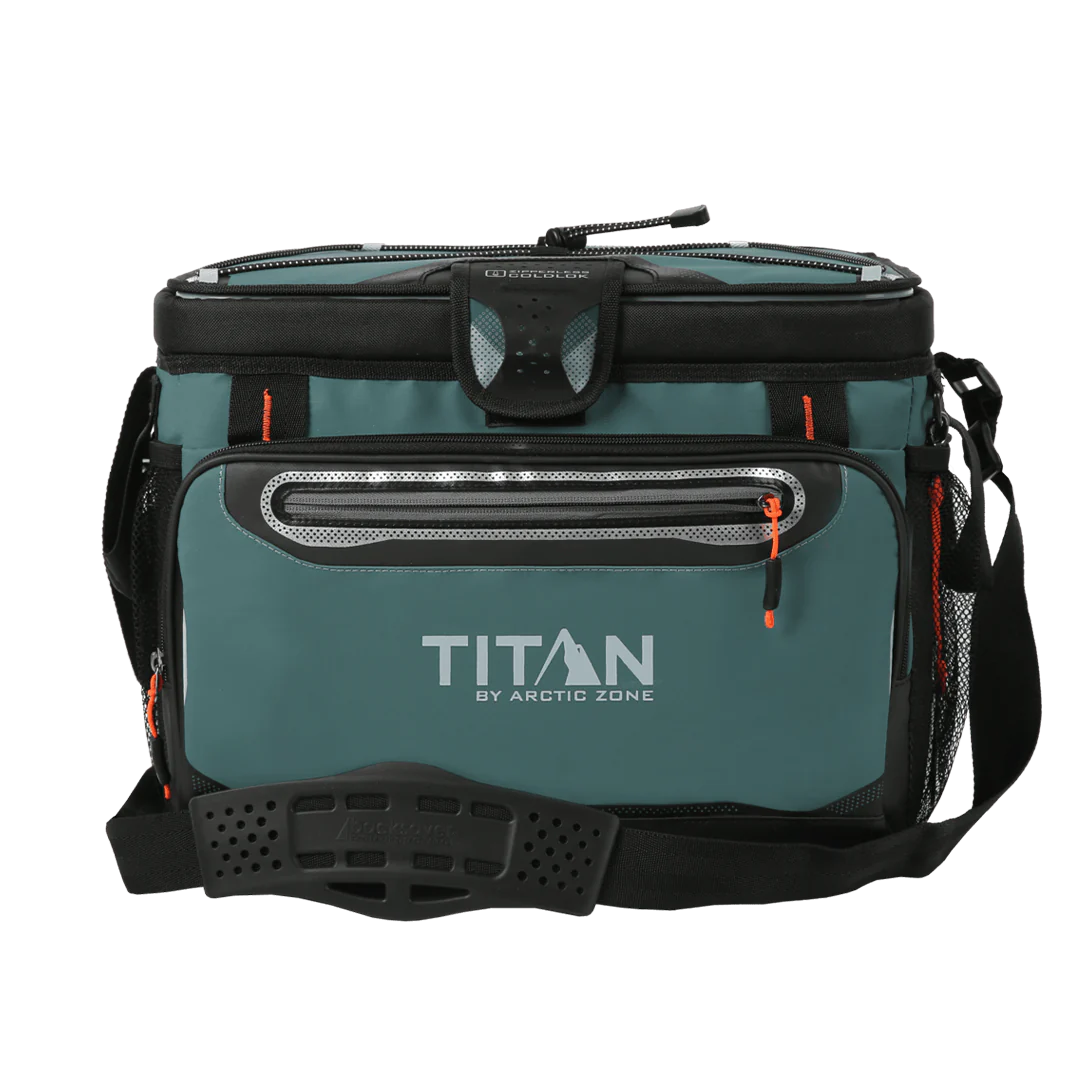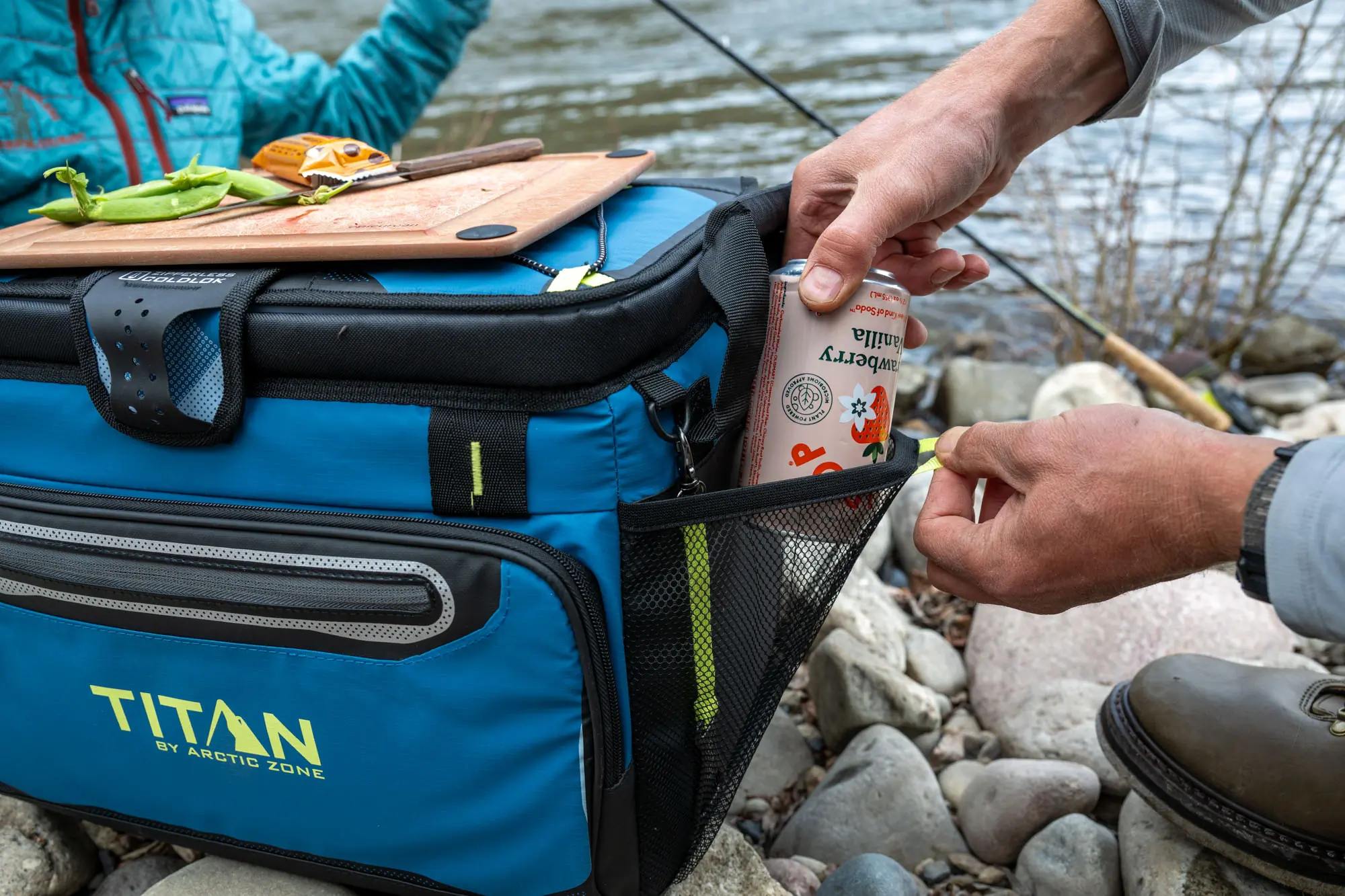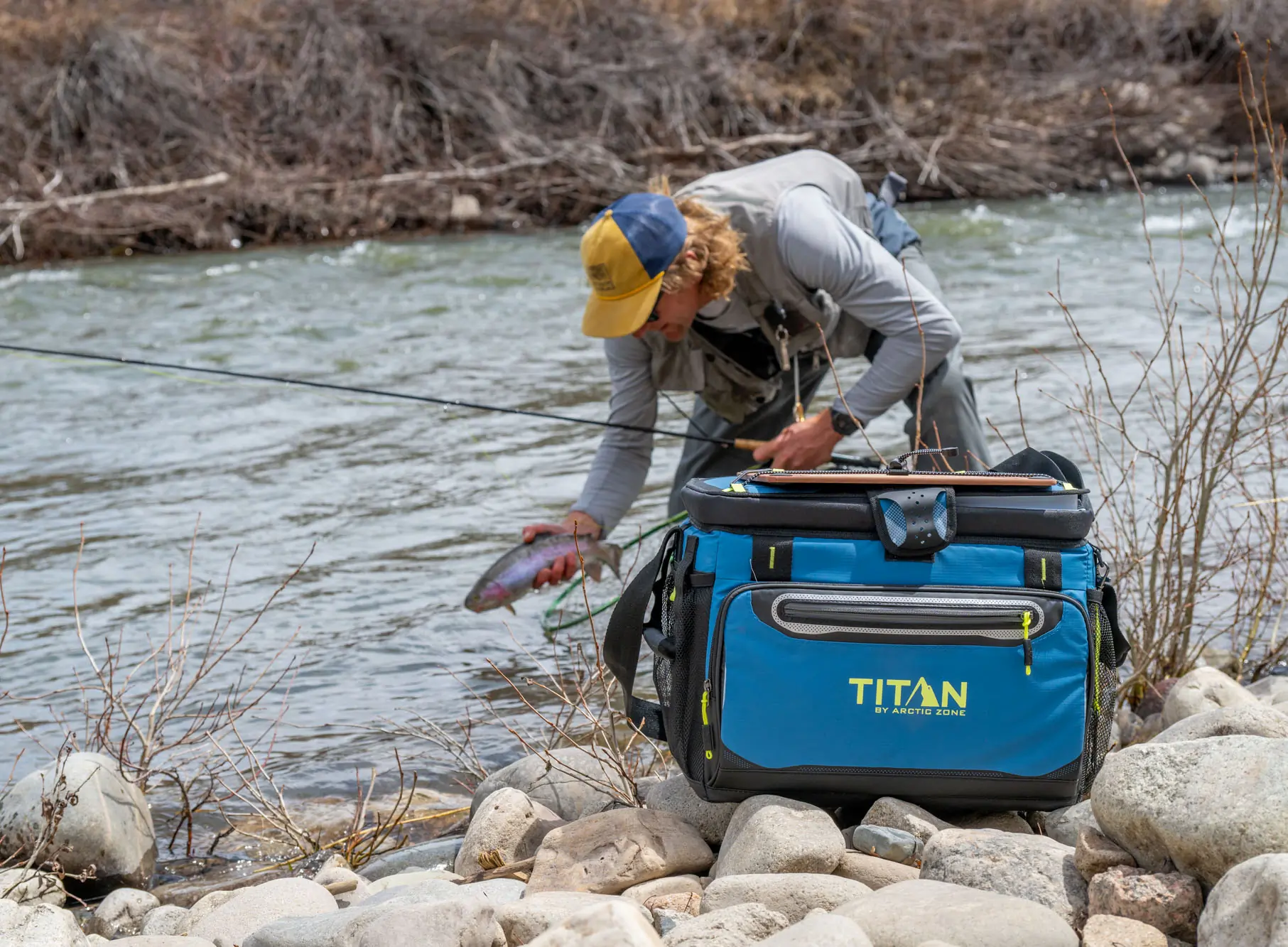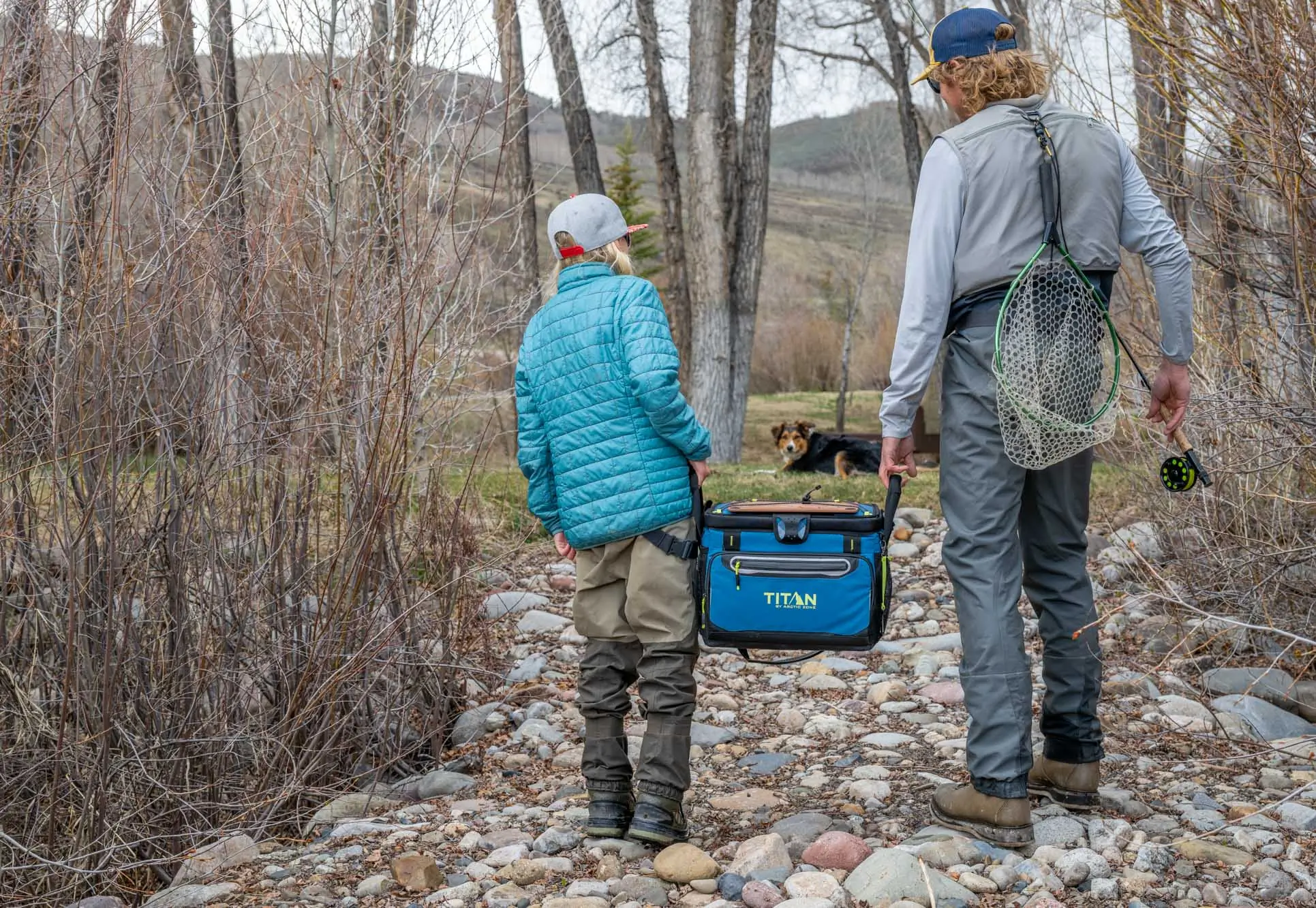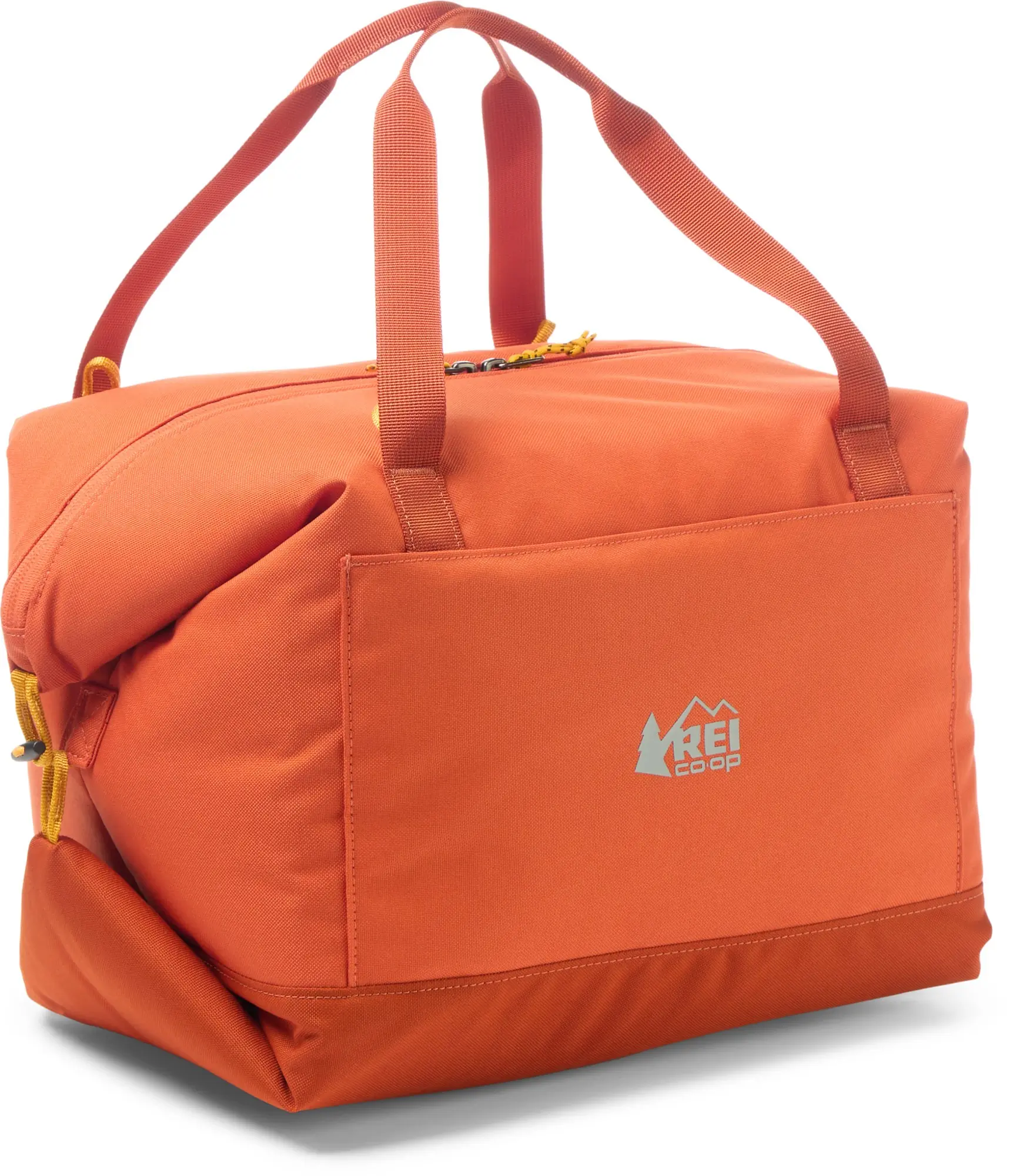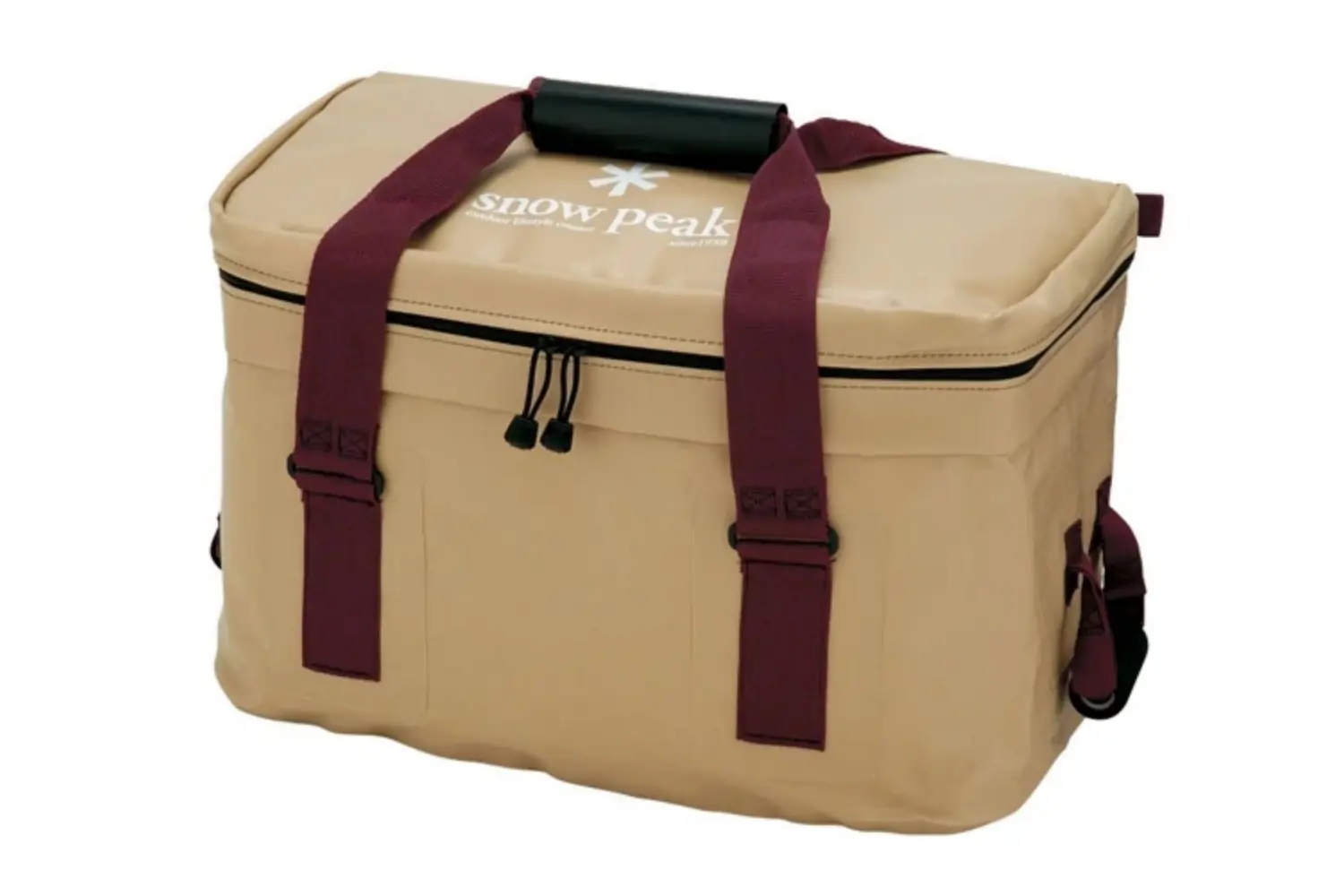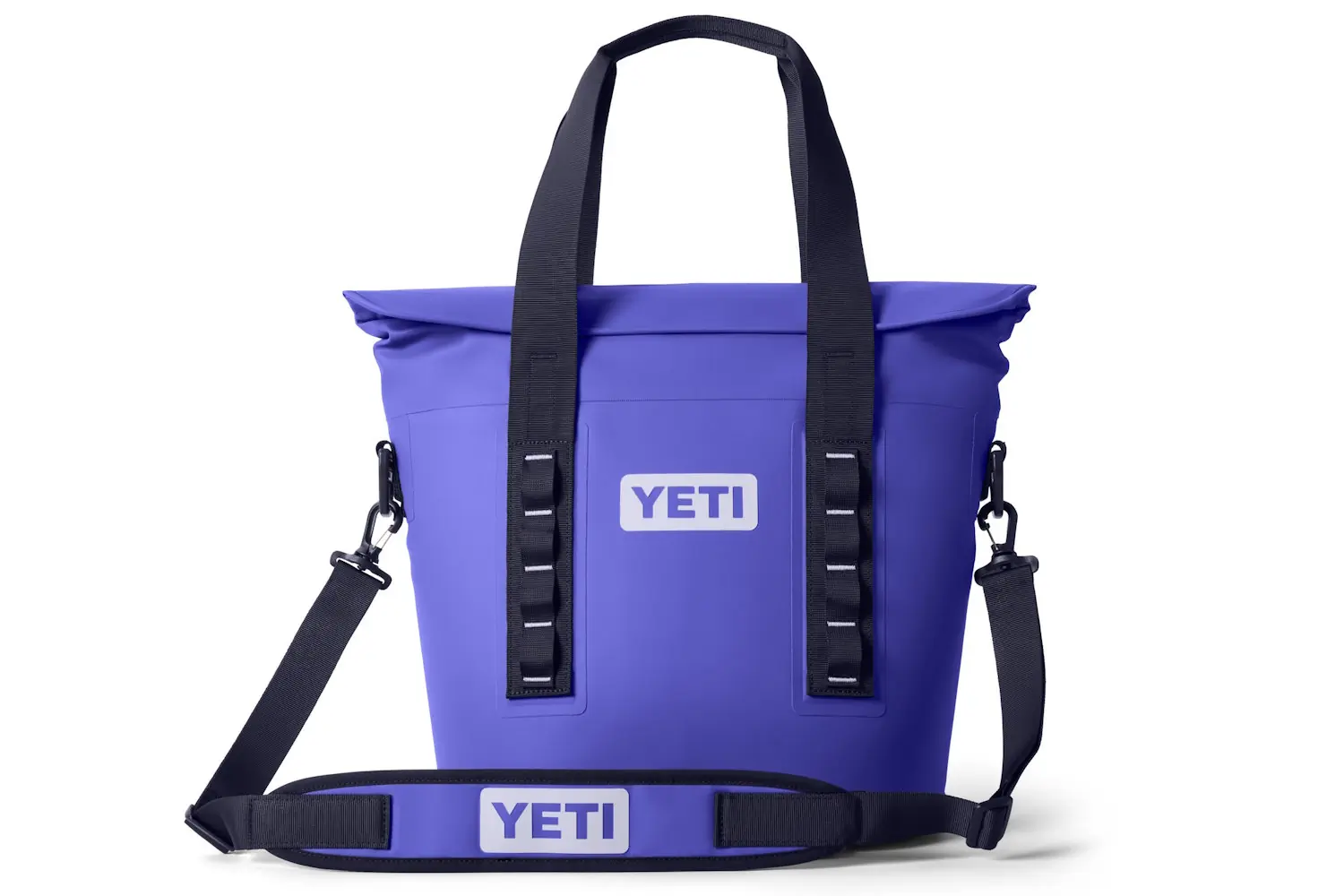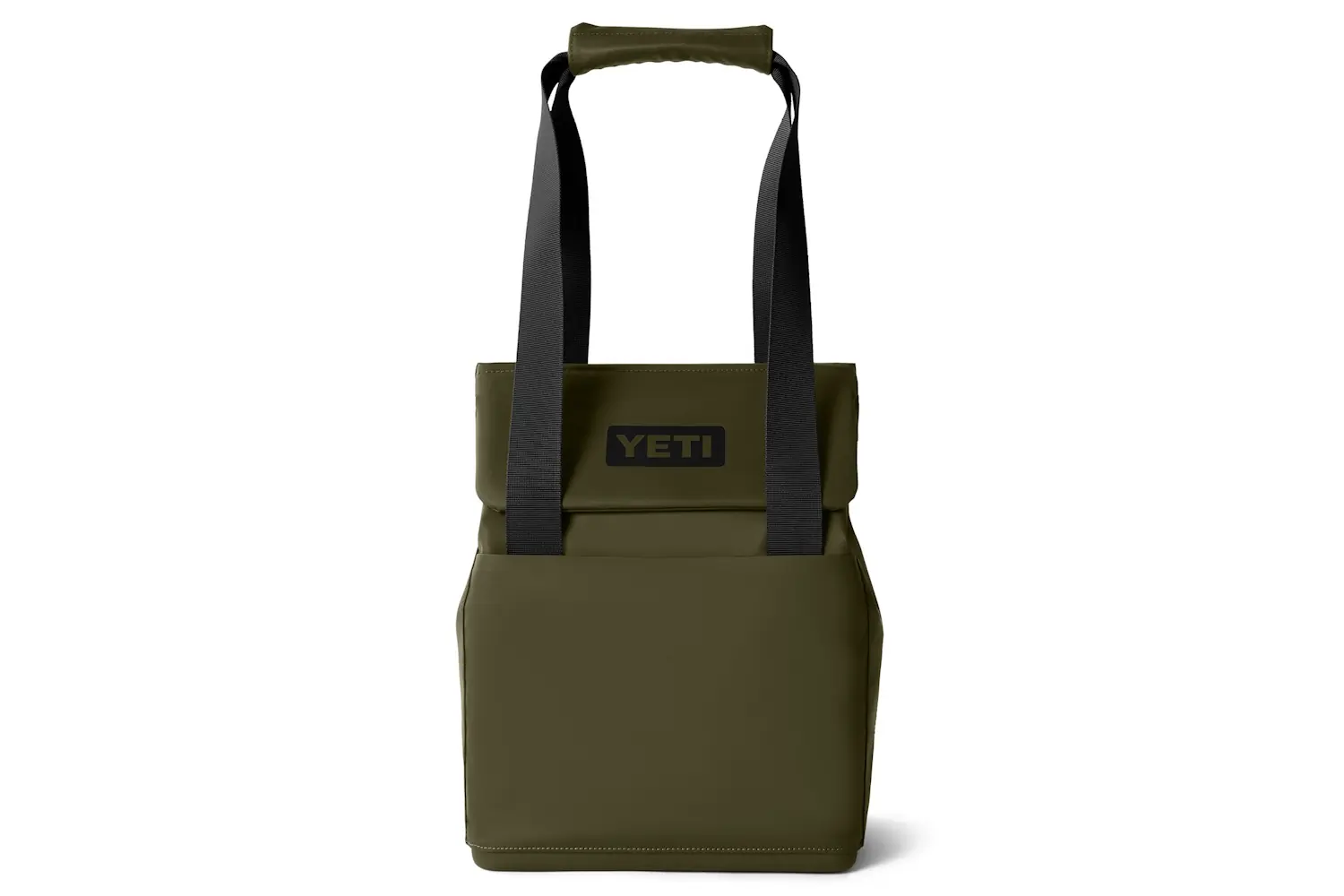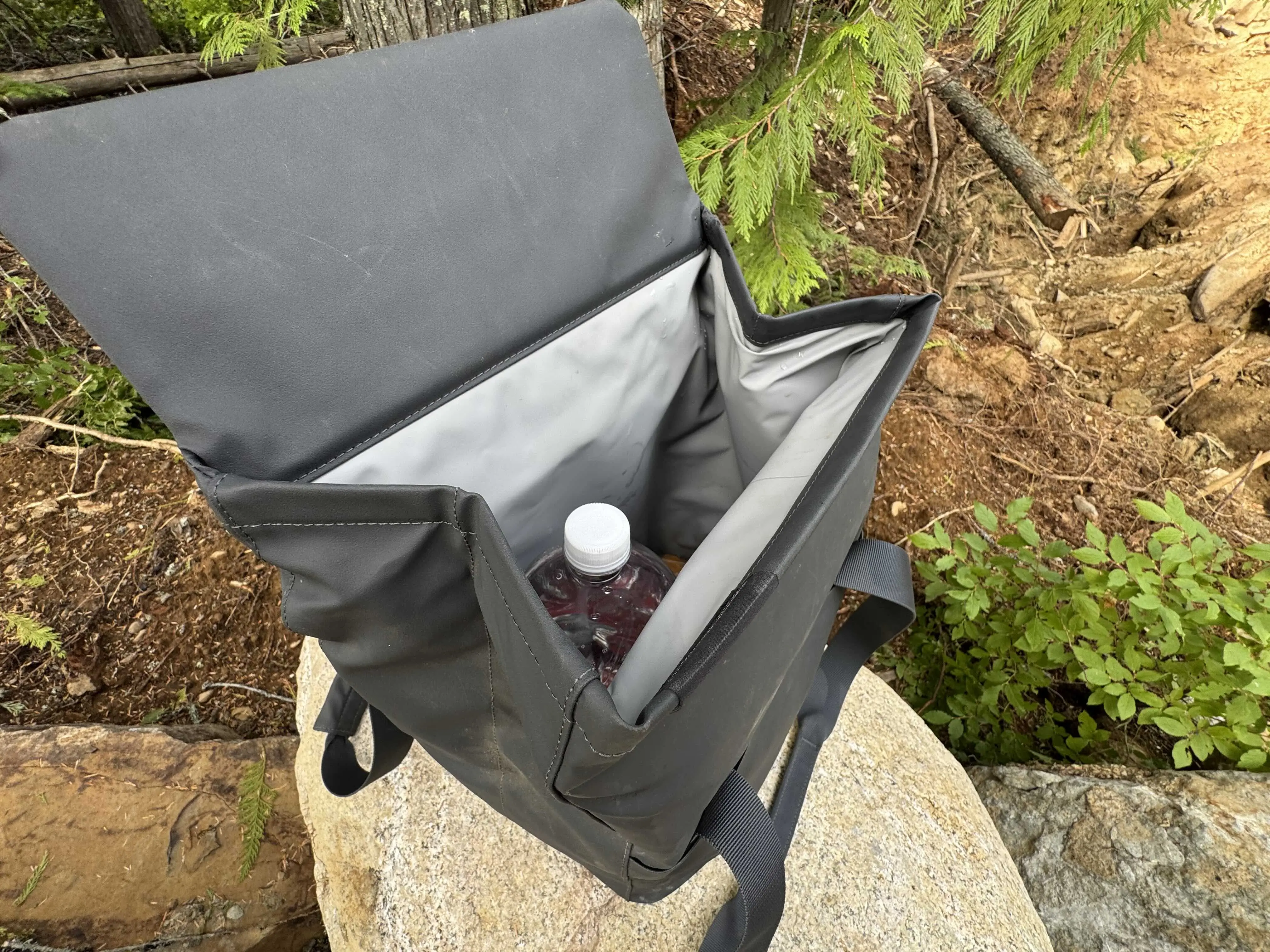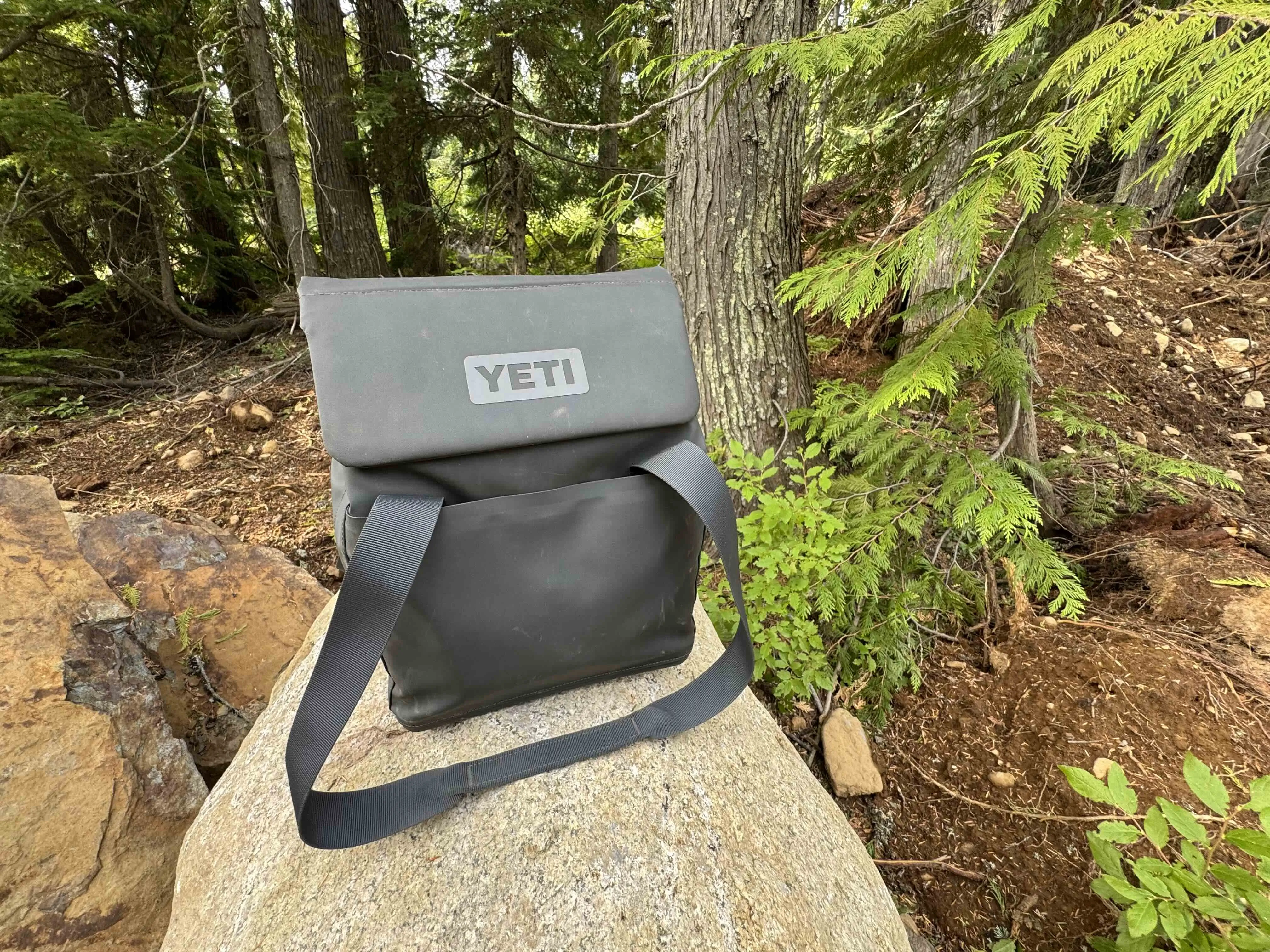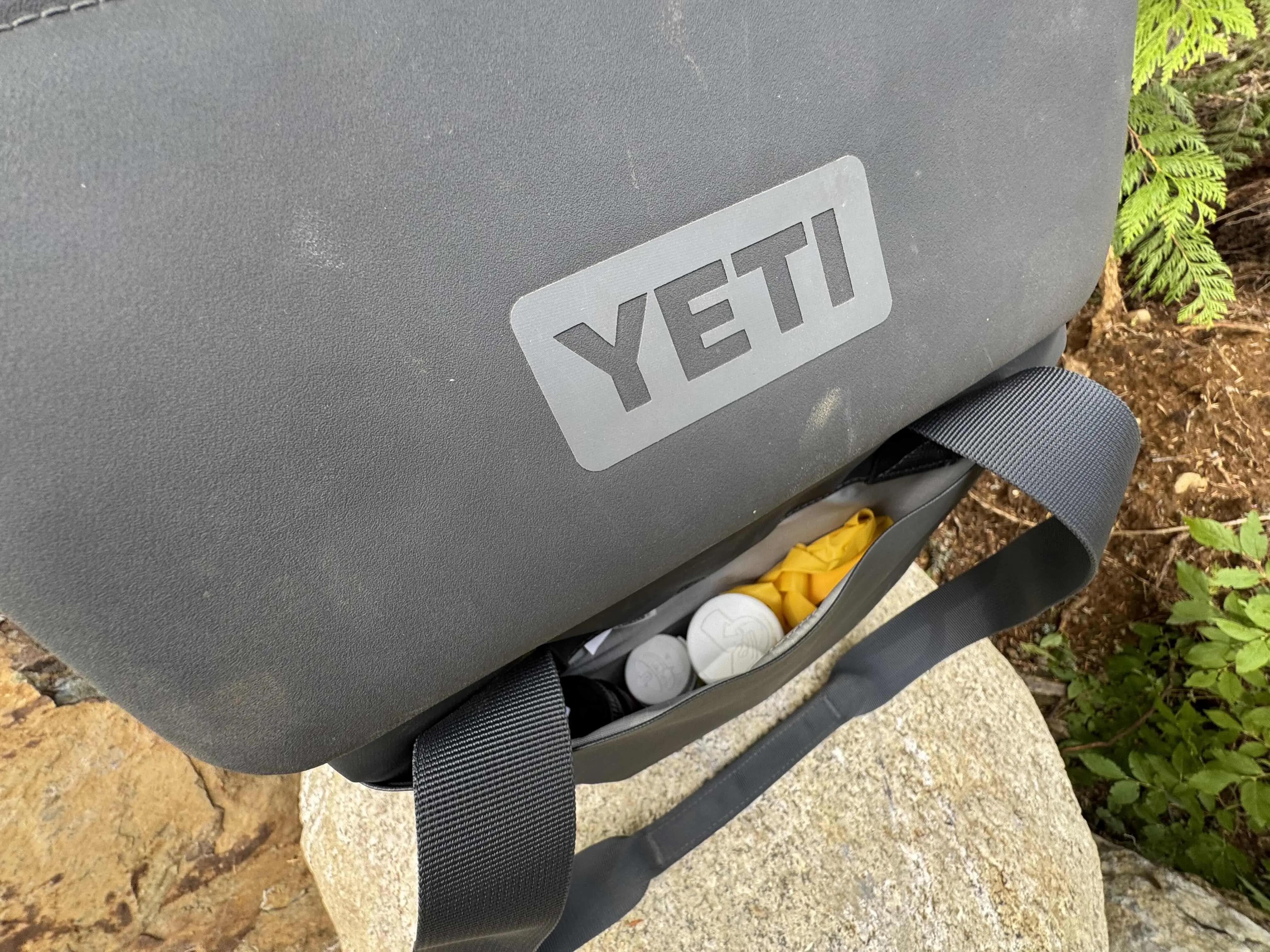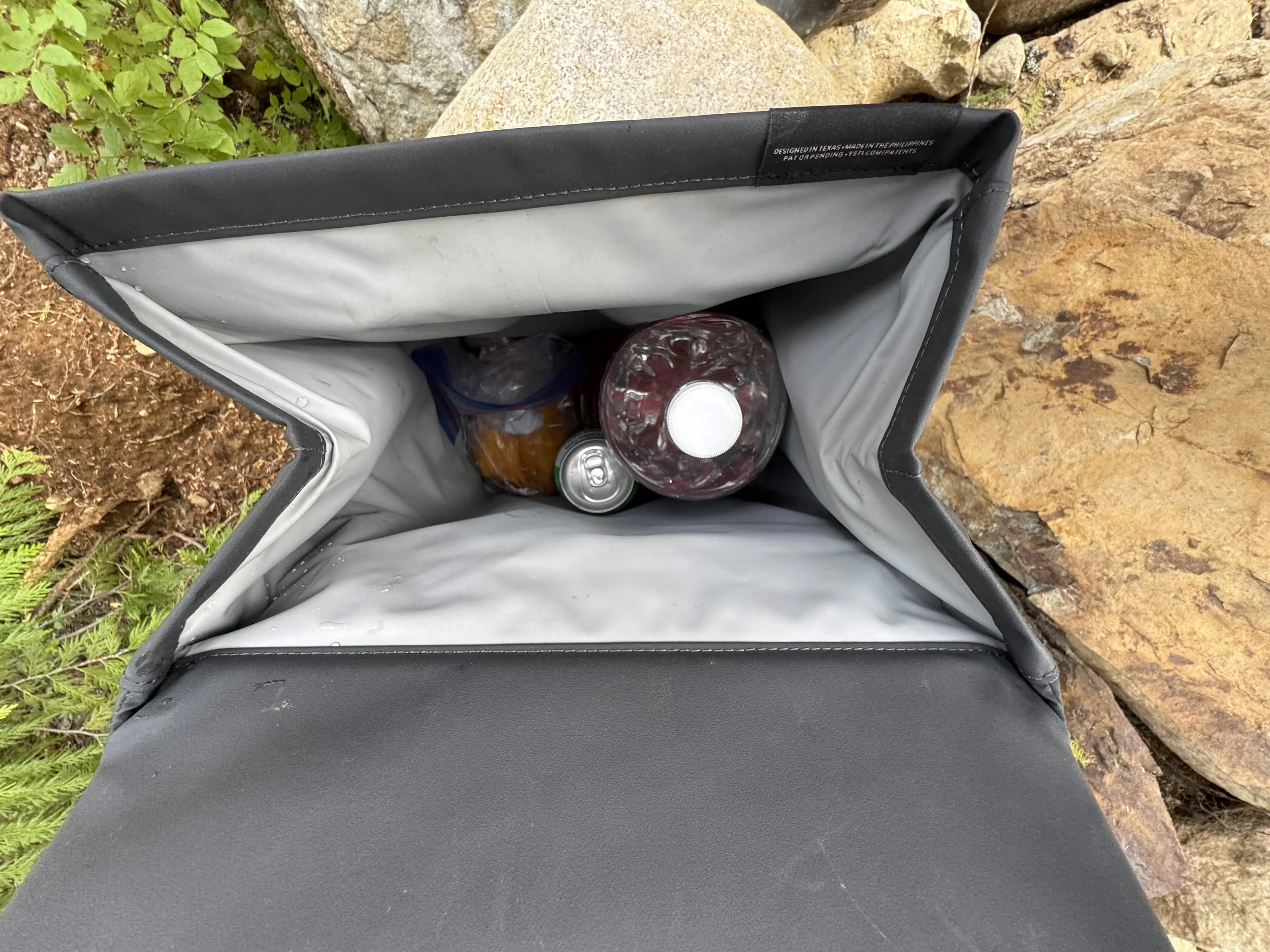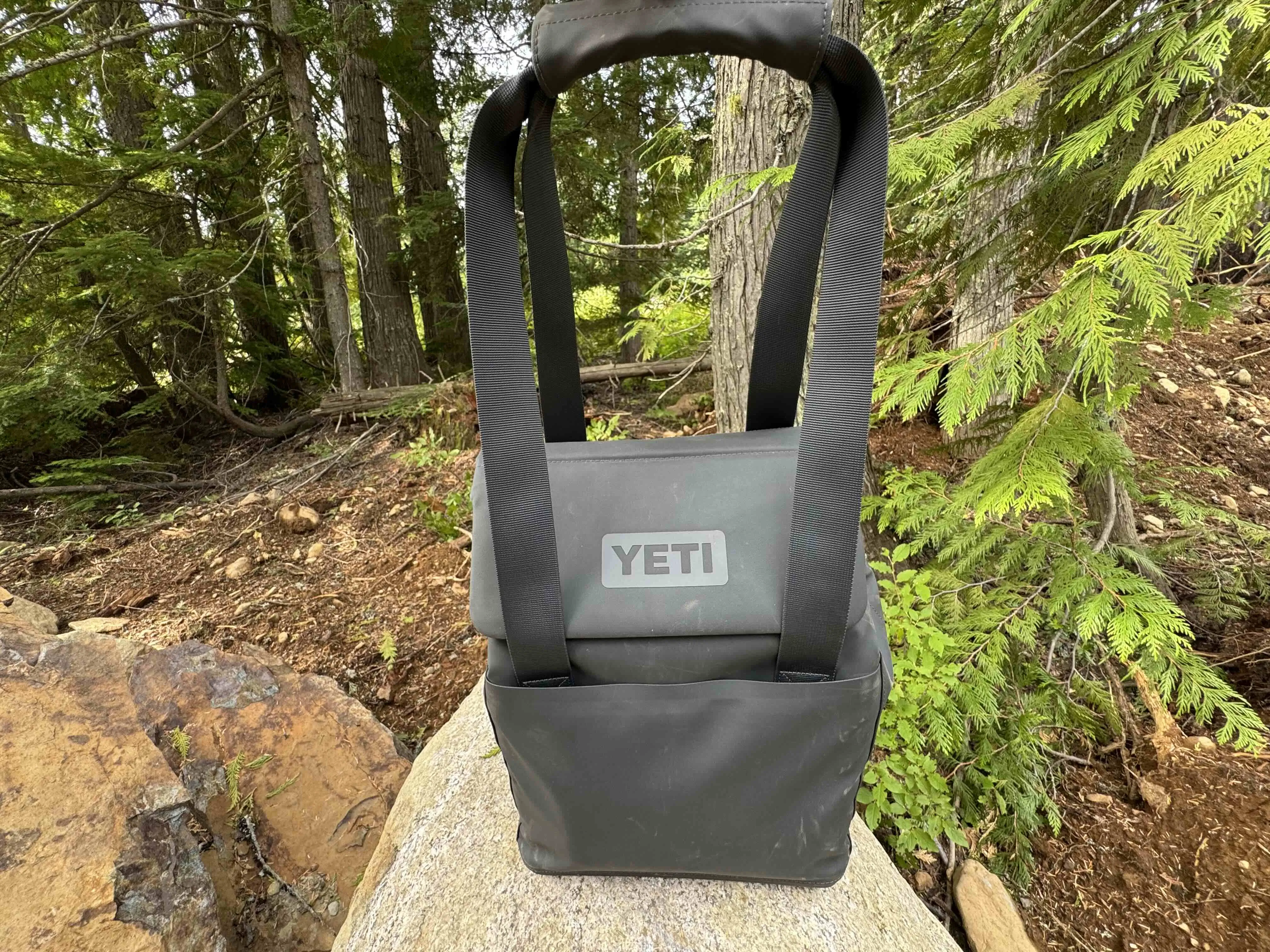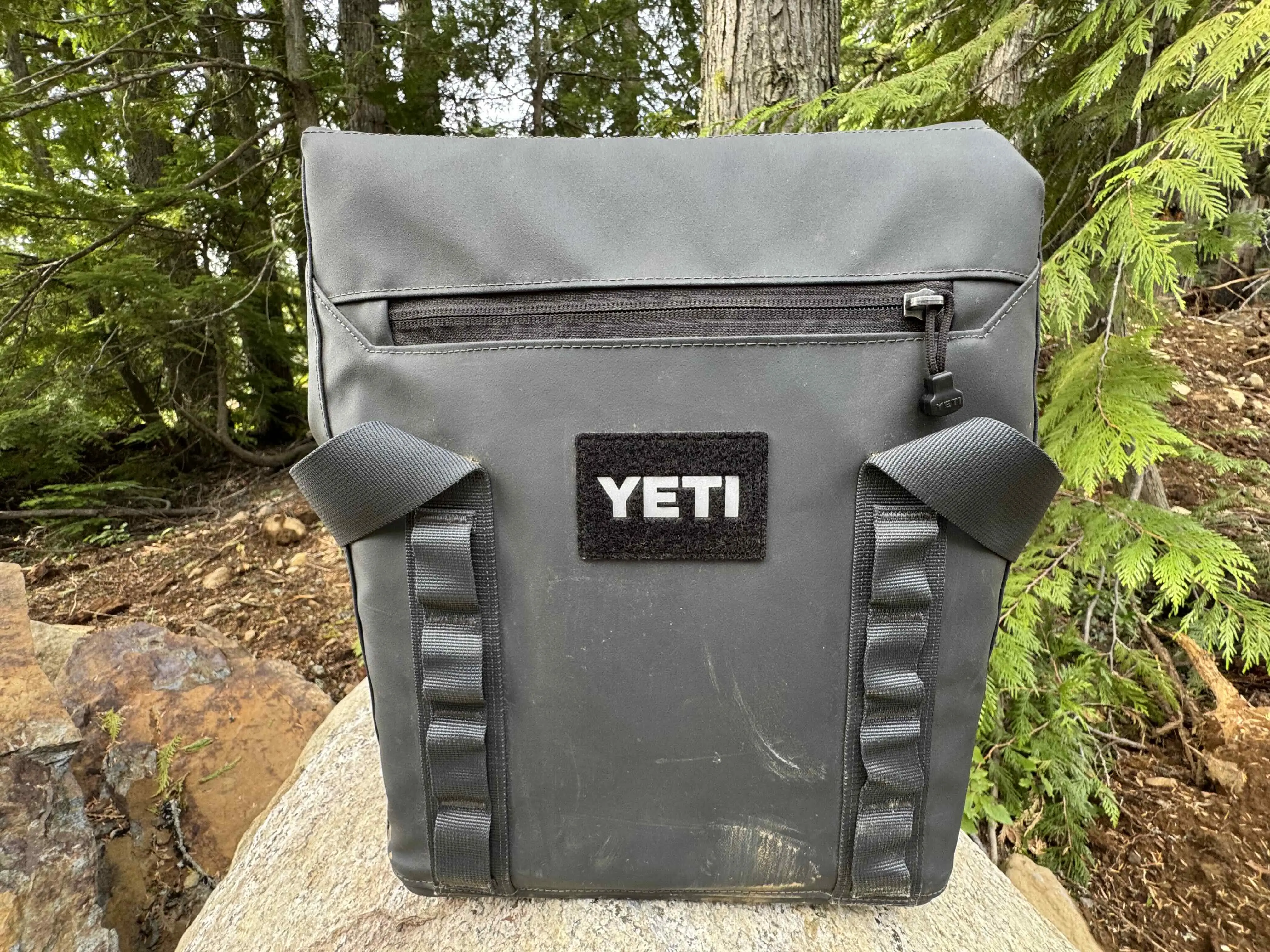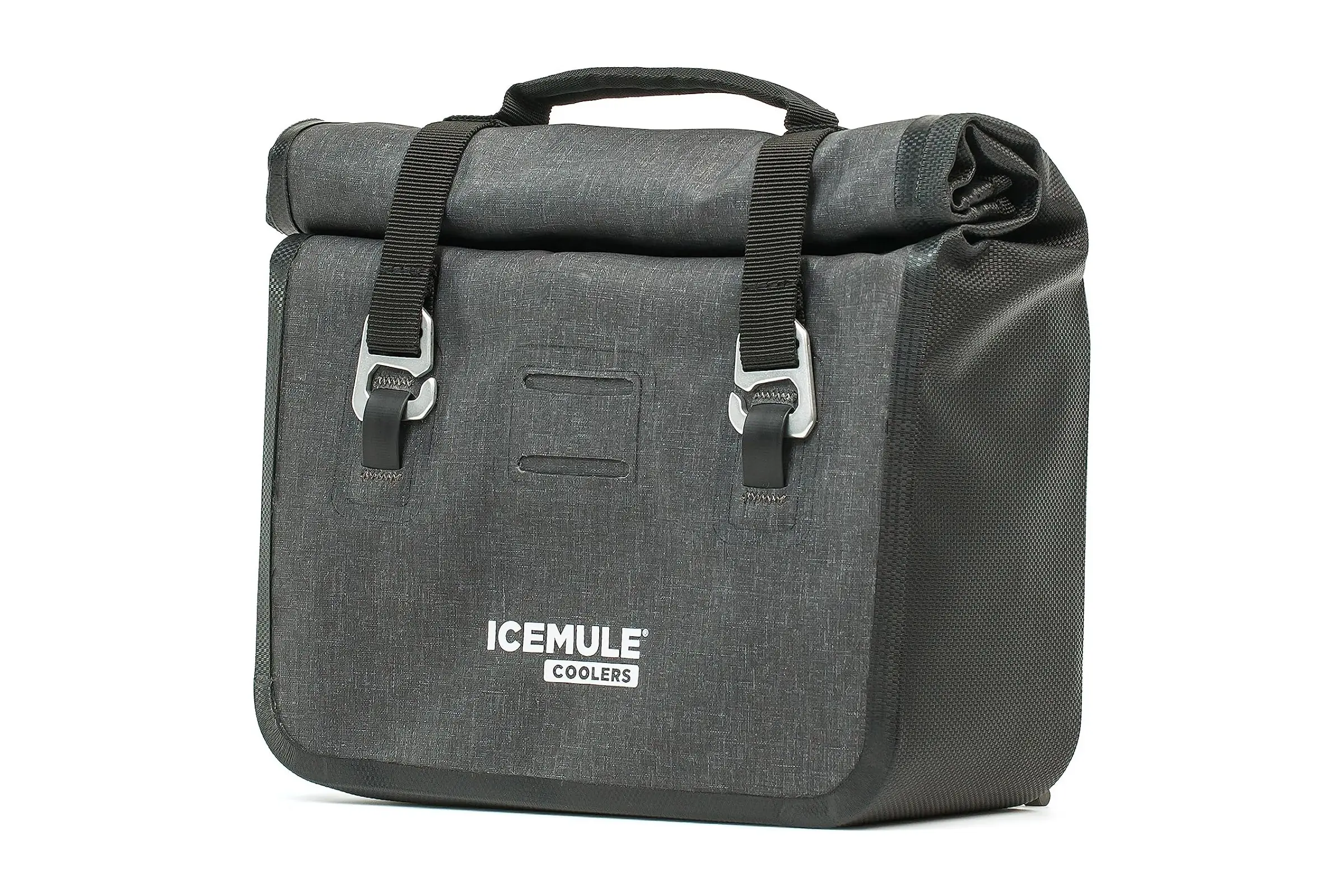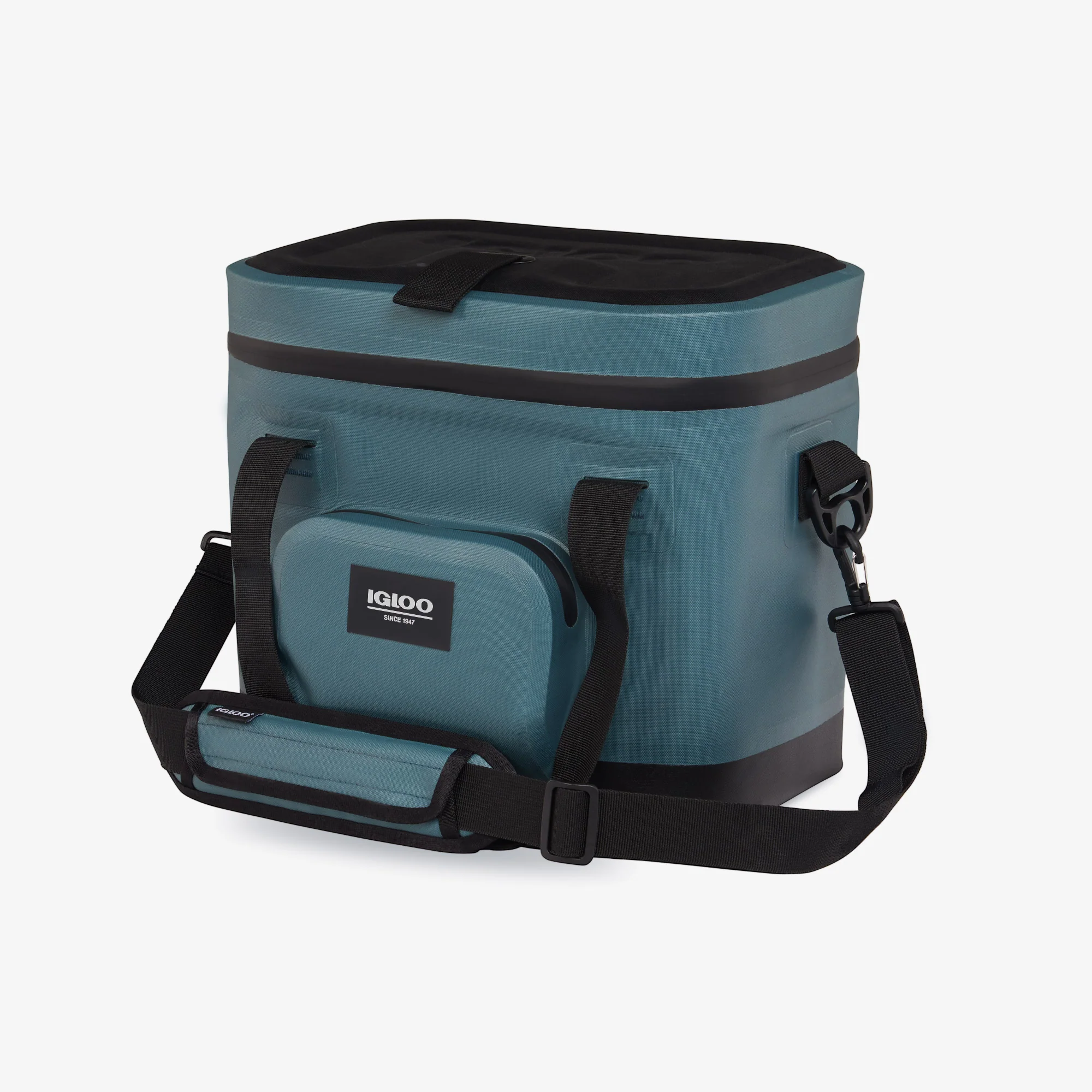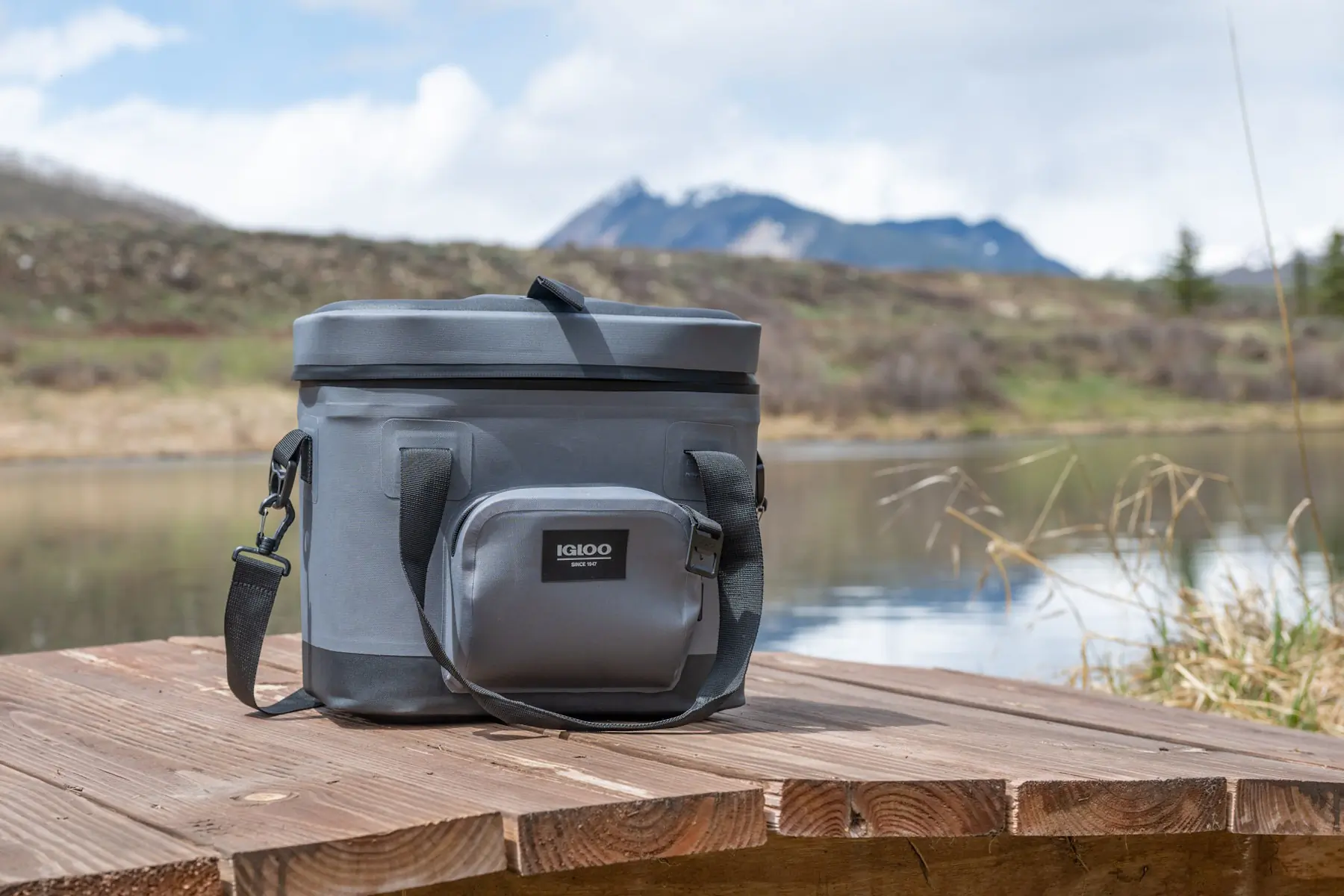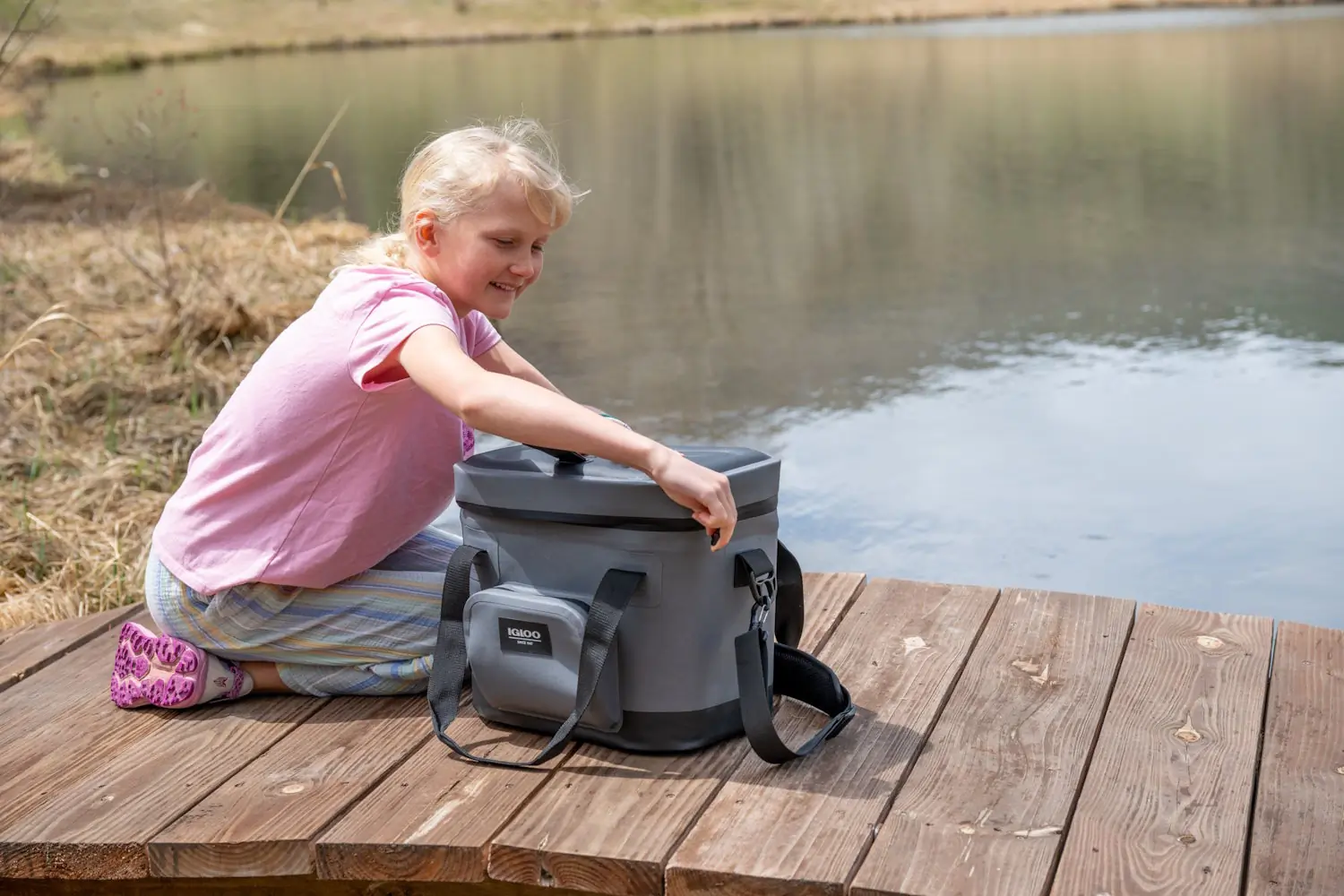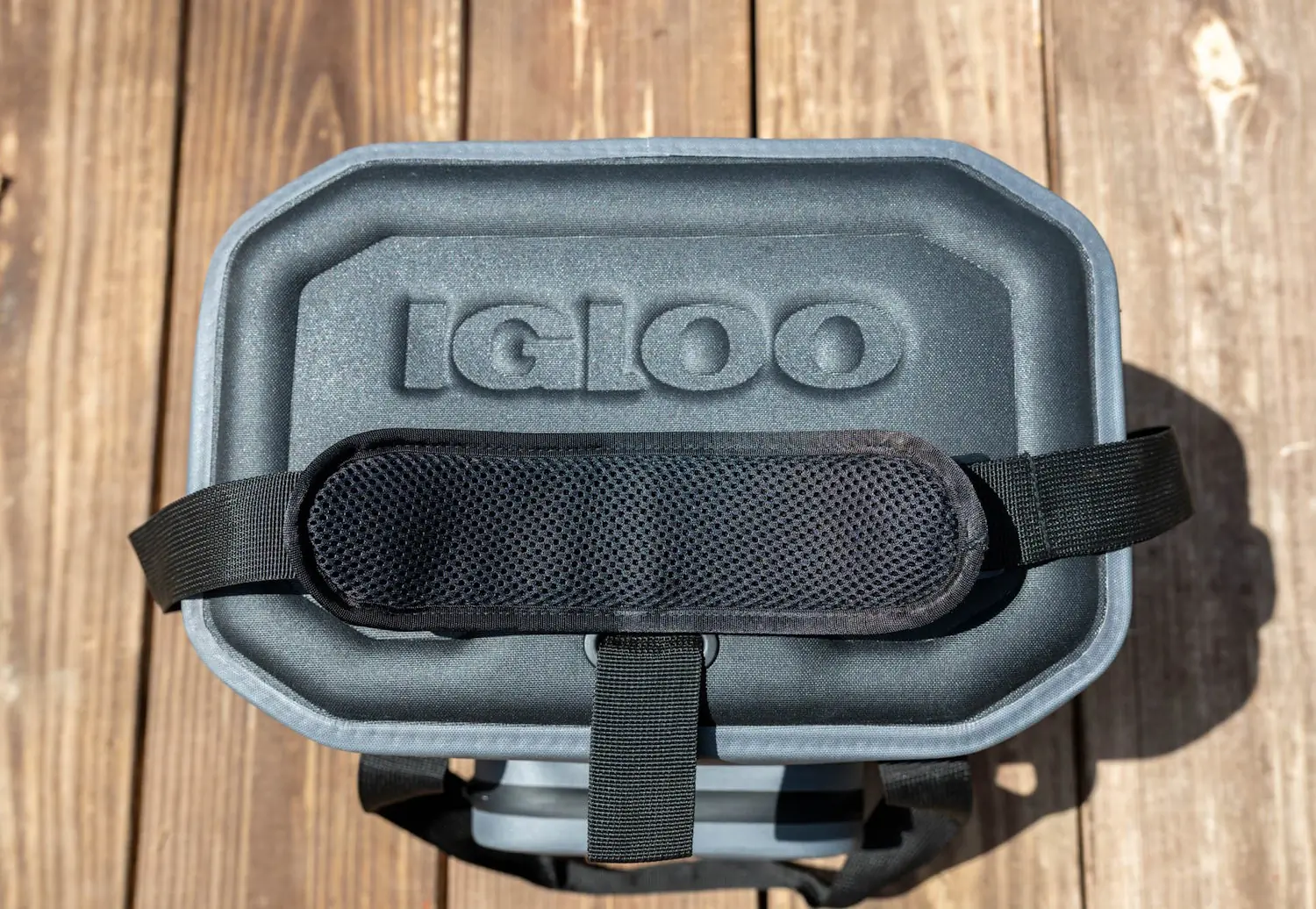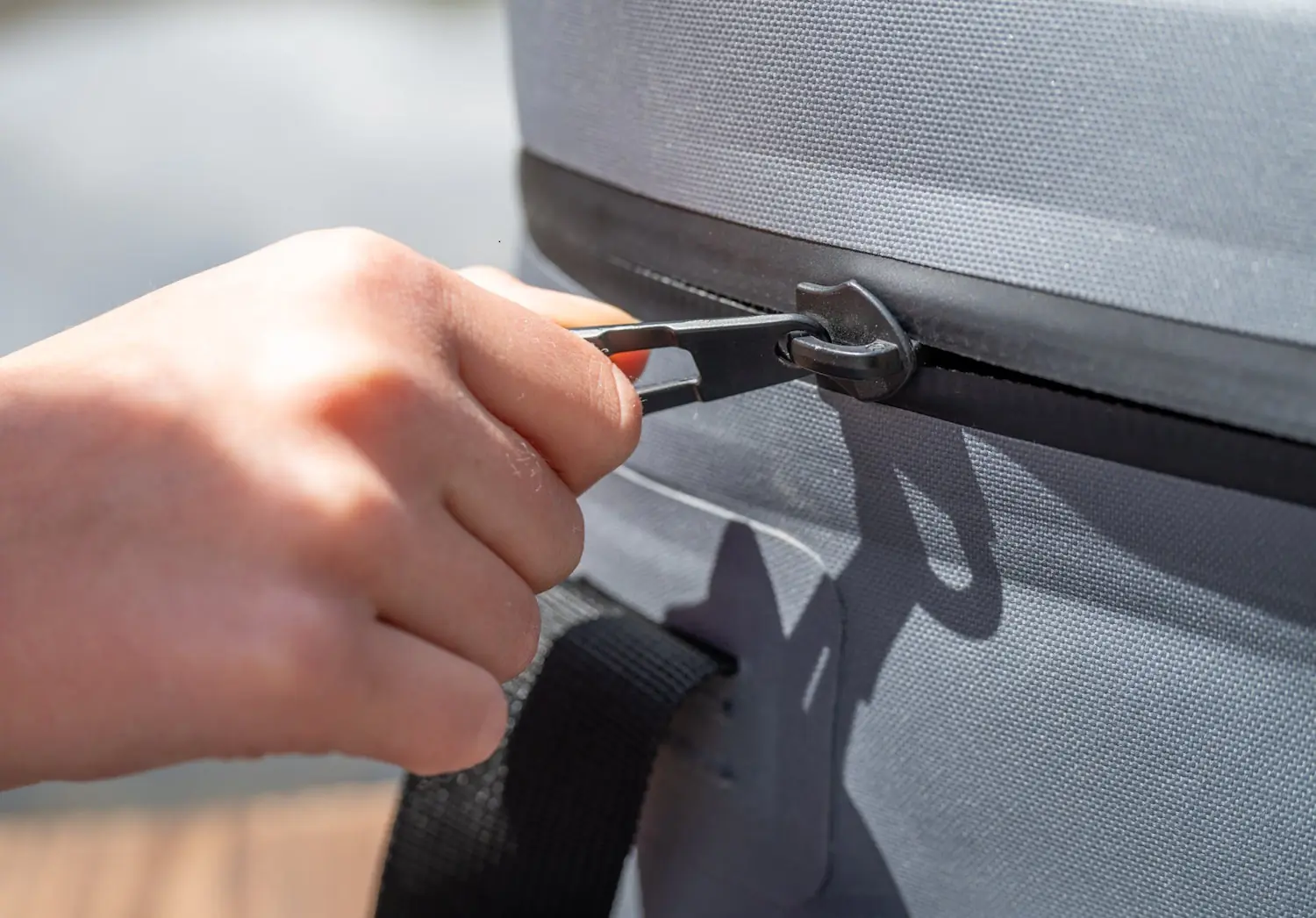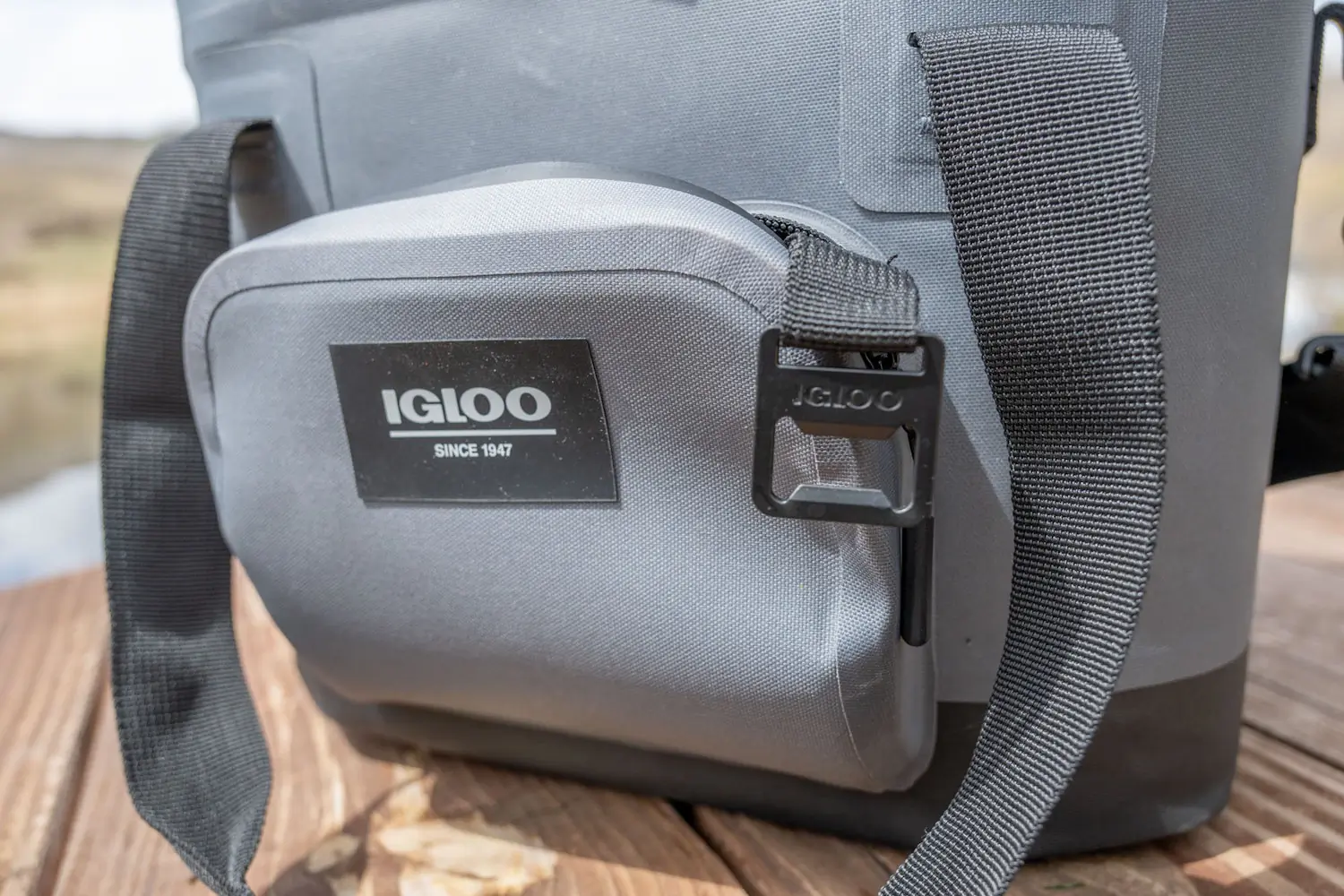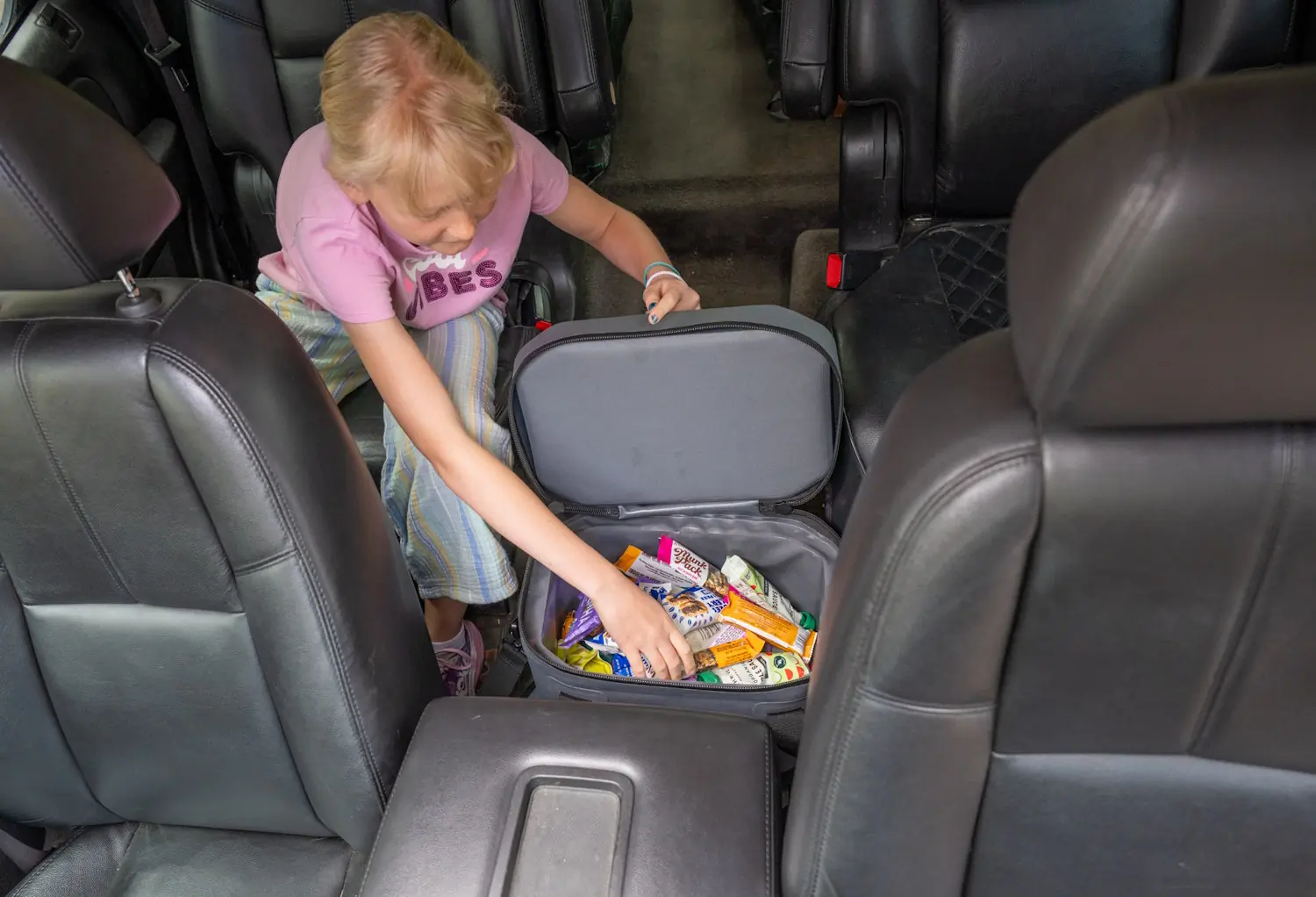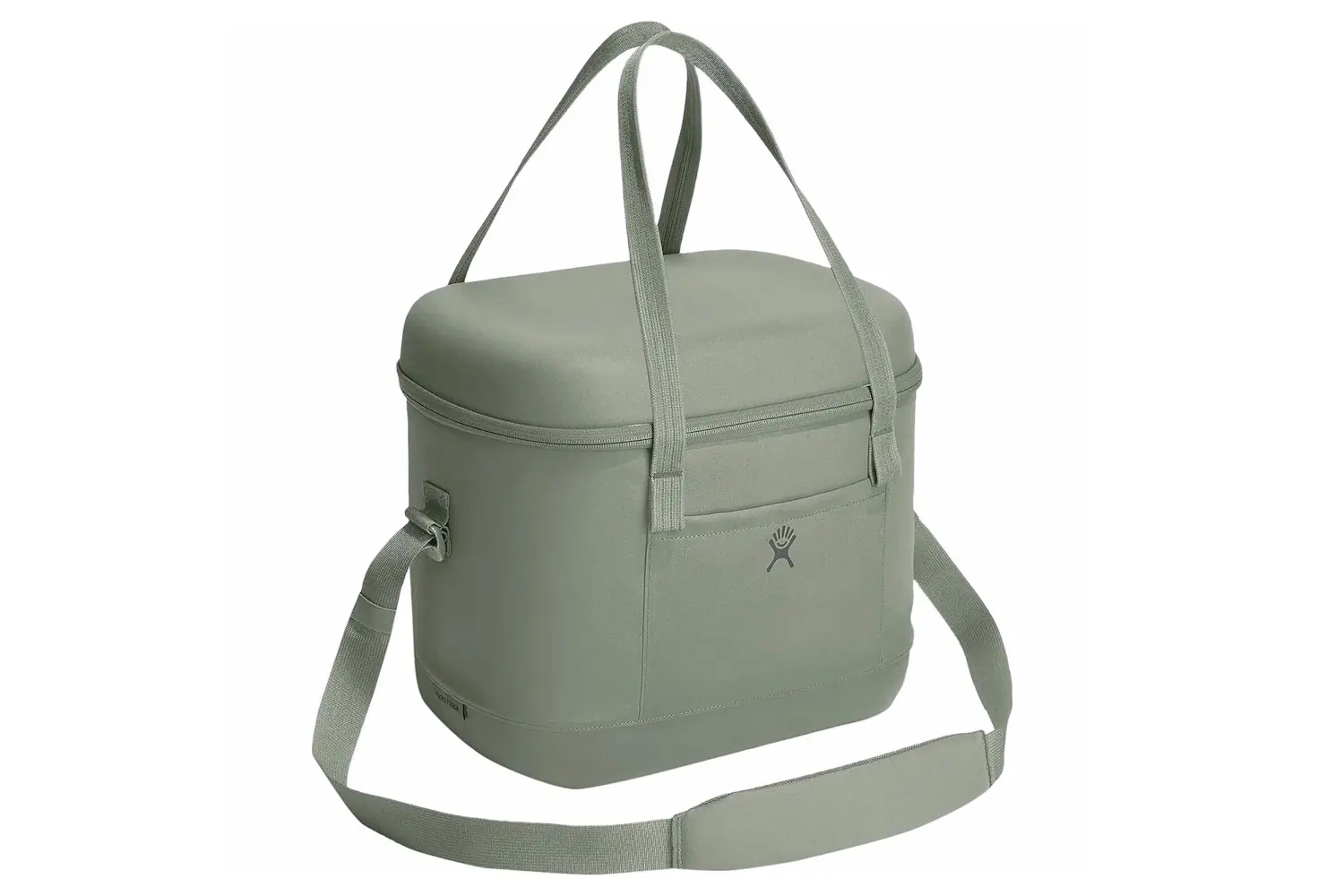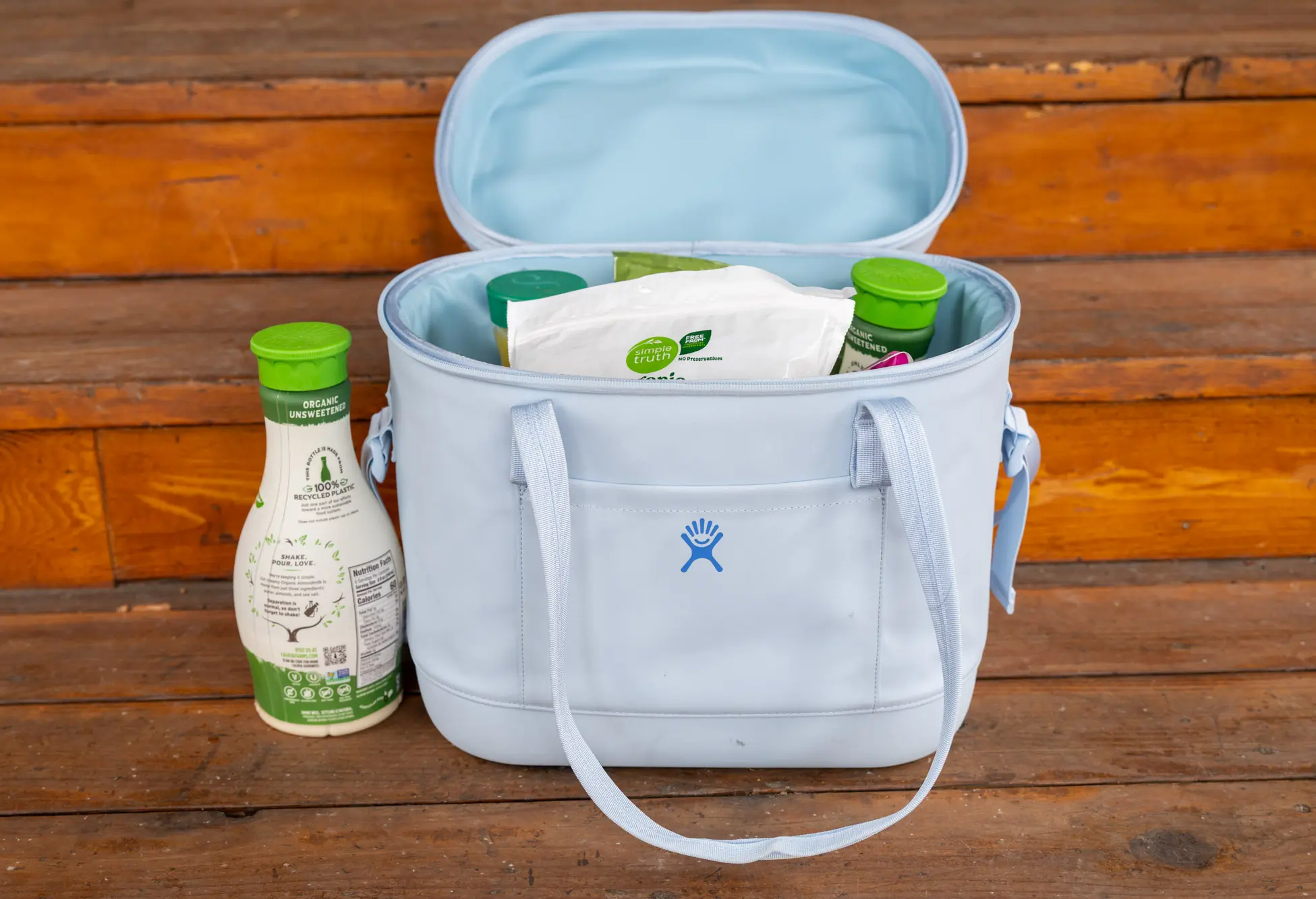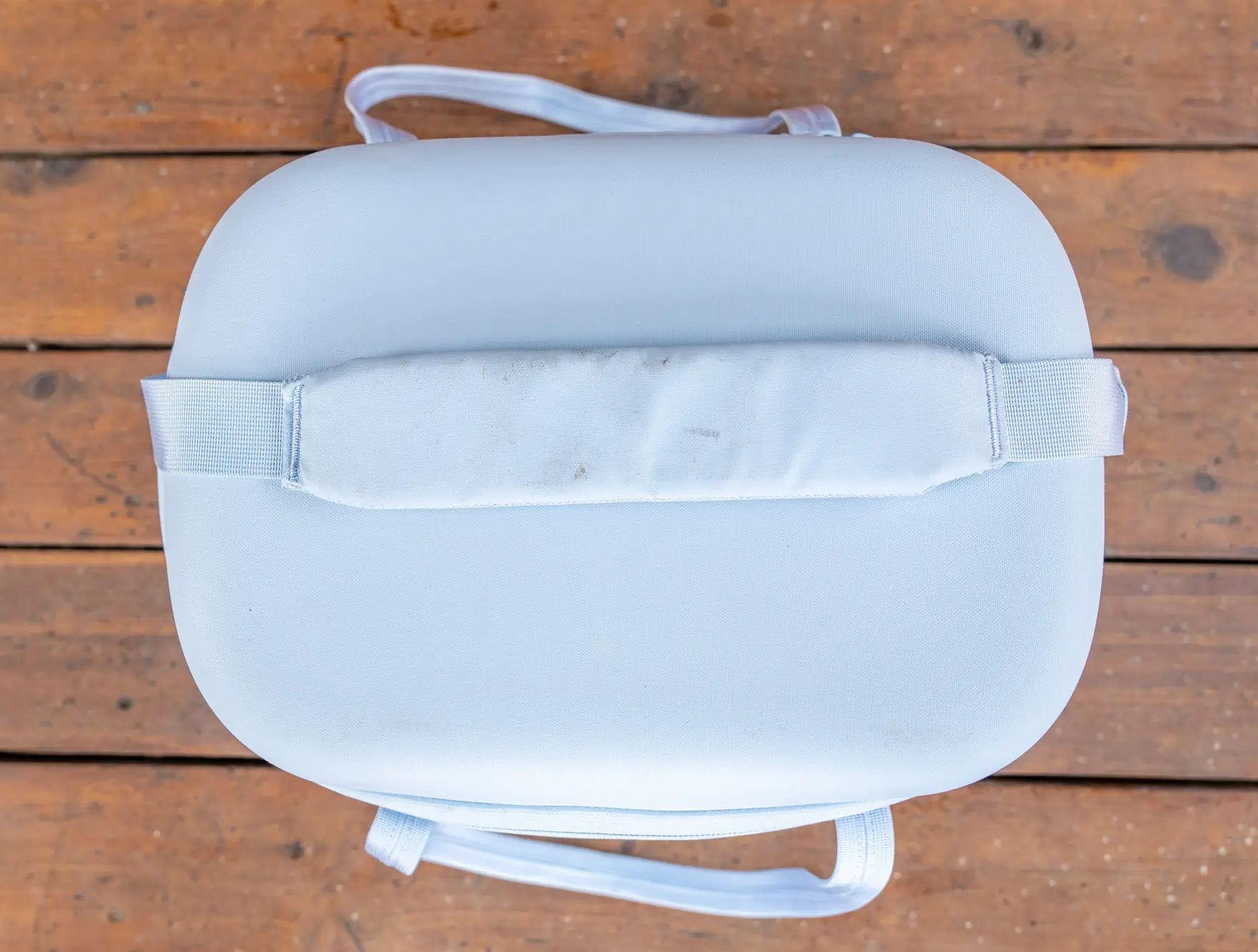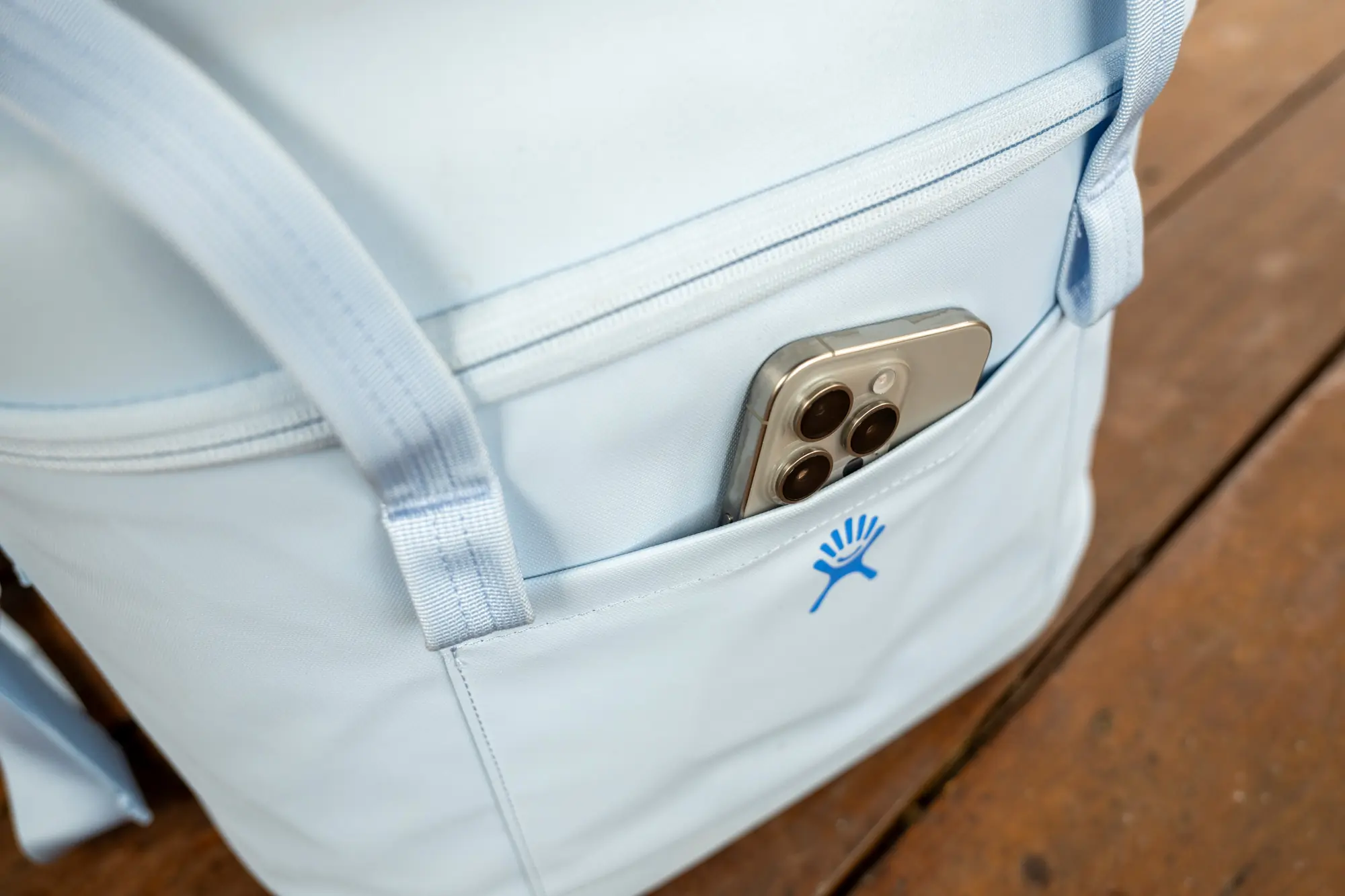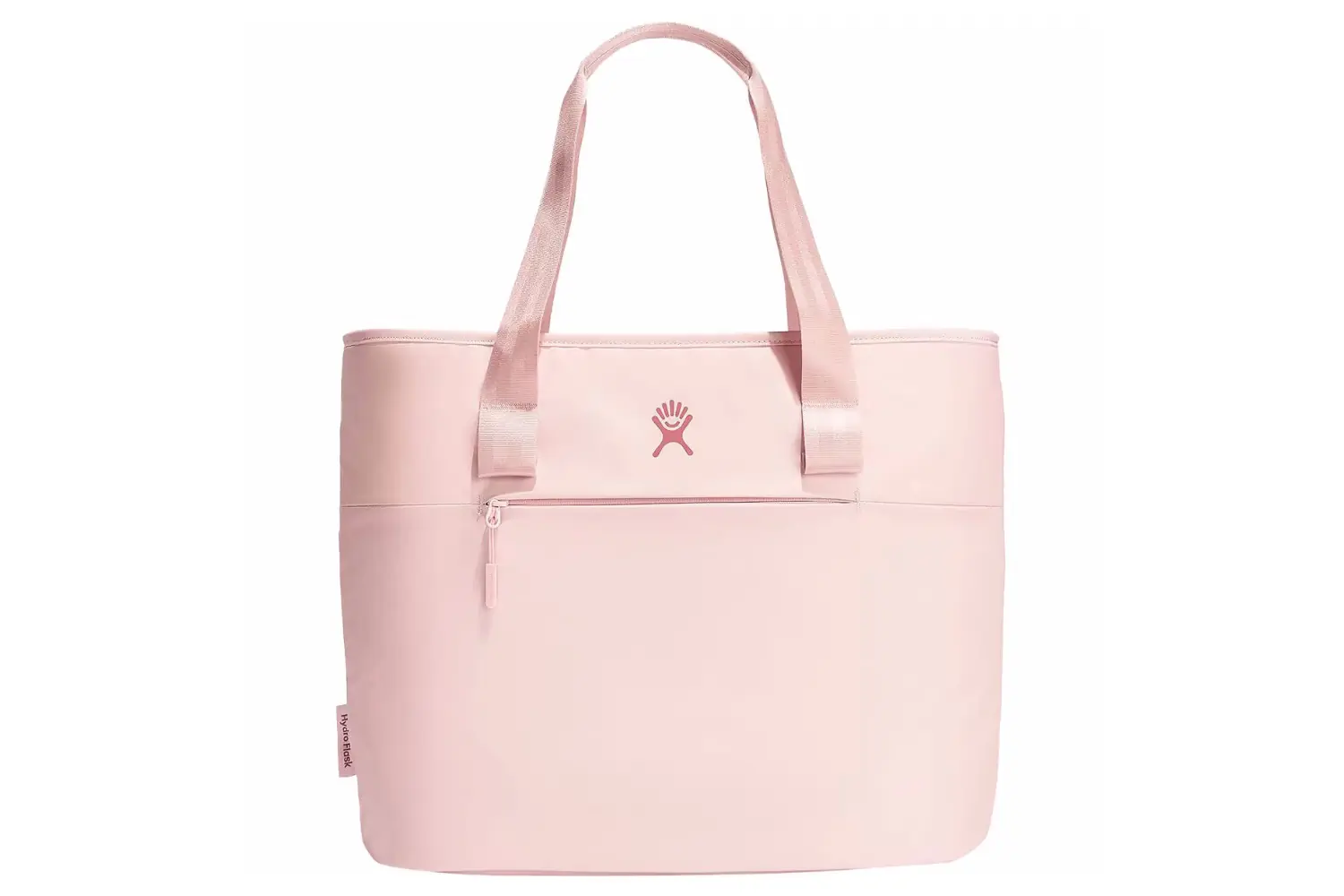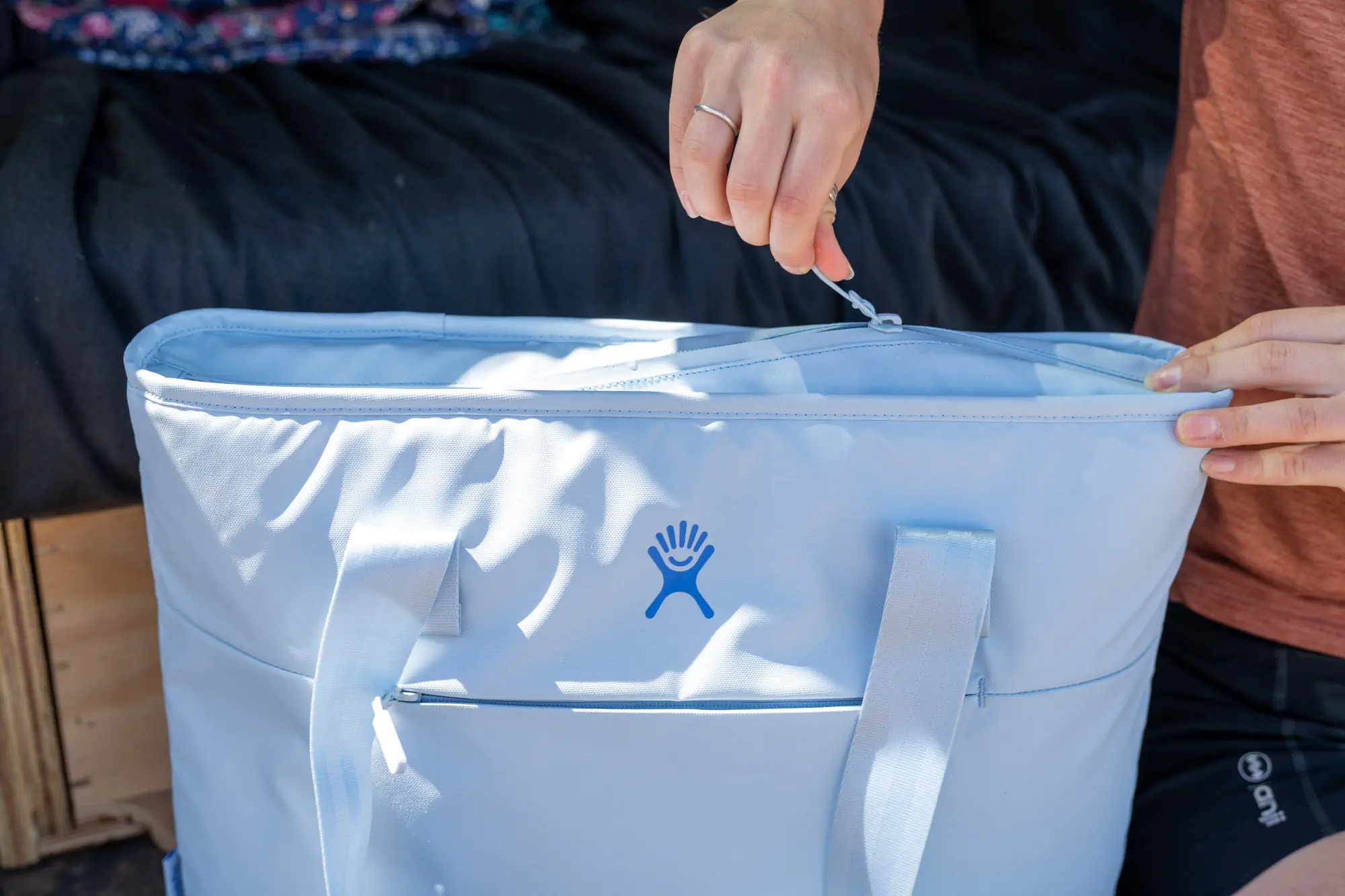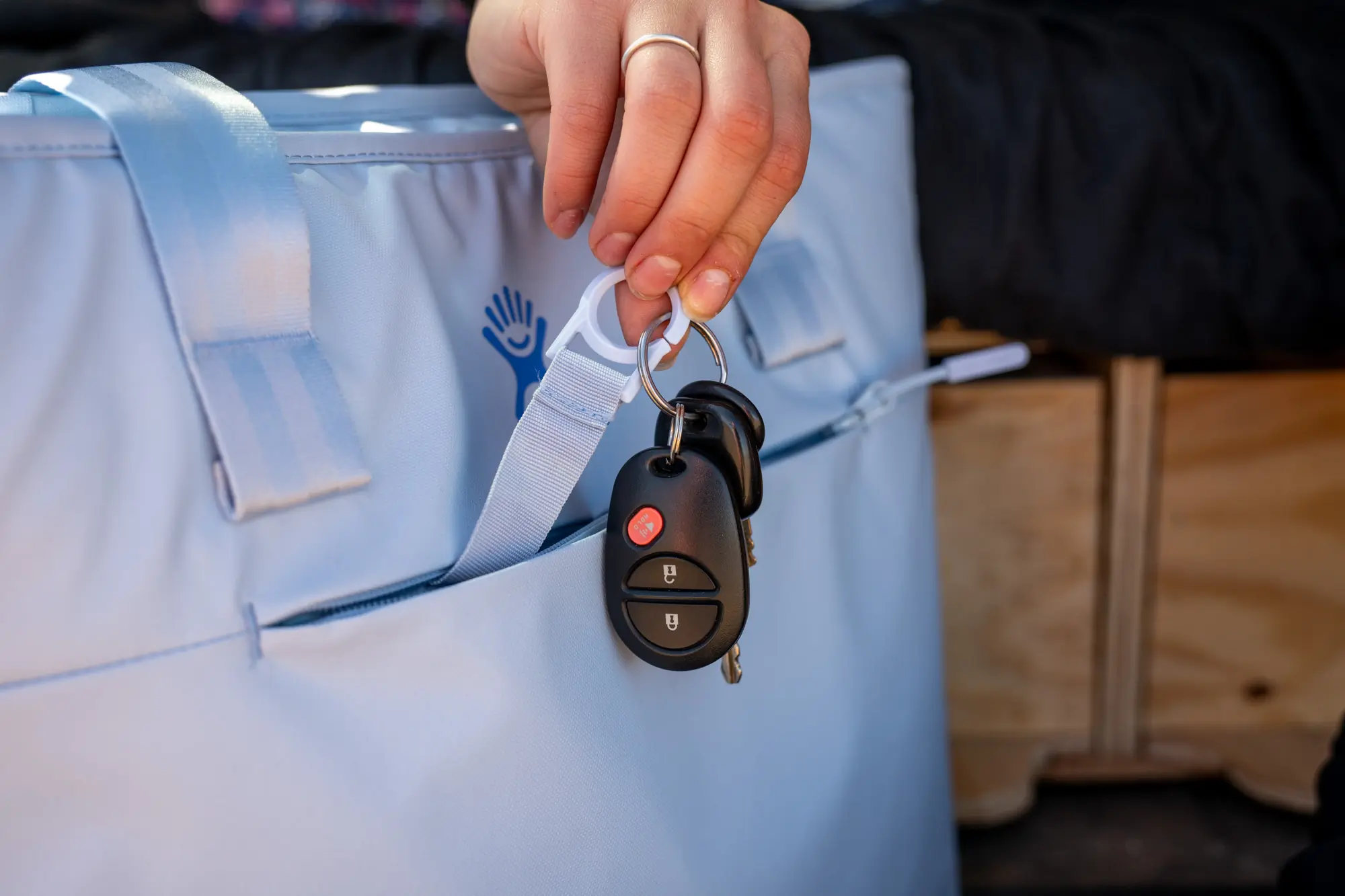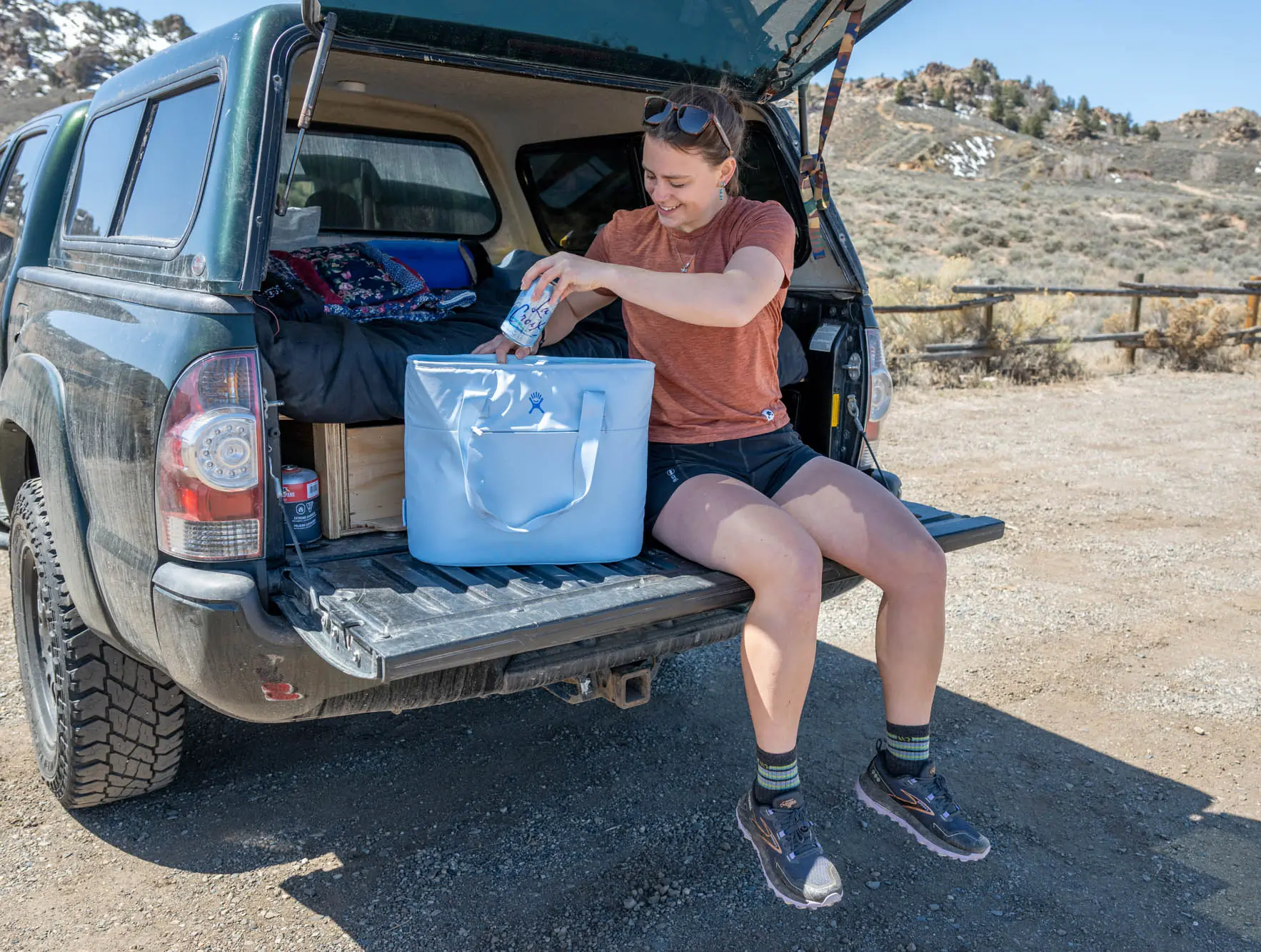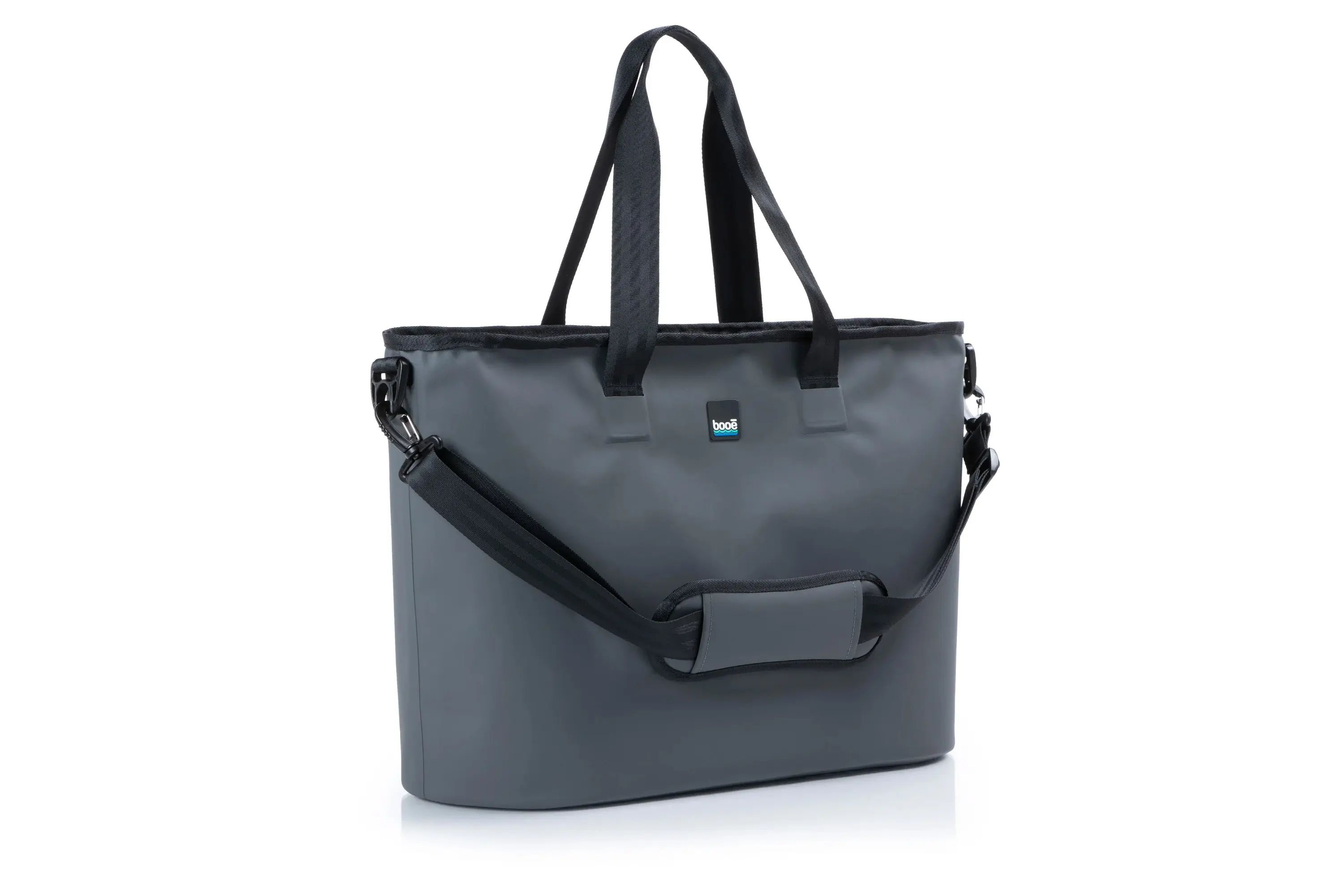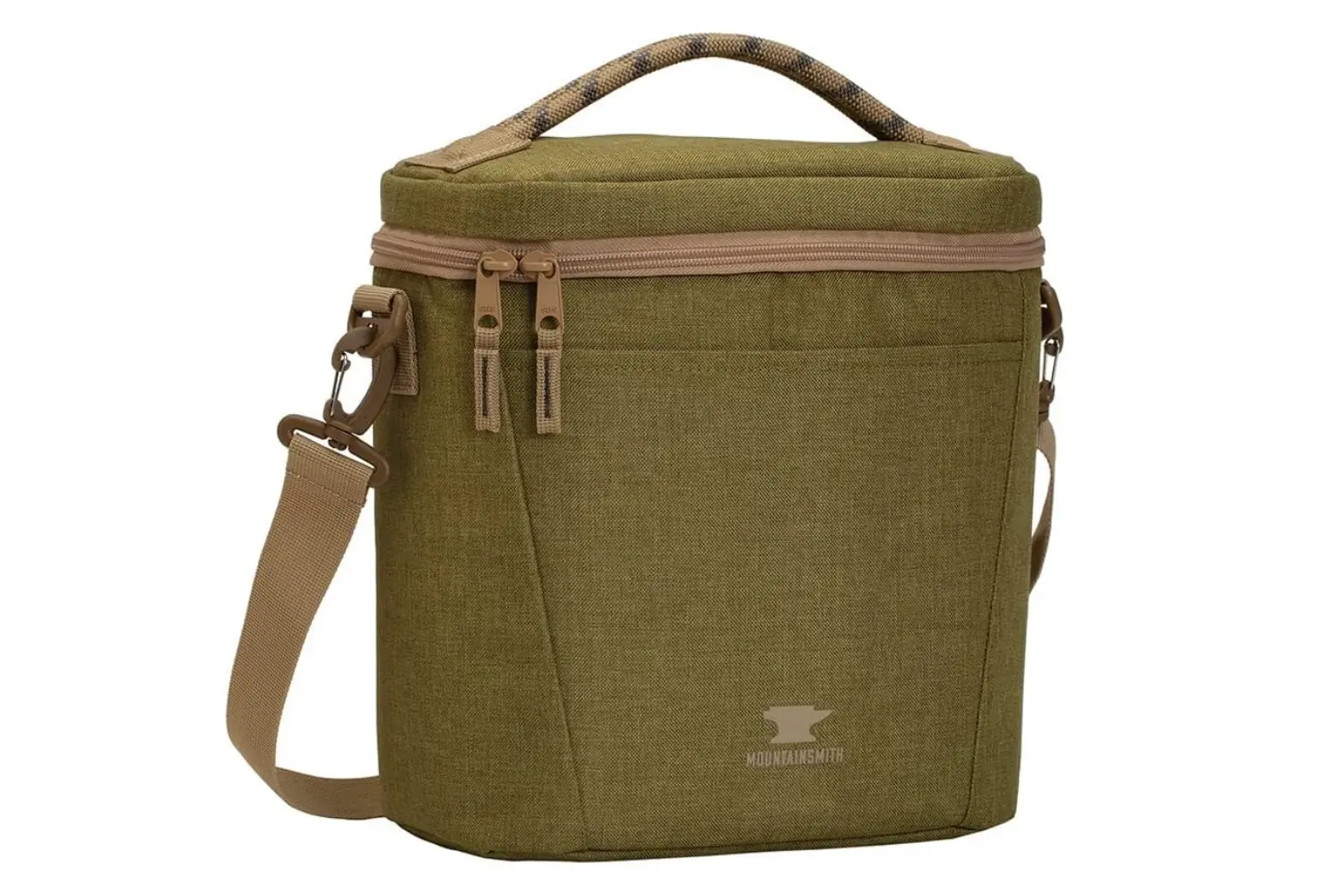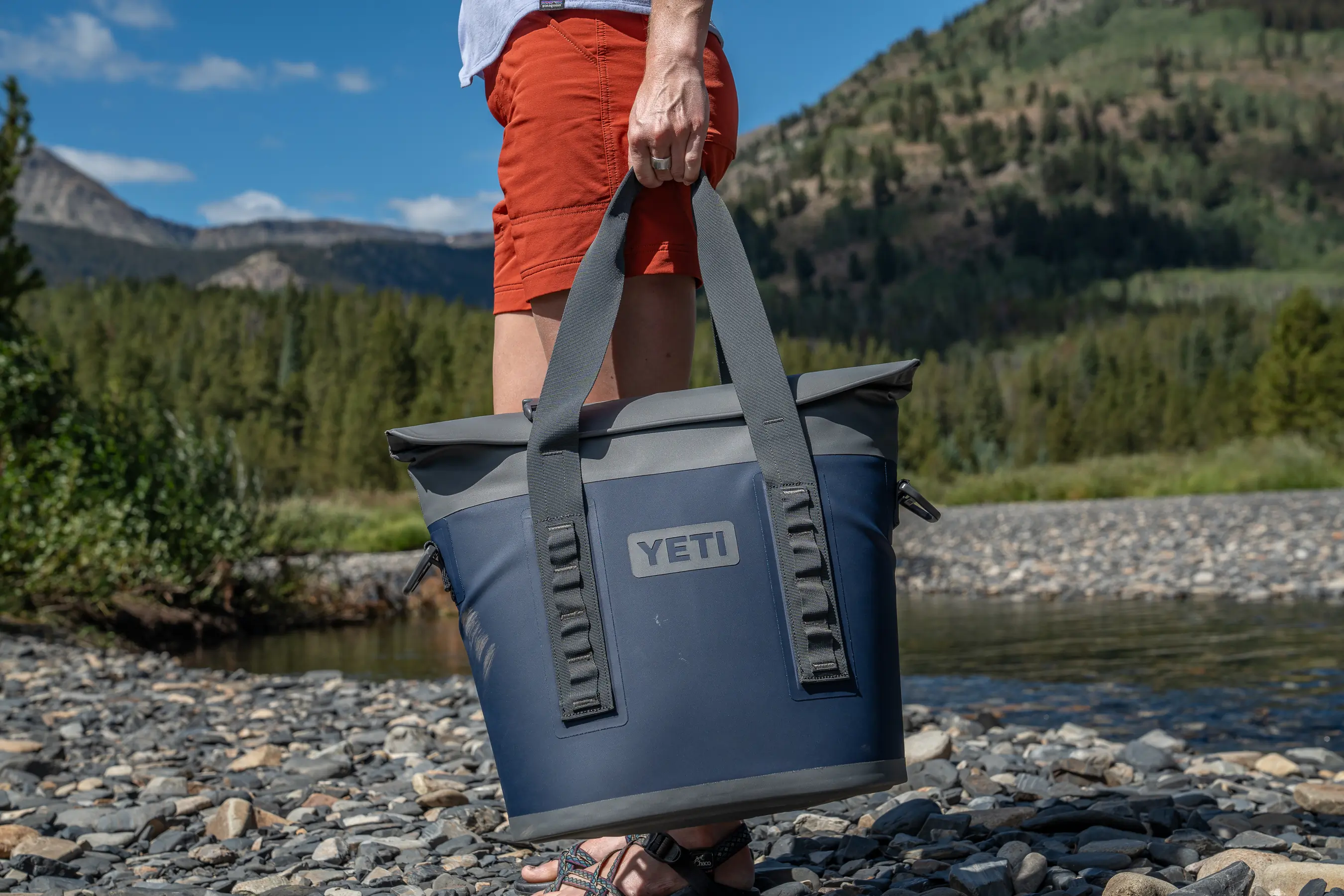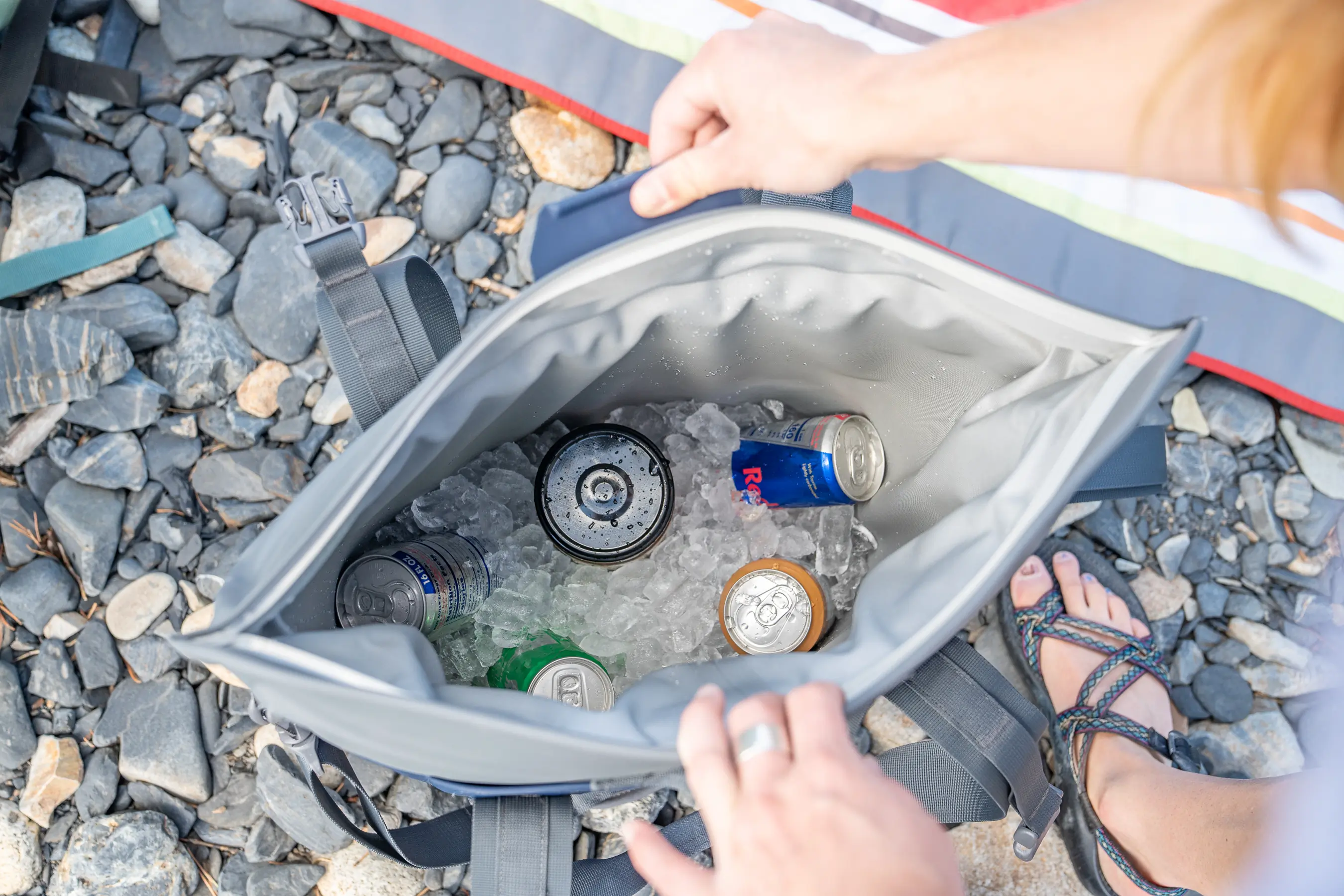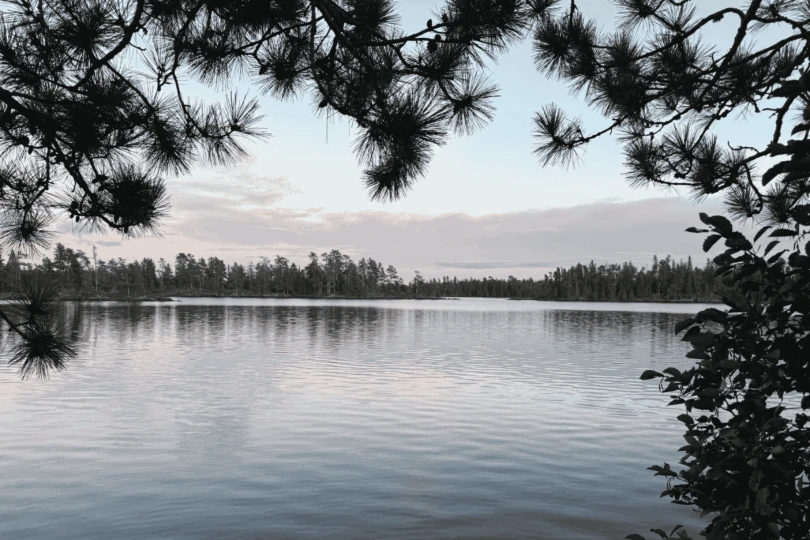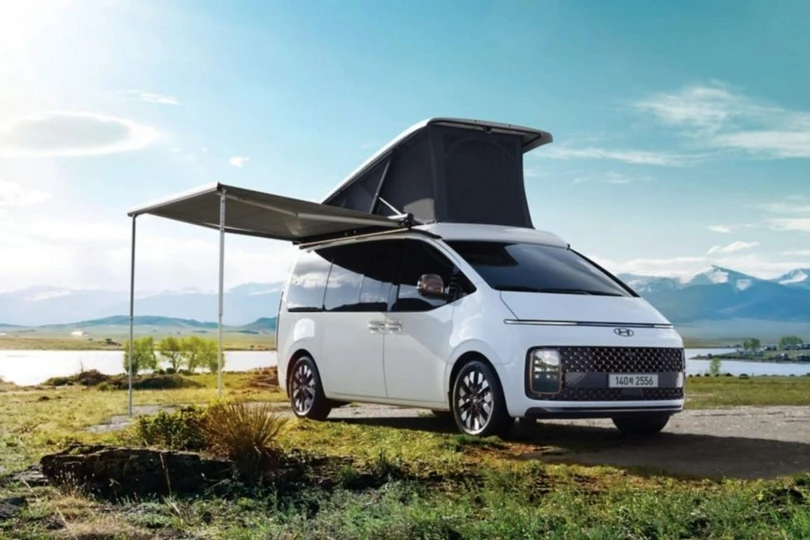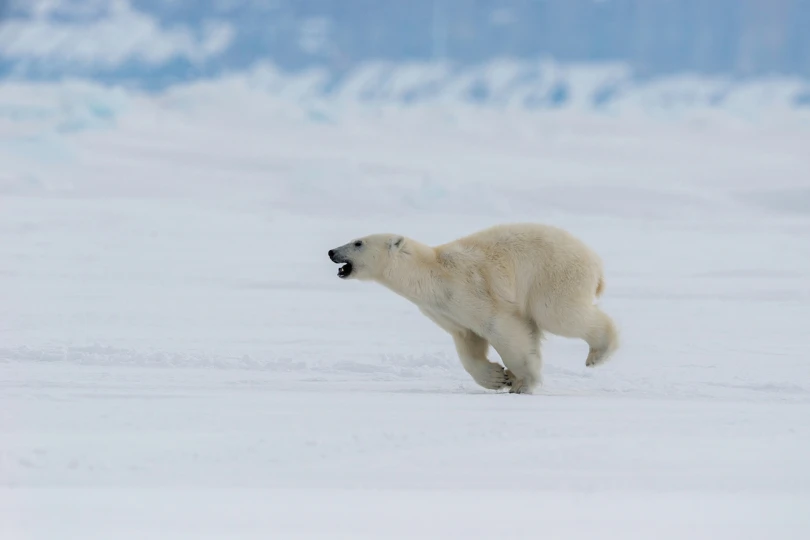We’ll always have a spot in our gear closet for a hard cooler, but soft coolers have proven to be just as essential. They weigh less and are easy for one person to grab and quickly transport from the deck to the truck bed.
There’s a broad range of sizes and softness in soft coolers. Some of these designs are actually very rigid, stout, and stackable, such as the YETI Hopper Flip 12 Soft Cooler. Others are fully collapsible and pliable, like the REI Co-op Campwell Folding Cooler, and we celebrate the space-saving option for storage.
For day-long roams, weekend adventures, road trips, or running errands, these soft coolers kept our provisions chilled without weighing us down.
Editor’s Note: We updated our Soft Coolers buyer’s guide on August 12, 2025, with field and ice retention tests for the Igloo Trailmate 18-can, Hydro Flask 20L Carry Out Soft Cooler, unique Titan by Arctic Zone 30 Can Zipperless HardBody Cooler — that’s right, it’s zipper-free — the updated REI Co-op Campwell Folding Cooler for limited closet space, and freshly launched YETI Daytrip Tote Bag 14L for picnics and office commutes. Senior Editor Morgan Tilton penned new educational sections including Pockets and Price & Value.
The Best Soft Coolers of 2025
YETI Hopper Flip 12 Soft Cooler
- Size: 14.3" x 10.7" x 12.0"
- Capacity: 12L
- Weight: 1361 g (3 lbs.)
- Ice retention test: ~3 days
Pros
- Lightweight
- Durable
- Waterproof
- Great Insulation
- Floats
Cons
- Pricey
- Zipper is not the most durable
Titan by Arctic Zone Bucket Tote
- Size: 15" x 10" x 13.5"
- Capacity: 33L
- Weight: 816 g (1.8 lbs.)
- Ice retention test: ~3 days
Pros
- Great ice retention
- Two over-the-shoulder straps Velcro together alongside an optional shoulder strap
- Includes bottle opener
Cons
- A few of us don’t prefer the look
- The lid’s zipper is not waterproof
RTIC 20 Can Soft Pack Cooler
- Size: 13.5” x 9.5” x 13.75”
- Capacity: 12L
- Weight: 1360 g (3 lbs)
- Ice retention test: ~3 days
Pros
- Multiple handles for carrying options
- Great insulation
- Ability to float
Cons
- Narrow storage makes it difficult to organize and see cooler items at the bottom
- Additional pocket is small and tight
Titan by Arctic Zone 30 Can Zipperless HardBody Cooler
- Size: 16.50" x 11.00" x 12.75"
- Capacity: 30 cans
- Weight: 1,651 g (3.64 lbs.)
- Ice retention test: ~3 days
Pros
- No zipper on the lid
- Large lid opening to primary storage
- Six optional volumes
Cons
- Water can make its way between the HardBody liner and cooler liner if tipped
REI Co-op Campwell Folding Cooler
- Size: 13" x 10" x 9"
- Capacity: 18L
- Weight: 519 g (1.14 lbs.)
- Ice retention test: ~2+ days
Pros
- Daisy chains and spacious external pocket with a zipper
- Transforms into a tote, cube, and flat for storage
- Lightweight
Cons
- Can’t stack any items on top of this soft cooler
- Tote is wobbly and doesn’t dependably stand upright
- Top zipper is not waterproof
Snow Peak Soft Cooler 38
- Size: 19" x 12.5" x 12.5"
- Capacity: 38L
- Weight: 1,724 g (3.8 lbs.)
- Ice retention test: ~2.5 days
Pros
- Large capacity
- Supple and easy to carry
Cons
- The lid’s zipper is not waterproof
- A bit overpriced for the low ice retention but worth the cost for collapsibility
YETI Hopper M15 Tote
- Size: 20.3" x 16" x 9.2"
- Capacity: 17L
- Weight: 2,268 g (5 lbs.)
- Ice retention test: ~4 days
Pros
- Comfortable, smooth shoulder strap
- Powerful magnetic closure stays shut
- The closure doesn't snap shut when you're shuffling items in and out
- Excellent ice retention
Cons
- Narrow closure toward the top: it's hard to see the bottom of the tote
- Premium build means high price
Other Soft Coolers That Keep Our Snacks Fresh
- Size: 8.07" x 10.83" x 13.58"
- Capacity: 14L
- Weight: 1,100 g (2.43 lbs.)
- Ice retention test: ~2.5 days
Pros
- External stash pockets
- Easy to open with magnetic closure
- Lengthy shoulder straps for easy carry
Cons
- Magnetic closure pops open if cooler is tightly loaded
- Size: 11" x 4.25" x 9"
- Capacity: 4.5L
- Weight: Not Available
- Ice retention test: ~1.5 days
Pros
- Super adaptable cooler
- Interior sleeve for ice pack or food item
- Fits on bike handlebars super well
- Cross-body tote is comfortable
Cons
- Not quite large enough for a picnic for two with bevies
- Size: 14.57" x 11.81" x 12.99"
- Capacity: 18 cans
- Weight: 1,139 g (2.51 lbs.)
- Ice retention test: ~2.5 days
Pros
- Compact fit for road trips
- Multiple carry options
- Includes bottle opener
Cons
- Can leak if tipped over
- Size: 16.14" x 11.81" x 14.57"
- Capacity: 20L
- Weight: 1,247 g (2.75 lbs.)
- Ice retention test: ~3 days
Pros
- Large opening
- Multiple carry options
- Fun color options
Cons
- Can leak if tipped over
- Pocket is tight with no keyring or bottle opener
- Size: 17" x 14" x 6.25"
- Capacity: 20L
- Weight: 599 g (1.32 lbs.)
- Ice retention test: ~3 days
Pros
- Great ice retention
- Easy zipper glide
- Reinforced over-the-shoulder straps
- Includes attached key lanyard
Cons
- Lighter colors shows dirt quickly
- The zipper is not waterproof
- Size: 22.5" x 14.38" x 8"
- Capacity: 30L
- Weight: 975 g (2.15 lbs)
- Ice retention test: ~2.5 days
Pros
- Waterproof
- Storage capacity
- Doubles as a dry bag
Cons
- Difficult to clean
- Difficult to organize and see inside with how wide the zipper opens
- Size: 11" x 11" x 6"
- Capacity: 12L
- Weight: 499 g (1.1 lbs.)
- Ice retention test: ~25 hours
Pros
- Two tote straps comfortably slide over the shoulder
- Great for park concerts
- Zippered interior mesh pocket inside cooler lid for utensils
- Two flat pockets on the side
Cons
- We’d like the lightweight removable shoulder strap to be burlier
- Cooler bottom can absorb moisture
- Lid’s zipper is not waterproof
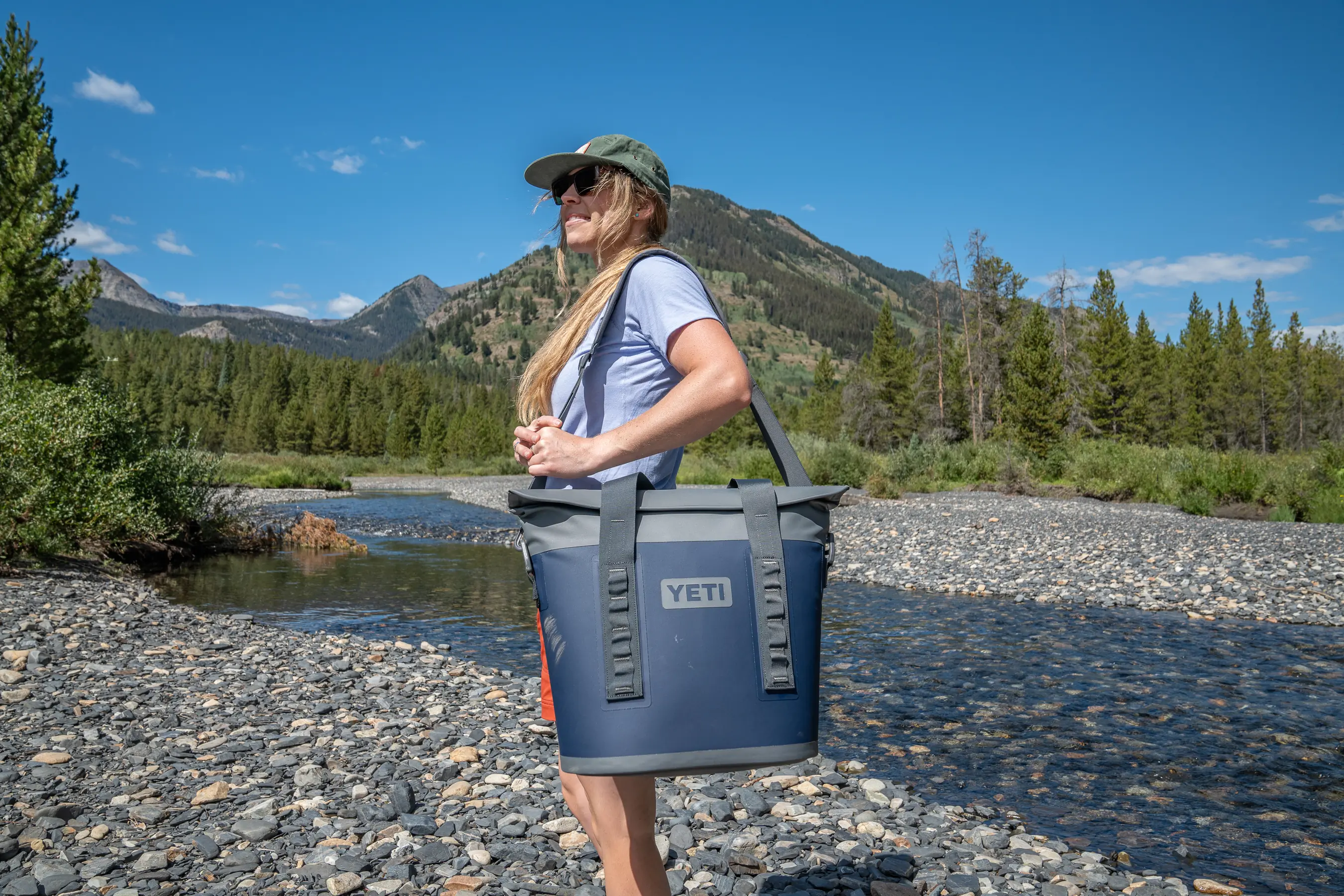
Soft Cooler Comparison Chart
Scroll right to view all of the columns: Price, Size, Capacity, Weight, Ice Retention Test.
| Soft Cooler | Price | Size | Capacity | Weight | Ice Retention Test |
|---|---|---|---|---|---|
| YETI Hopper Flip 12 Soft Cooler | $250 | 14.3″ x 10.7″ x 12.0″ | 12 L | 1,361 g (3 lbs.) | ~3 days |
| Titan by Arctic Zone Bucket Tote | $53 | 15″ x 10″ x 13.5″ | 33 L | 816 g (1.8 lbs.) | ~3 days |
| Snow Peak Soft Cooler 38 | $185 | 19″ x 12.5″ x 12.5″ | 38 L | 1,724 g (3.8 lbs.) | ~2.5 days |
| REI Co-op Campwell Folding Cooler | $40 | 13″ x 10″ x 9″ | 18 L | 519 g (1.14 lbs.) | ~2+ days |
| ICEMULE Impulse | $100 | 11″ x 4.25″ x 9″ | 4.5 L | 454 g (1 lbs.) | ~1.5 days |
| YETI Hopper M15 Tote | $300 | 20.3″ x 16″ x 9.2″ | 17 L | 2,268 g (5 lbs.) | ~4 days |
| RTIC Soft Pack Cooler | $300 | 13.5” x 9.5” x 13.75” | 12 L | 1360 g (3 lbs) | ~3 days |
| Hydro Flask 20L Insulated Tote | $65 | 17″ x 14″ x 6.25″ | 20 L | 599 g (1.32 lbs.) | ~3 days |
| Booe Waterproof Insulated Tote | $200 | 22.5″ x 14.38″ x 8″ | 30 L | 975 g (2.15 lbs) | ~2.5 days |
| Mountainsmith Sixer | $40 | 11″ x 11″ x 6″ | 12 L | 499 g (1.1 lbs.) | ~1.1 days |
| Igloo Trailmate Cooler Bag | $80 | 14.57″ x 11.81″ x 13″ | 6.3 L | 1,139 g (2.51 lbs.) | ~2.5 days |
| Hydro Flask 20L Carry Out Soft Cooler | $90 | 16.14″ x 11.81″ x 14.57″ | 20 L | 1,247 g (2.75 lbs.) | ~3 days |
| Titan by Arctic Zone 30 Can Zipperless HardBody Cooler | $63 | 16.5″ x 11″ x 12.75″ | 11 L | 1,651 g (3.64 lbs.) | ~3 days |
| YETI Daytrip 14L Tote Bag | $135 | 8″ x 10.83″ x 13.58″ | 14 L | 1,100 g (2.43 lbs.) | ~2.5 days |


How We Tested Soft Coolers
Our team has developed cooler guides year after year, objectively testing dozens of soft, hard, and backpack coolers in the field, from whitewater raft trips to fly fishing adventures and music festivals in the mountains.
Our Expert Testers
Lead tester Morgan Tilton, Senior Editor specializing in Snow Sports Buyer’s Guides, coordinated five studious gear testers to adventure with and examine the soft coolers in this guide from ultrarunners and ski mountaineers to fly fishing and whitewater rafting guides. With that test team, she wrote the original soft coolers and backpack coolers buyer’s guides that were first published in 2022.
Dedicated outdoor enthusiast Constance Mahoney explores trails, goes fly fishing, and crews 100-mile races: She knows when to invest in high-quality gear and when budget-friendly options will do the job. Constance has been a GearJunkie contributor since 2019, after she reviewed outdoor gear for FitnessTravelGear.com for two years.
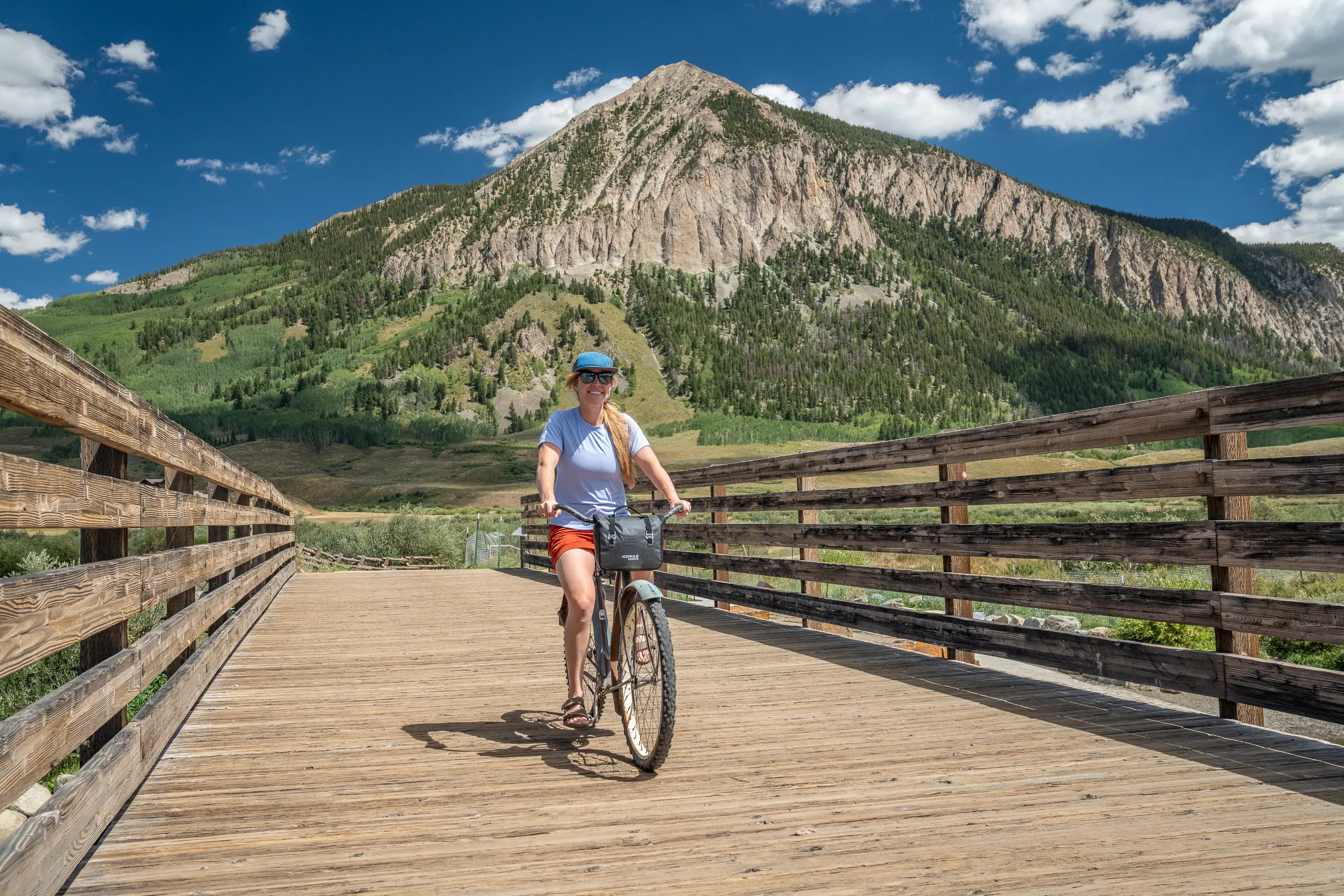



Gear tester Makena Gross is the assistant ski patrol director and a ski and bike patroller at Brian Head Resort, alongside teaching wilderness medicine courses. While adventuring throughout the Southwest, Gross took these coolers on a multitude of activities, ranging from day trips to the lake to go fishing and swimming to multiday road trips. Gross always tests the coolers across a range of conditions.
Professional athlete and gear analyst Dane Tudor is a manager for Gravity Logic, where he designs mountain bike trails and operates machinery when he’s not big mountain freeskiing. For the heavy lifting, Tudor takes along soft coolers and backpack coolers, carrying thousands of calories into the woods for 12-hour days building bike parks throughout North America.
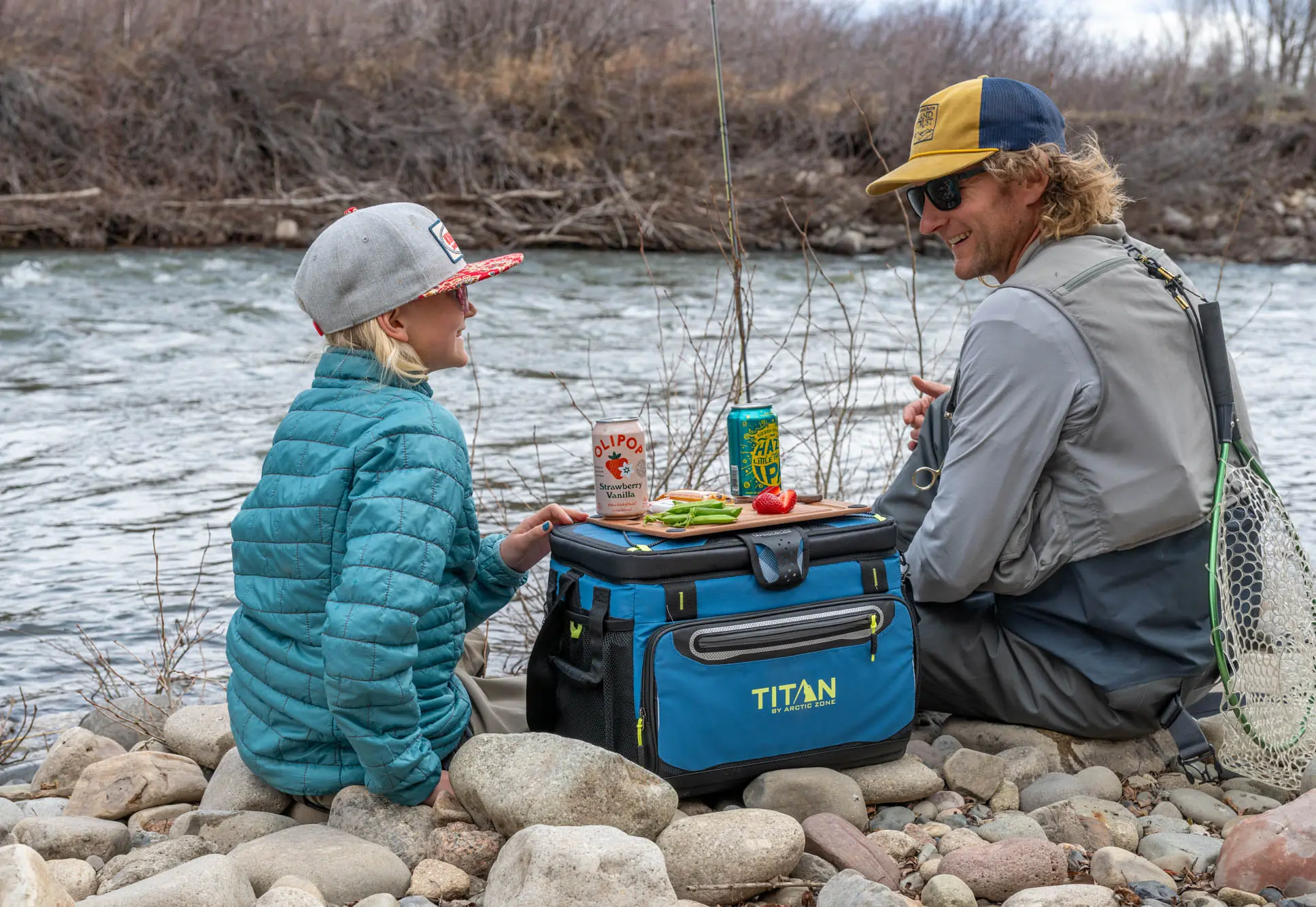



Our Testing Grounds
Our crew took these coolers through myriad conditions from summertime park BBQs to camping in Colorado’s Sangre de Cristo Mountains, guiding fly fishing sessions on rivers, bike park building in British Columbia, and road-tripping to ski mountaineering in the Pacific Northwest.
Our Testing Process
For this soft cooler guide, we examined the most popular, innovative, highly acclaimed, and bestselling products with diverse storage and carry capacities, ice retention ability, and across a price spectrum.
We also performed a controlled in-house ice retention test to verify brand claims. For the experiment, we filled each pre-cooled cooler approximately 70% with fresh, frozen cubed ice and set them in a shaded, dry indoor space at a steady average of 65 degrees.
We periodically checked, making notes regarding melt rate, condensation, and leaks. Each reported time is based on when 100% of the ice was converted to water. This data provides a benchmark. But when traveling outdoors, these controlled variables disappear and the ice will likely melt faster.


Buyer’s Guide: How to Choose a Soft Cooler
Storage Capacity
Choose a soft cooler based on the storage capacity and type of support you need for the load. A super malleable product like the Snow Peak Soft Cooler might not be the best for carrying dozens of heavy cans compared to a more rigid design like the RTIC 20 Can Soft Pack Cooler.
The larger the group, the more cargo space you’ll need. The soft coolers in our guide range from the ICEMULE Impulse, which fits a lunch, to the 38L Snow Peak Soft Cooler. Most of our choice soft coolers are either larger (30 L to 38 L) for group multiday trips or more compact (12 L to 19 L).
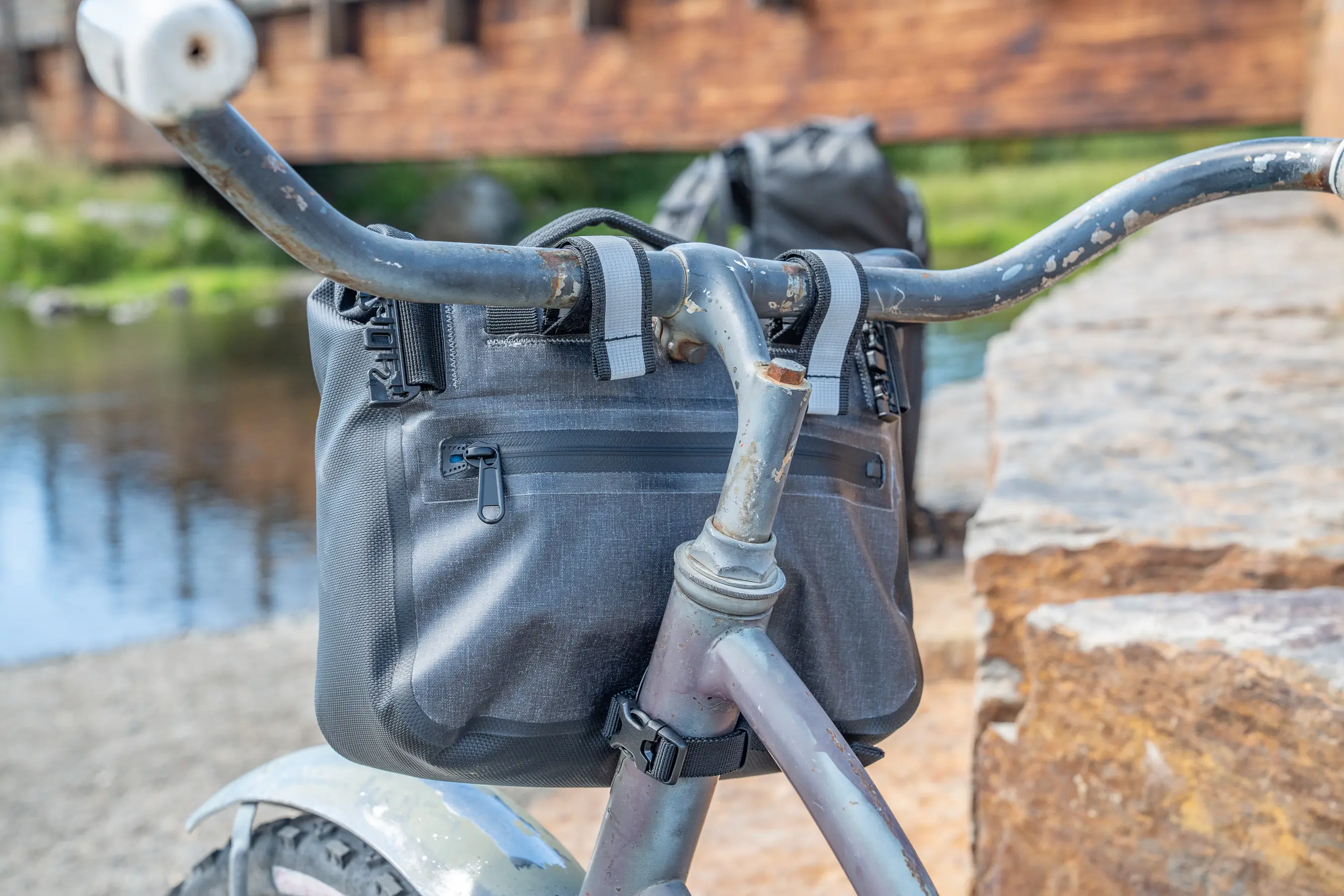



Dry Compartments
Other than the insulated storage you might need a soft cooler with a dry compartment to carry miscellaneous stuff.
Some coolers like the Booe 30L Waterproof Insulated Tote only have the main storage compartment with no other pockets or mesh liners to put extra objects in. However, this cooler offers dry side storage with the ability to take out the liner where you can add items in between the exterior shell and the liner.
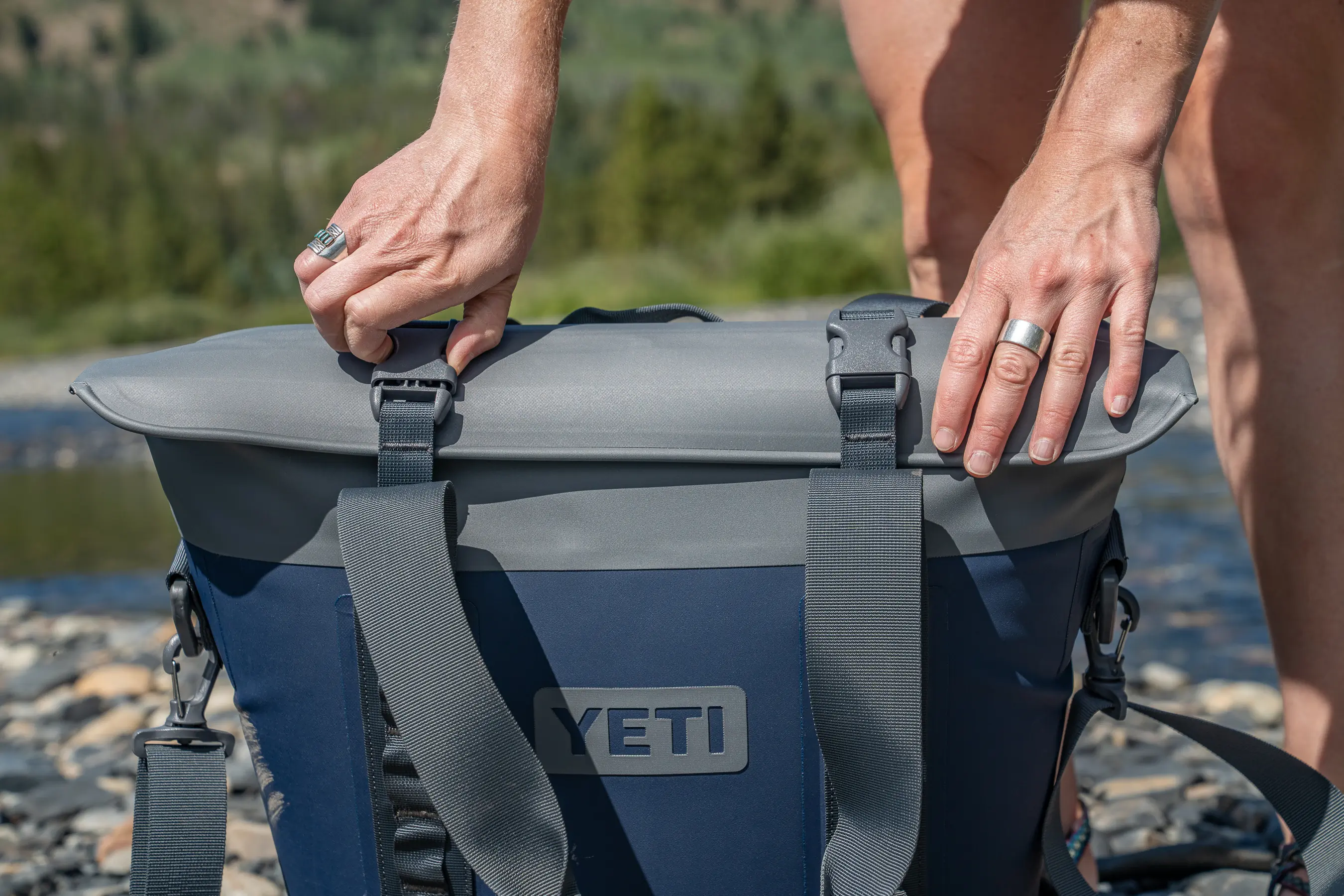



Pockets
For organization, some of these soft coolers offer extra storage pockets — both inside and on the exterior — that’s perfect for stowing items like phones, keys, chapstick, or utensils.
Coolers such as the RTIC 20 Can Soft Pack Cooler have an exterior zip-up pocket that fits small items, like your phone, keys, and wallet, and is waterproof for extra safekeeping. Pockets can be zippered or mesh — like on the Titan by Arctic Zone 30 Can Zipperless HardBody Cooler — or envelope style.
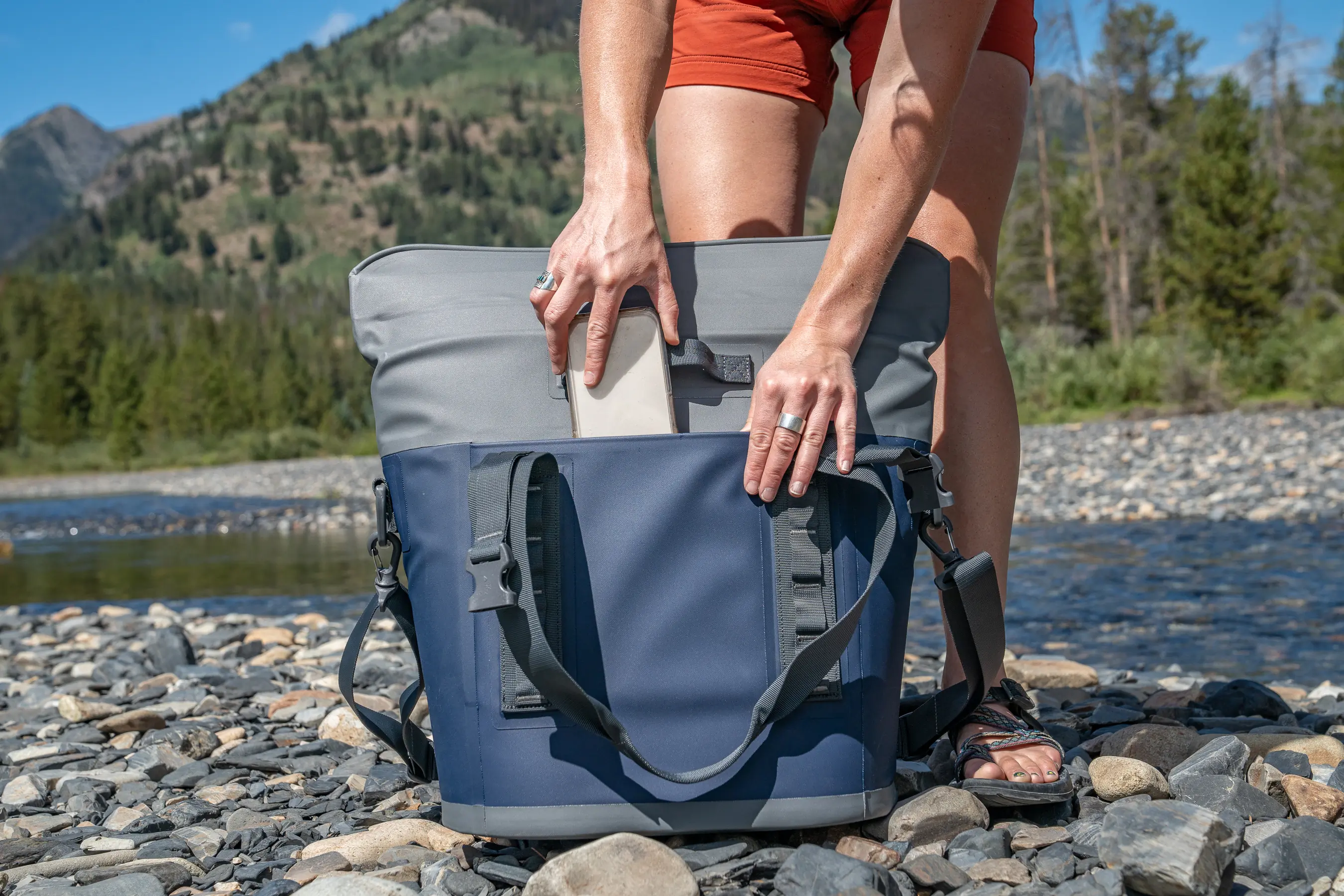



Attachment Points & Accessories
Soft coolers come with various attachment points and other features to enhance functionality. That includes hard clip points, webbing straps, and bungee cords for carrying extra gear. The ICEMULE Impulse offers unique straps that can be used to attach it to bike handlebars.
You may also see coolers with a hitchpoint grid, like the YETI Hopper Flip 12 Soft Cooler, which has daisy chain loops that you can clip your keys, other carabiners, or straps to for additional items. A grid system can also be used to secure your cooler down on a standup paddleboard or boat.
Many models also feature reflective logos and built-in bottle openers.
However, it’s worth noting that many soft coolers lack tiedown points, which could be particularly beneficial for river adventures or motorcycle trips. Having this feature would provide additional security for your gear while on the go.
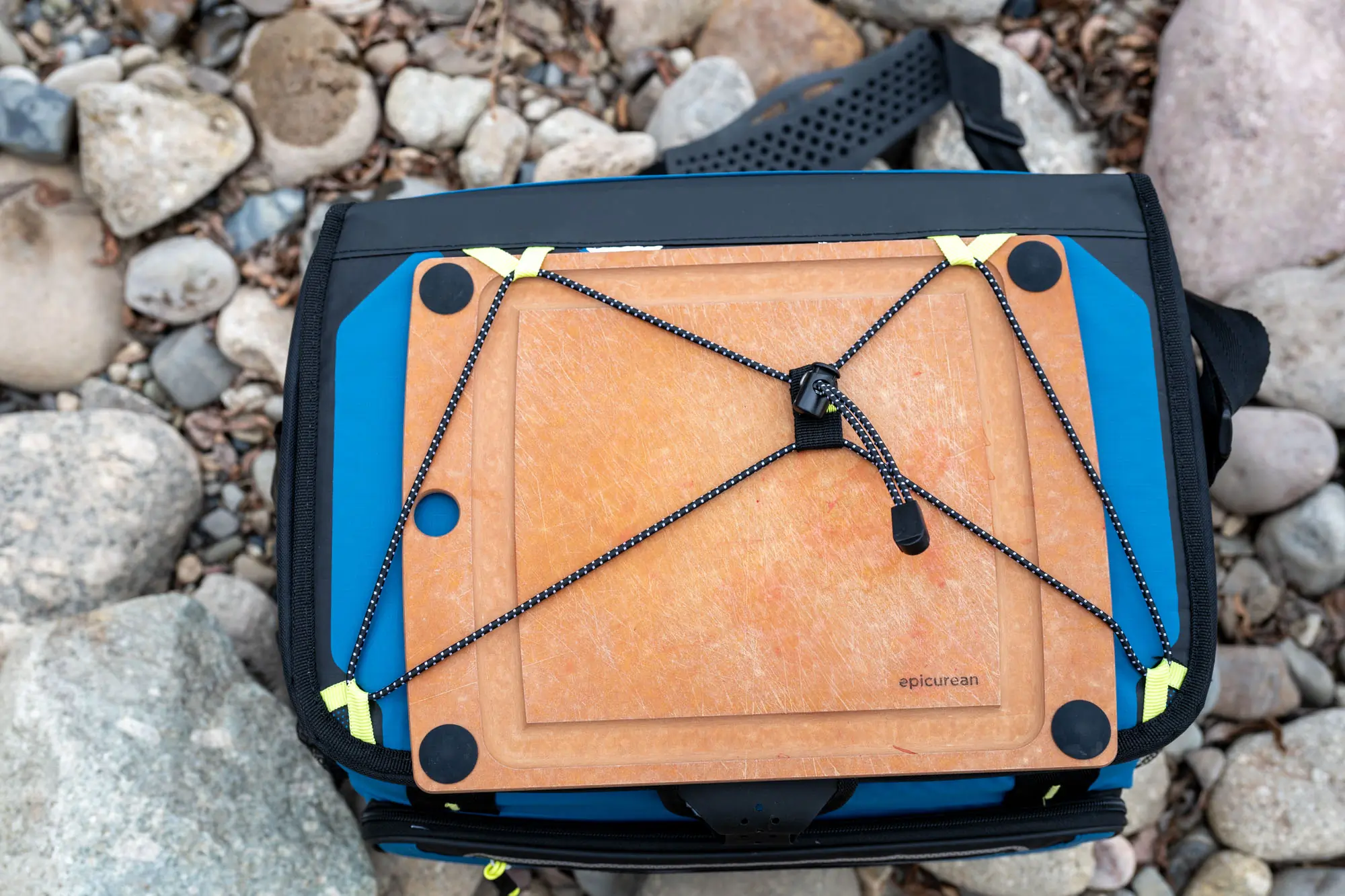



Straps & Handles
Handles and straps are constructed with a variety of materials. Some are more ergonomic, comfortable, and durable than others.
Most soft coolers have side or top handles, two straps that swing up to secure together above the cooler, or a removable shoulder strap. A bunch of designs have a combination of handles and straps, too. For coolers on the larger side, like the YETI Hopper M15 Tote, it’s key to have padding on the hand or shoulder straps for comfort while carrying a fully loaded cooler.
In our testing, we liked the wide, soft material of the two swing-up straps on the Snow Peak Soft Cooler.
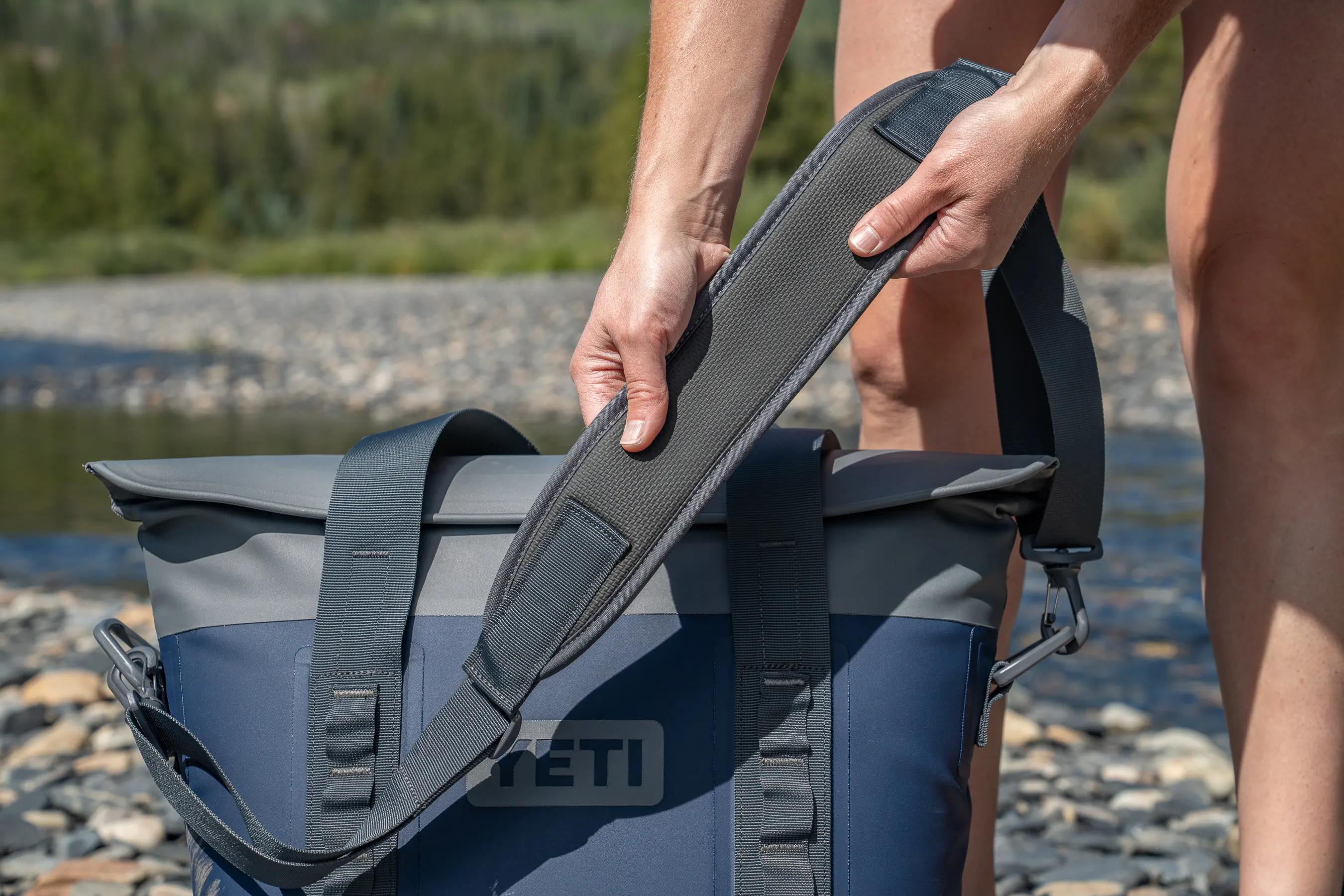



Soft Cooler Weight
The weights of soft coolers are typically reflected by their size and capacity. The smallest design in our guide is the ICEMULE Impulse, which weighs less than a pound. The heaviest soft cooler is the 5-pound YETI Hopper M15 Tote, which has a 17L capacity and the best ice retention.
Even the heaviest soft cooler in our guide is lighter than a hard cooler. For comparison, the YETI Tundra 45 Cooler weighs 23 pounds, and the RovR Products RollR 45 weighs more than 37 pounds.
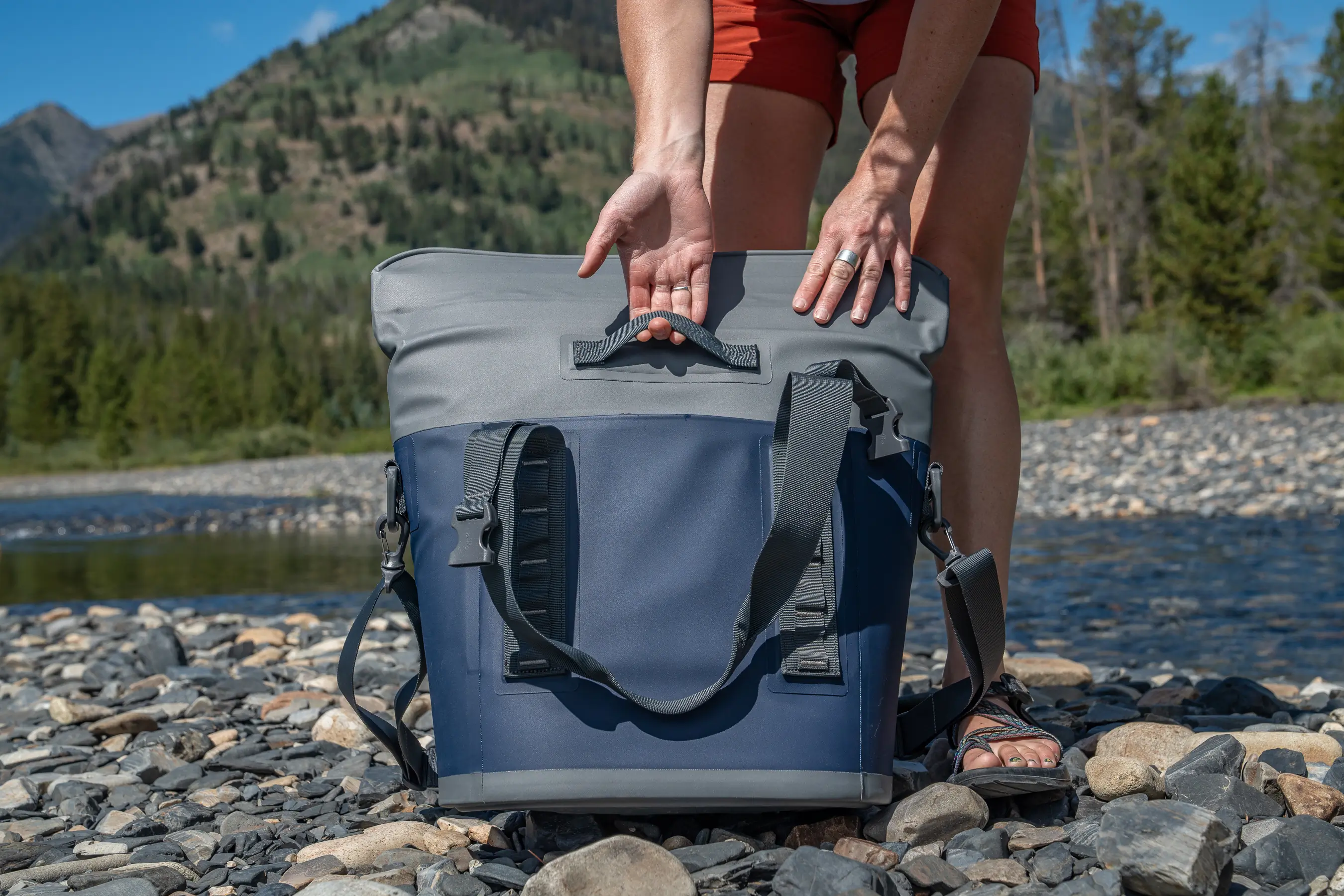



Soft Cooler Shape
Soft cooler totes are long, slender, and streamlined against your side. They’re comfortable to carry over a shoulder. However, taller coolers get trickier with access to buried items, so you have to be mindful when packing the cooler.
Soft coolers that are wider or more bucket-style are easier to access, as far as finding a specific item. But, they can feel more cumbersome to carry over a shoulder. Coolers with a broad, flat surface that rests against you can help absorb that swing and bounce.
Boxier coolers can be easier to stack — as long as the walls and base are rigid — while sleeker coolers can more likely slip behind a seat in your car. Shorter, more compact coolers are easier to fit in tight spaces on a boat.
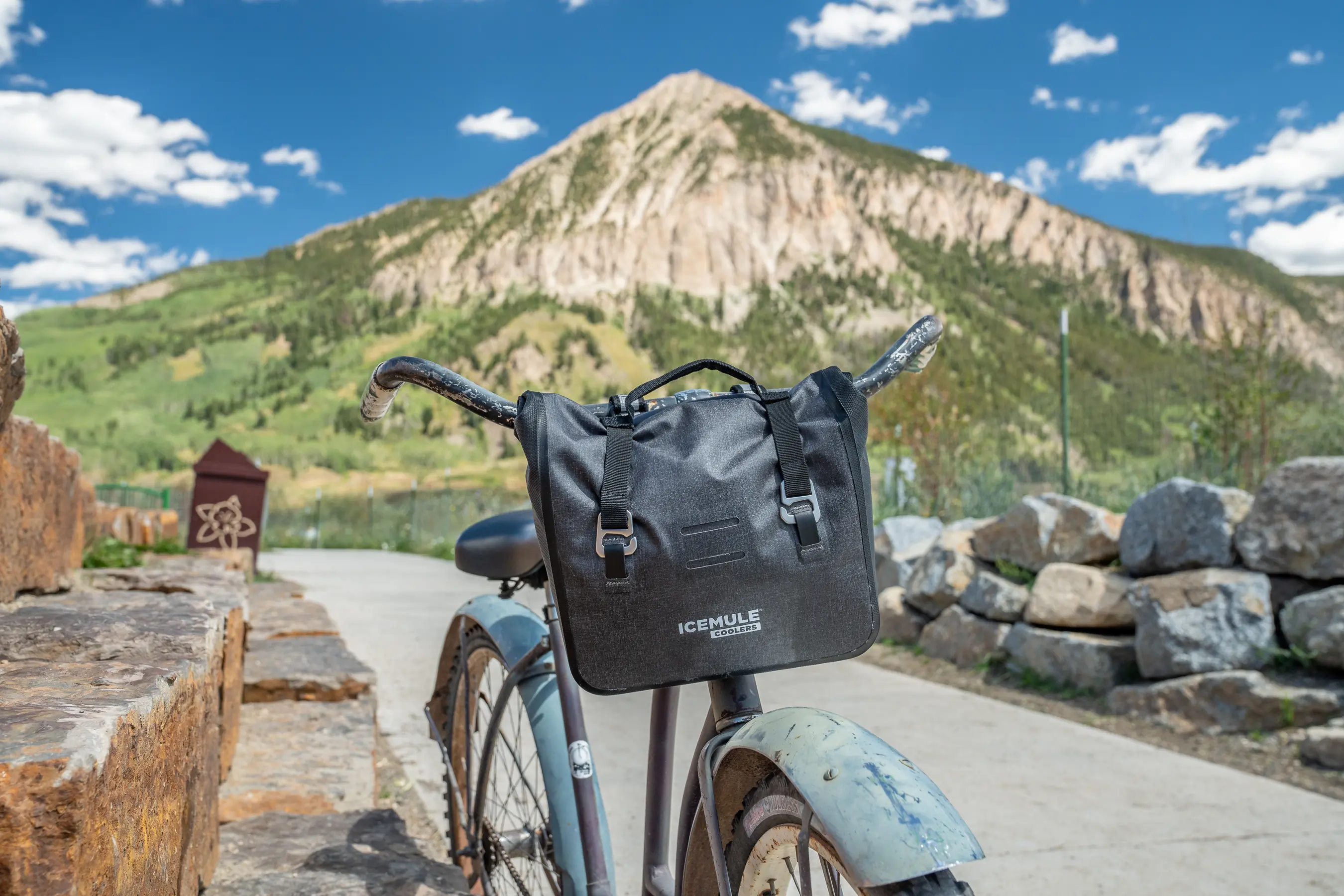



Soft Cooler Materials
A soft cooler’s materials include the exterior, insulation, interior liner, and handles. A range of top closures exist, the most common being waterproof and leakproof zippers or non-waterproof and leakproof zippers.
We pay attention to that variable to know if a cooler needs to always be upright. Some unique closures don’t allow leaks. Other coolers have magnetic seams, like models made by YETI. Welded seams also help prevent leaks.
Soft coolers may have shoulder straps — which are typically removable — buckles, attachment points, and interior or exterior pockets. Some pockets have durable, waterproof zipper closures, but many are not weather-resistant or secured with a closure.
The quality of materials influences the waterproofness, durability, insulation value, and whether or not the face fabric produces condensation. The materials also determine the comfort, breathability, support, and overall cost.
Certain soft coolers are made from recycled materials, offering eco-conscious options for your outdoor excursions.
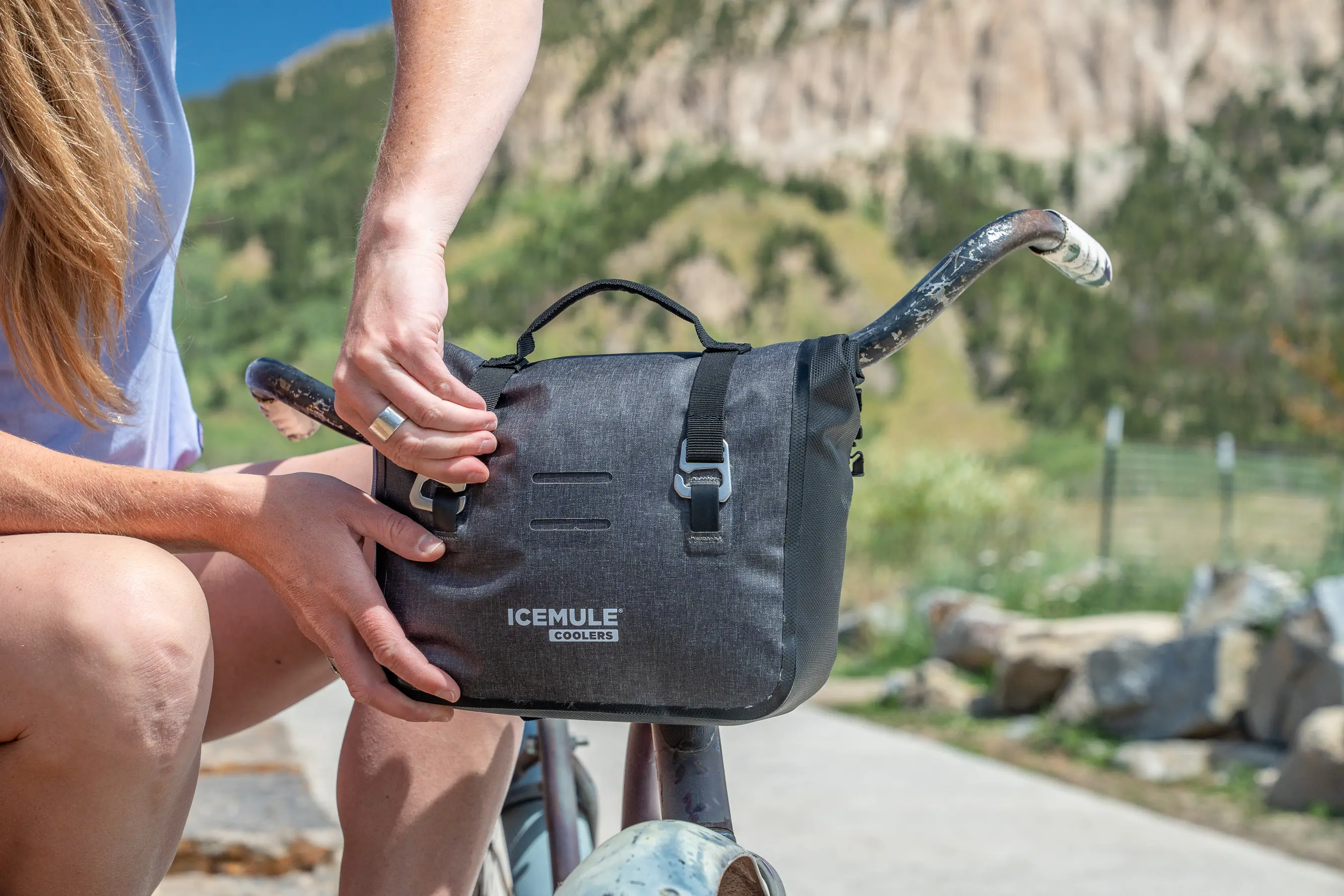



Soft Cooler Base
The base of a soft cooler can play a significant role in the integrity of your cooler. A strong base keeps your cooler walls from collapsing, while a flimsy base could result in the walls caving in.
Another factor is how well-insulated the base is. A thicker, more insulated base can keep your contents cooler for longer while it is sitting on a hot truck bed, dock, or boat.
Both the RTIC 20 Can Soft Pack Cooler and the YETI Hopper Flip 12 Soft Cooler are more box-shaped and have a thick, sturdy base that provides stability and insulation support.
Tote-style coolers including the Booe 30L Waterproof Insulated Tote have welded seams on the base that prevent leakages and keep the cold insulation from escaping.
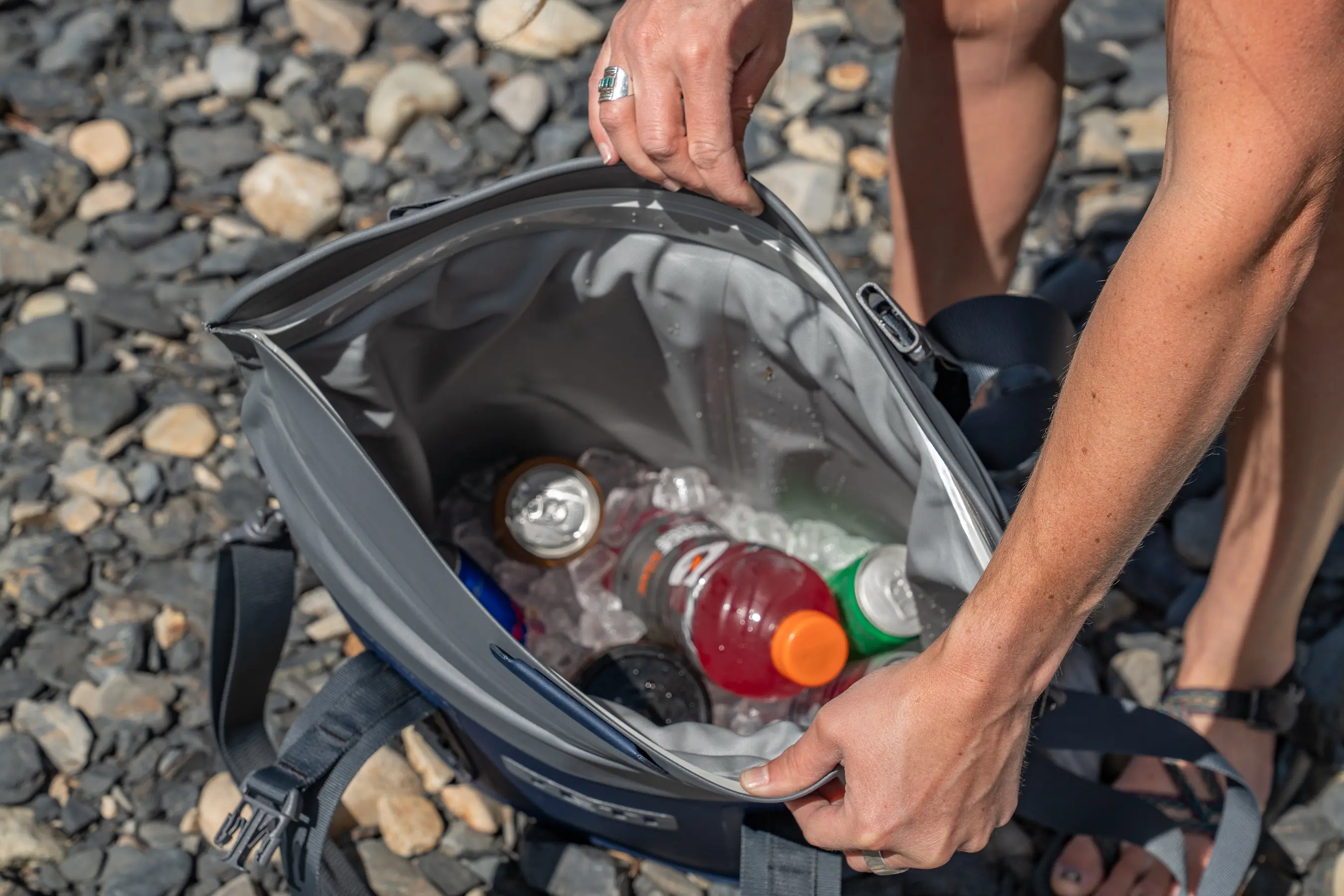



Ice Retention
We completed our ice retention test with controlled variables. Each soft cooler was stationed indoors at around 65 degrees, shaded, and filled with the same ratio and type of ice.
Ice Retention Test Results
- YETI Hopper M15 Tote — 96 hours
- Titan by Arctic Zone 30 Can Zipperless HardBody Cooler — 75 Hours
- YETI Hopper Flip 12 Soft Cooler — 72 hours
- RTIC 20 can Soft Pack Cooler — 72 hours
- Hydro Flask 20L Carry Out Soft Cooler — 70 hours
- Titan by Arctic Zone Bucket Tote — 70 hours
- Hydro Flask 20L Insulated Tote — 65 hours
- YETI Daytrip Tote Bag 14L — 60 hours
- Booe 30L Waterproof Insulated Tote — 60 hours
- Igloo Trailmate 18-Can Cooler Bag — 60 hours
- Snow Peak Soft Cooler — 60 hours
- REI Co-op Campwell 18L Folding Cooler — 57 hours
- ICEMULE Impulse — 36 hours
- Mountainsmith Sixer — 25 hours
For a variety of conditions, the soft coolers in this guide provide enough cooling power to serve a range of recreation needs.
When you use a cooler outside, many factors influence a pack’s ice retention, including the frequency of opening the cooler, direct sunlight, and ambient temperature. For instance, one soft cooler preserved ice for 60 hours during our test but only for 18 hours during one toasty car camp trip.


How to Properly Pack a Soft Cooler
The best way to pack a soft cooler is to pre-chill it. This simple step can make a significant difference in keeping your food and drinks cold. You can pre-chill the cooler by placing ice packs or crushed ice inside for a few hours to maintain a low temperature.
After a pre-chill, begin with a layer of ice at the bottom, followed by your food and drinks. Pack these tightly to minimize air space, which helps keep everything cold. Overall, you want a ⅔ to ⅓ ice to food/drink ratio.
Place heavier items at the bottom and lighter ones on top, grouping similar items for easy access. This will not only keep your cooler organized but also make it easier to find what you need. Utilize any external or internal pockets for small items like utensils, keeping them separate from the main contents.
Once packed, ensure the cooler is closed up completely to minimize air exposure and prevent temperature loss. Fill any extra space with contents, because air speeds up the ice melt. If needed, you could pack crumpled paper or small towels to take up air space.
Try to avoid frequent openings — as each time you do, cold air escapes, raising the temperature inside. Ideally, when you arrive at your destination, place the cooler in the shade on a cool surface to help maintain its temperature and prevent the acceleration of ice melt.
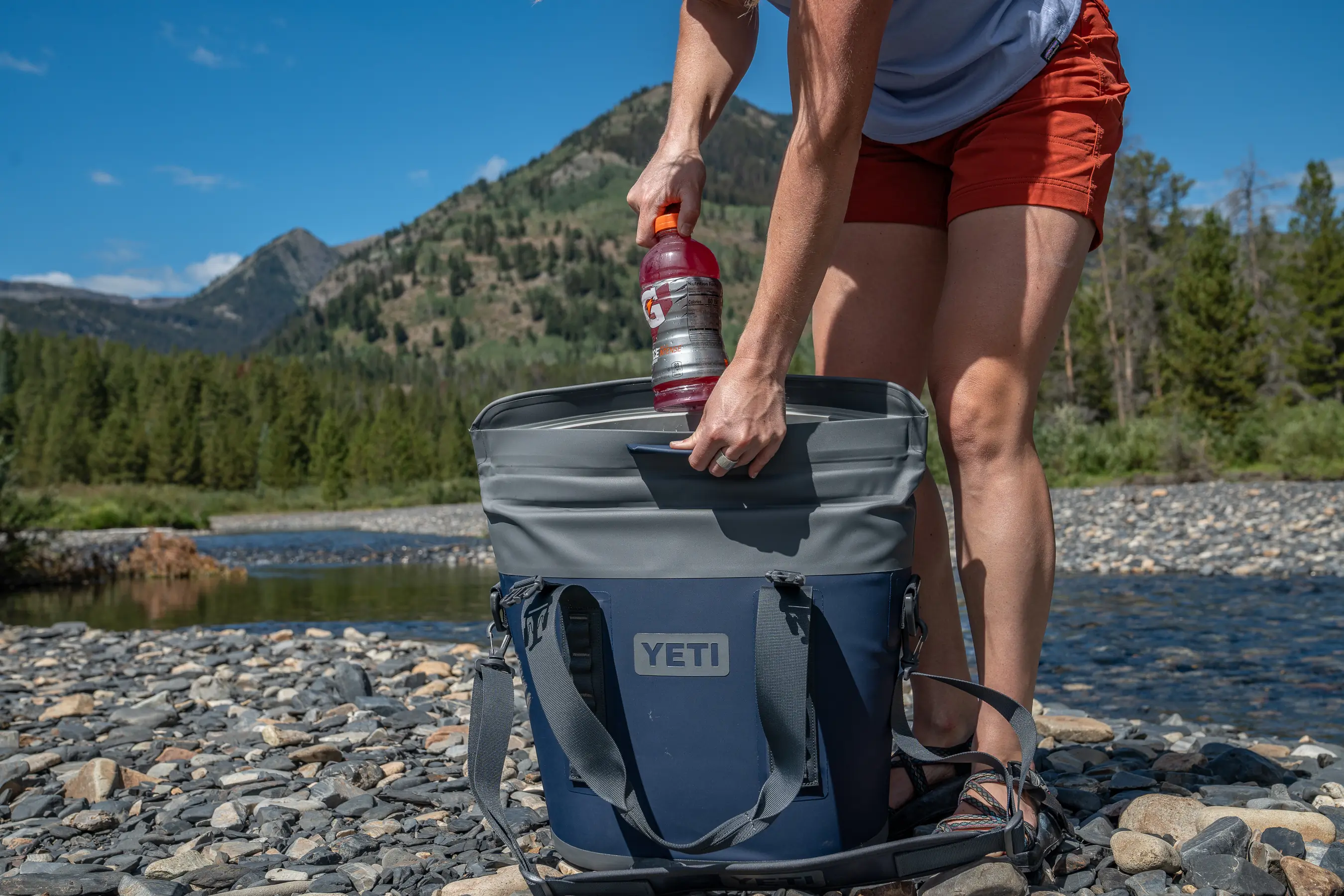



How to Care for Your Soft Cooler
Some soft coolers have materials that are mildew-resistant and antimicrobial like the interior liner of the RTIC Soft Pack Cooler. YETI also treats the interior and exterior of its Hopper Flip soft coolers to be mildew resistant, which helps with keeping your tote sanitary while extending the life of the product.
Between uses, you can clean the interior of a soft cooler with a sponge, lukewarm water, and standard dish soap. You can wipe down the exterior and zipper, too — don’t miss the feet and bottom, which touch ground surfaces. Let the interior completely air dry or use a towel to wipe down before zipping shut for storage.
The most airtight, temperature-regulated, and waterproof soft coolers boast burly zippers that take hand grease to open and close. A handful of brands even send you home with zipper lubricant, like RTIC and YETI.
For instance, YETI advises applying the lubricant to the front and back of the zipper including the teeth and seal. RTIC says to add a couple of drops, and then open and close the zipper a few times. The moisturizer can be applied every 6 months to help protect the zipper teeth — around the time you head in for an oil change. Easy.
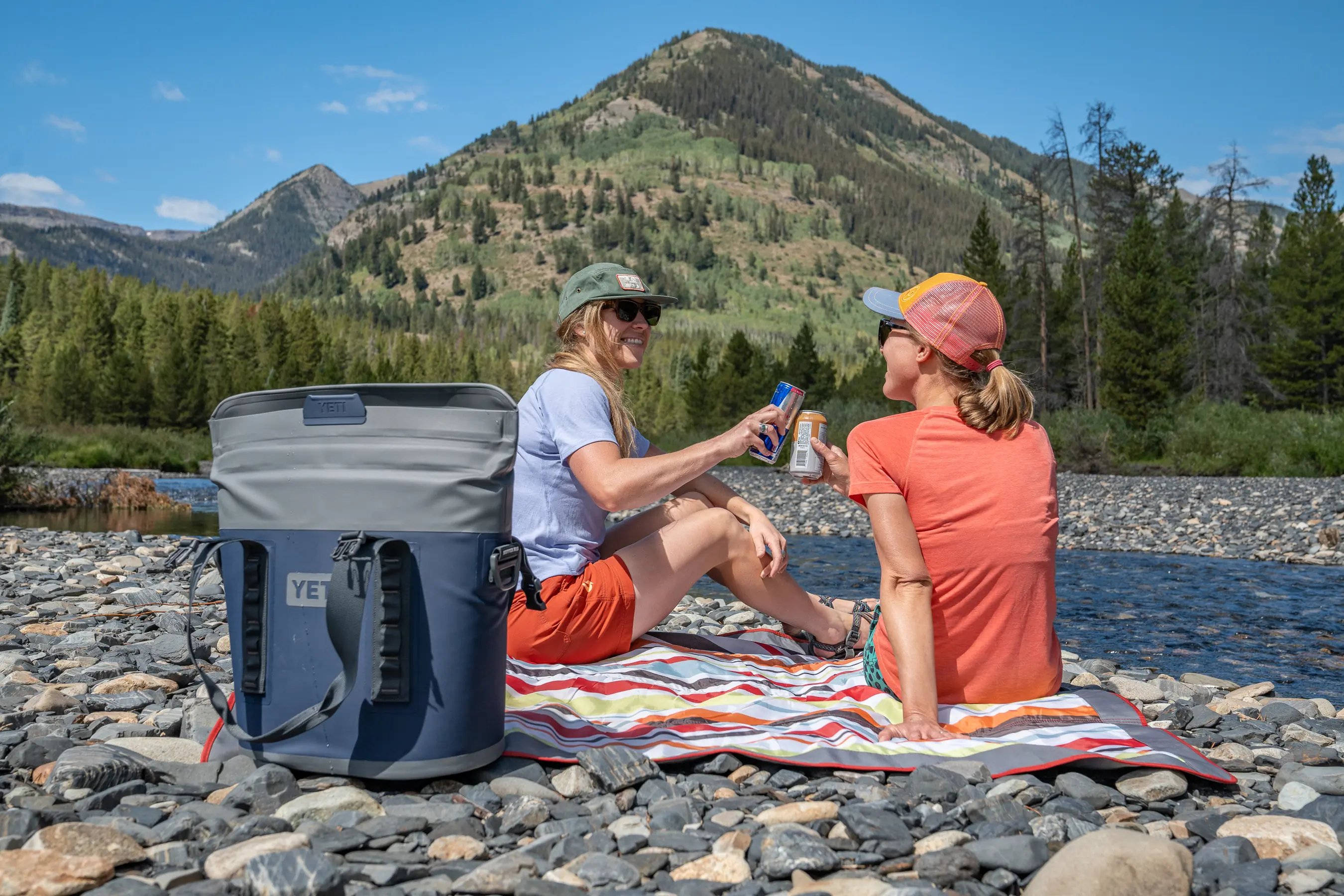



Price & Value
The price of a soft cooler is reflected by the volume, weight, carry design, durability, quality of materials, accessories, dry storage, and ice retention.
Checking the tags, the prices of soft coolers in our guide range from the 12-liter Mountainsmith Sixer ($40), which is among the smallest coolers, to the YETI Hopper Flip 12 Soft Cooler ($250) with top-shelf ice retention.
Budget
Plenty of soft coolers are fairly comfortable to use and reliable (as long as it’s not too sunny or scorching hot out) in the less-than-$100 category. Those choice designs include a range of designs such as the REI Co-op Campwell 18 L Folding Cooler ($40) and Titan by Arctic Zone Bucket Tote ($53).
You can anticipate that these coolers will serve you well on a half-day outing, office commute, grocery store run, or picnic. They’ll be fairly small and on the softer side of the spectrum — don’t expect much spine or weight-bearing prowess.
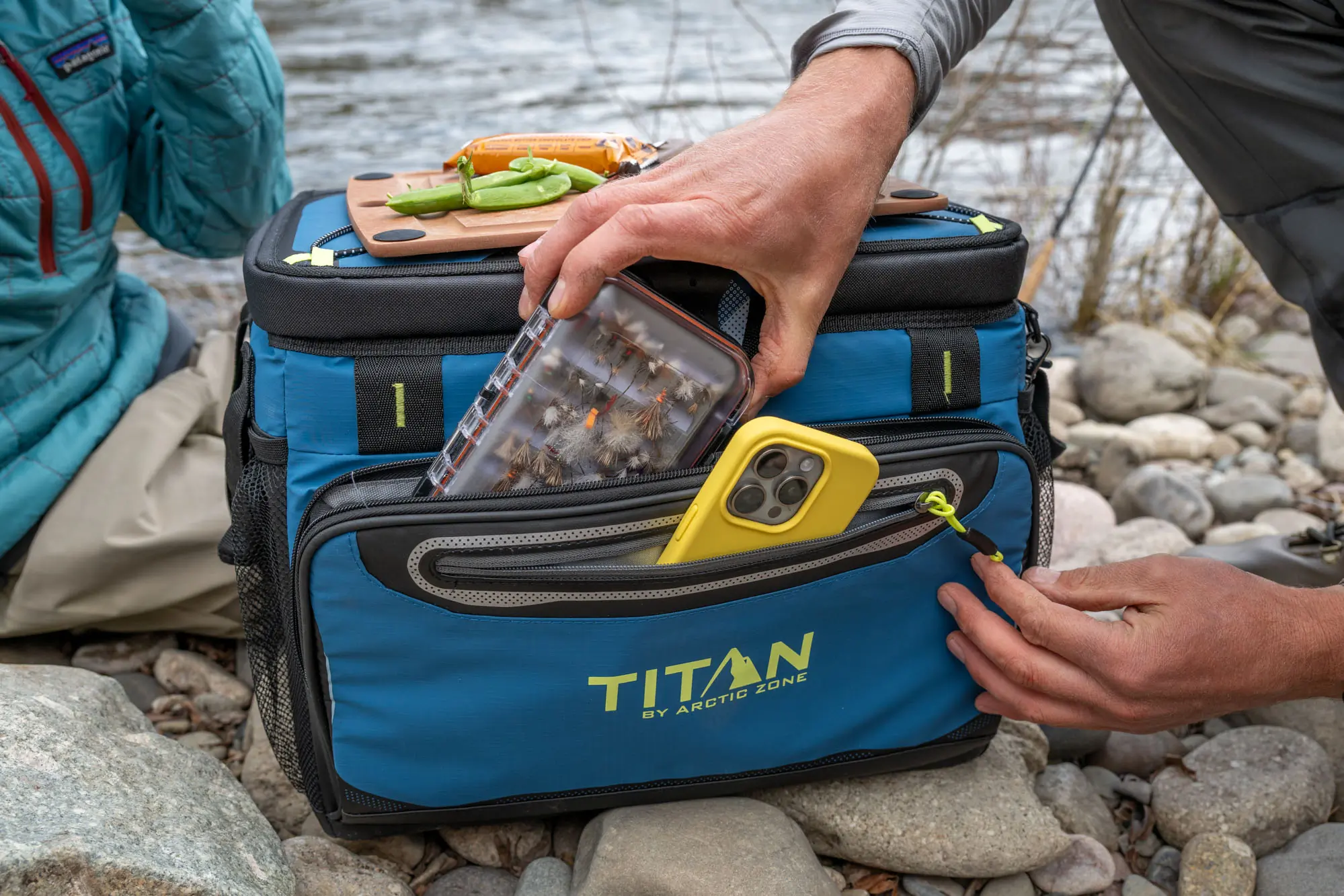



Mid-Tier
Moderately priced soft coolers have more garnish than budget designs. The size is larger — like for the Snow Peak Soft Cooler ($185) — or the design is more intricate and niche, like the bicycle-friendly ICEMULE Impulse ($100), which comes with handlebar attachments.
You can also find designs built with high-end materials, like the YETI Daytrip 14L Tote Bag, but they are relatively compact and lack sturdiness, so they haven’t bumped into the premium price tier.
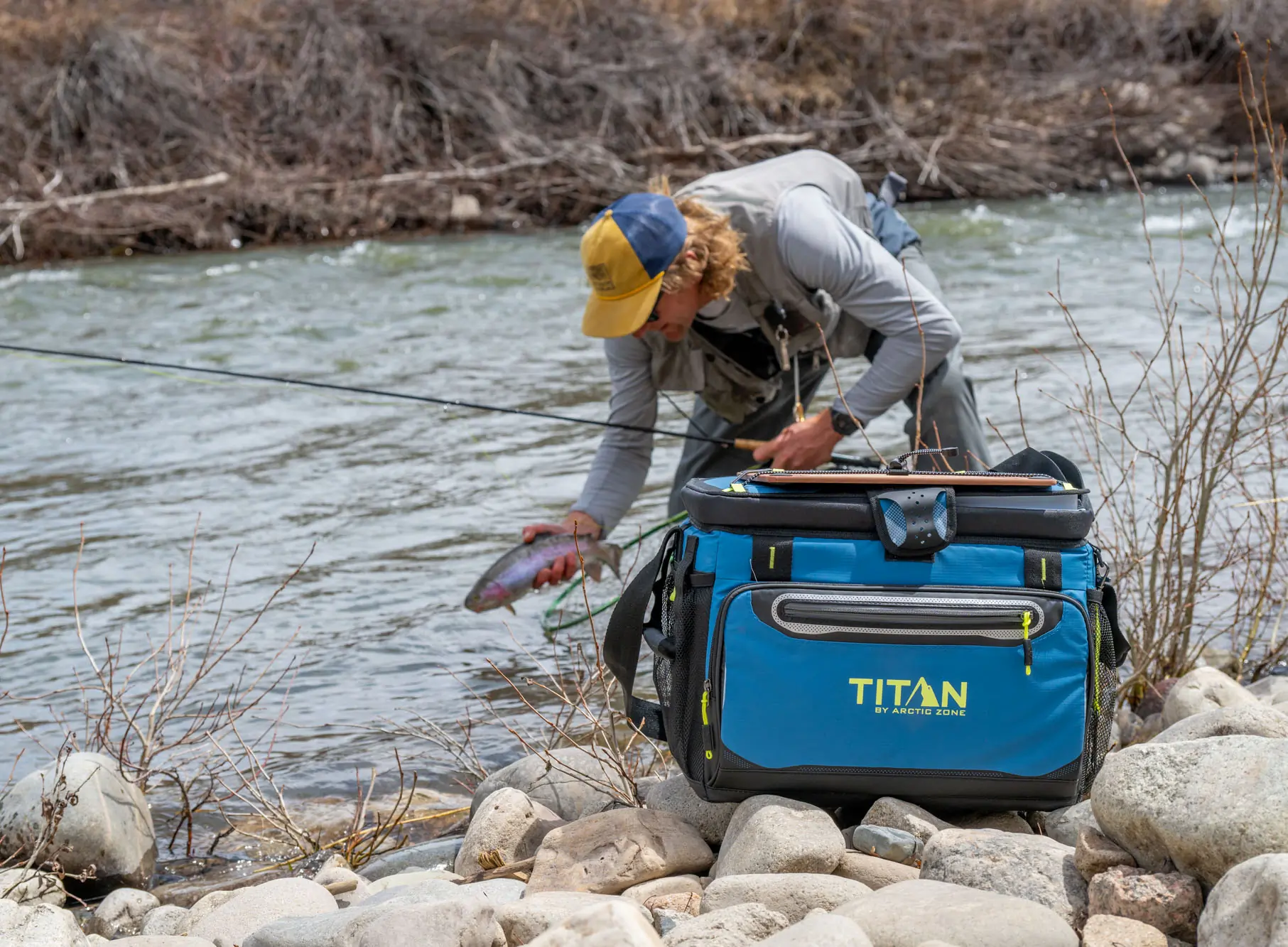



Premium
The YETI Hopper M15 Tote ($300) occupies the premium end, which was the queen of ice retention with 96 hours of stay power. The volume is on the larger end for soft coolers. The attachable shoulder strap is really sleek, durable, and comfortable, plus there’s an exterior pocket and ample attachment points for accessories. These are the details that comprise a top-notch soft cooler design.
With average ice retention but waterproof prowess, the Booe 30L Waterproof Insulated Tote ($200) is near that high-tier price, too. It offers a greater amount of volume and space compared to smaller soft coolers on our list. Also, this tote’s liner is removable, so the piece can double as a dry bag.
You’ll also find the RTIC 20 Can Soft Pack Cooler ($300), which is the sturdiest, stoutest soft cooler in our guide. If you don’t want your soft cooler to topple over, snag this one.


Frequently Asked Questions
There’s utility for both designs. Hard coolers are more durable and stout and have a larger size range, given they can hold more weight without collapsing. Hard coolers can also preserve ice for longer durations and some even come in an electric option, ensuring your items stay consistently cold. If you’re going on a weeklong car camping trip with limited access to ice, it’s advantageous to have a hard cooler for fresh food.
On the other hand, a soft cooler is a preferred choice for being lightweight, easy to carry — especially for one person — and simple to transport. The compact sizes are great for picnics, day trips, overnight camping, and grocery shopping. Another benefit is some soft coolers are collapsible, so they occupy less space in storage than a hard cooler.
For road trips, you can separate daytime beverages and snacks into a soft cooler, which limits opening of the hard cooler and preserves ice.
Some soft coolers are superior at ice retention, which is generally reflected in the price tag but not always. Some pricier coolers offer adequate ice retention mixed with other qualities like durability and capacity.
In our side-by-side ice retention test, the soft coolers that retained ice the longest were the RovR TravelR, YETI Hopper Flip 12 Soft Cooler, RTIC 20 can Soft Pack Cooler, which are each capable of holding ice for up to 72 hours, to each brand’s claim. However, the YETI Hopper M15 Tote was the reigning champ at retaining ice for up to 96 hours.
It was closely followed by the Titan by Arctic Zone Bucket Tote, which held ice for 70 hours. The lowest ice retention recorded was 25 hours for the Mountainsmith Sixer.
In daily adventures, melt speed slightly fluctuates based on the frequency of opening the cooler, how long it’s open, ambient heat, and direct sunlight. A bunch of other variables influence ice retention, too, including the type and quantity of ice, extra space in the compartment (which decreases effectiveness), and if the cooler was prechilled.
For the longest-lasting ice retention and cooling capability, aim to use a 2:1 ratio of ice to contents. You can quickly prechill your cooler with a sacrificial bag of ice a few hours before loading it up, especially if the cooler was stored in a hot place. Or, bring the cooler inside a cool room to lower the temperature the night before use.
The type of ice makes a difference. Block ice and fresh cubed ice from freezers are denser than chipped ice or crushed ice from ice machines. If you get super strategic, you can use a mix of block ice — which melts slowly — and cubed ice — which cools down the container quickly.
As the ice melts, it’s ideal to retain the ice water, which helps the other ice stay cold. Limit your access to the cooler because opening it up releases the cold air.
Keep your cooler in the shade to prolong that low temperature. If you’re under direct sun, toss a towel or blanket over the cooler to help alleviate a heat spike.
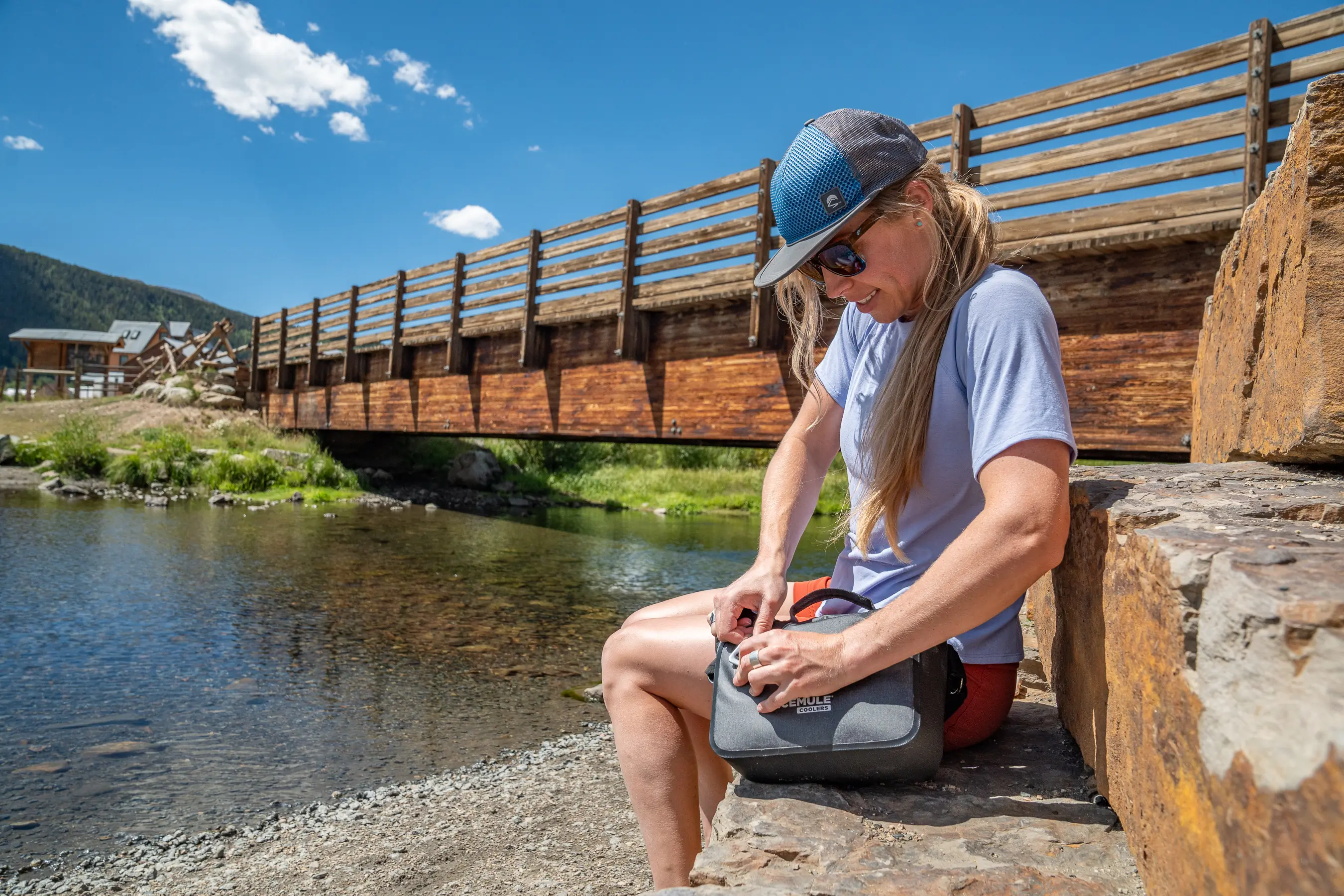



Both soft coolers and hard coolers have their strengths and weaknesses. Hard coolers tend to be better for longer trips or catering to larger group sizes, while soft coolers are great for shorter trips for fewer people.
The benefits of hard coolers are that they typically are more durable, sturdier, and keep ice longer than soft coolers. Some downsides to hard coolers are that they are more difficult to move and carry, and they can be harder to store since they don’t compact like soft coolers do.
On the other hand, the benefits of soft coolers are that they are more compact, store well, are more lightweight and easier to carry. Although they don’t preserve ice for as long as hard coolers, there are several neat design features, like extra pockets, hitchpoints, and additional carrying methods.
It really is ideal to have options to choose from depending on what adventure you’re planning. Having a hard cooler designated for food for the trip and having a soft cooler to get your drinks separated can be a helpful way to organize and keep your things cold and fresh.
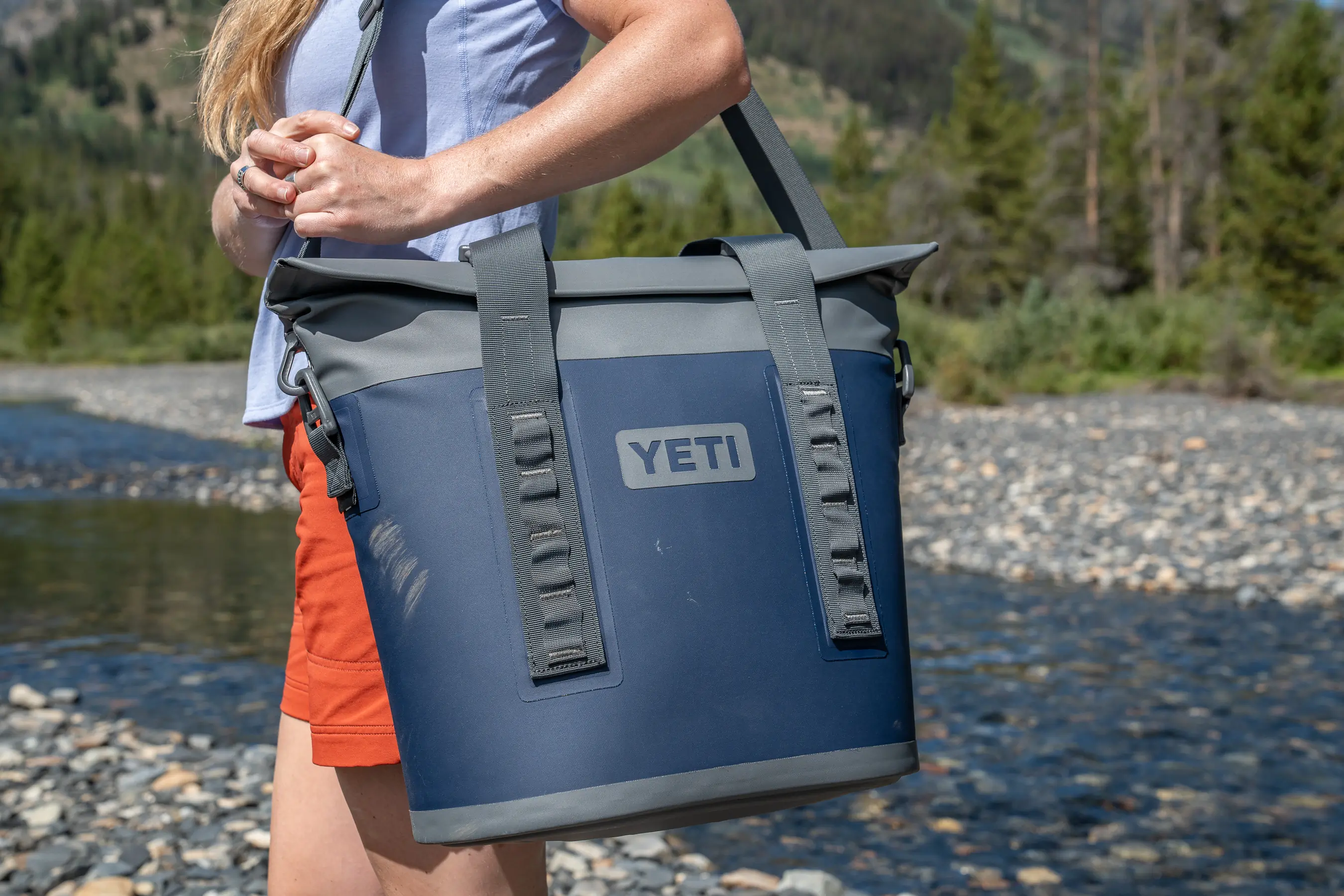



When selecting the right size soft cooler, it’s crucial to factor in the number of people you’ll be serving and the duration of your outing. For instance, a larger cooler that can store more food and drinks might be necessary for a longer trip, such as a weekend camping adventure.
Another key consideration when choosing a soft cooler is the type of items you’ll be packing. If you’re planning to bring bulky items like sandwiches or larger containers, a bigger cooler would be more suitable. However, if you just need to bring a few beverages a smaller cooler will do the trick. This factor, along with portability, should guide your decision. If you are looking for superior portability in a cooler, check out backpack coolers, instead.
In addition to choosing a larger volume for a longer trip or for outings in warmer climates, examine the ice retention and consider how much cooling power you realistically need. The greater the volume, the more ice you can fit inside the cooler.
Finally, some coolers come with extra pockets or compartments, which can enhance organization. You might want to choose a slightly larger size to take advantage of those features.
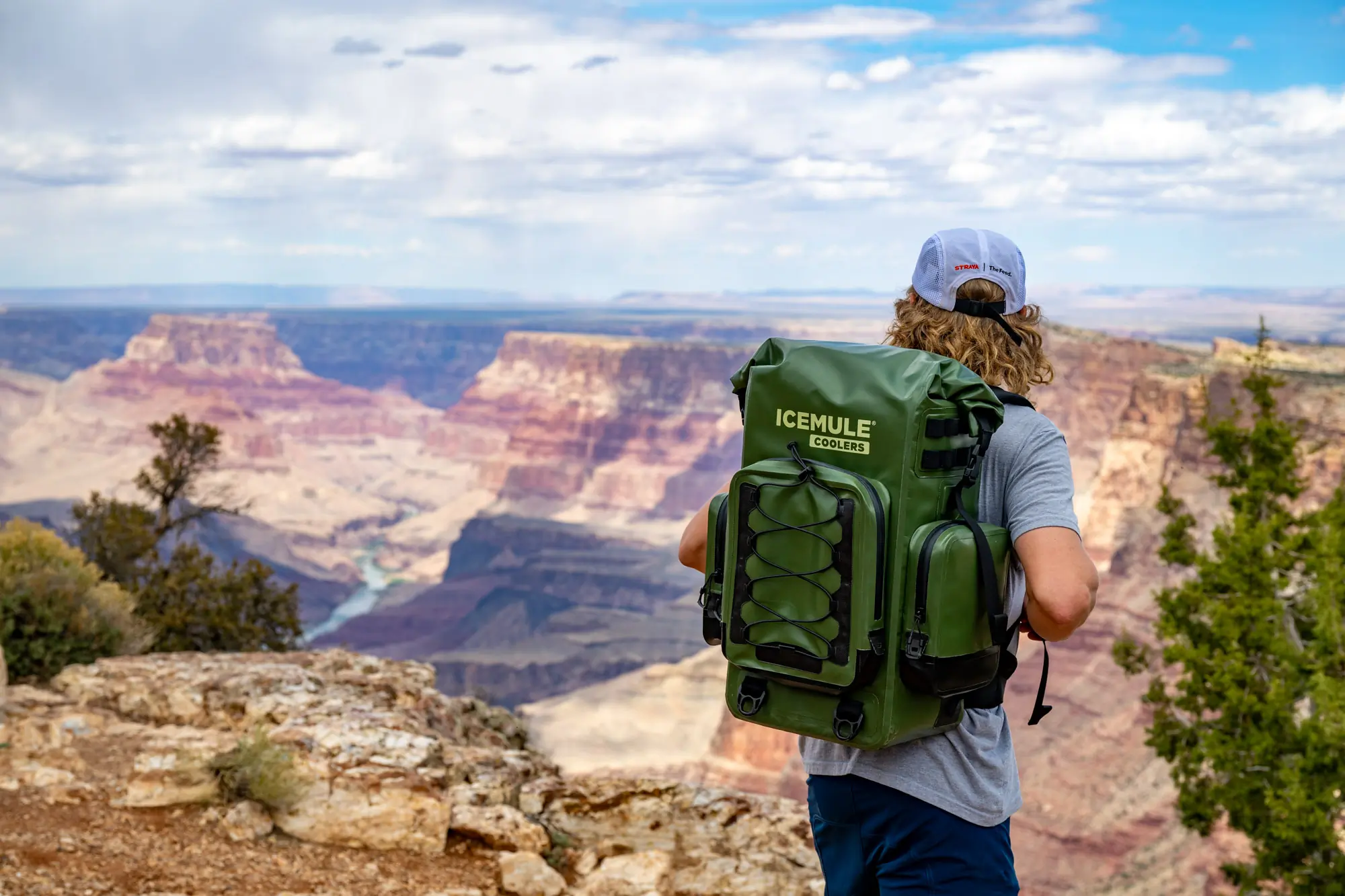

The Best Backpack Coolers of 2025
We tested the best backpack coolers with styles for every budget and trip. Top picks include ICEMULE, Hydro Flask, and more.
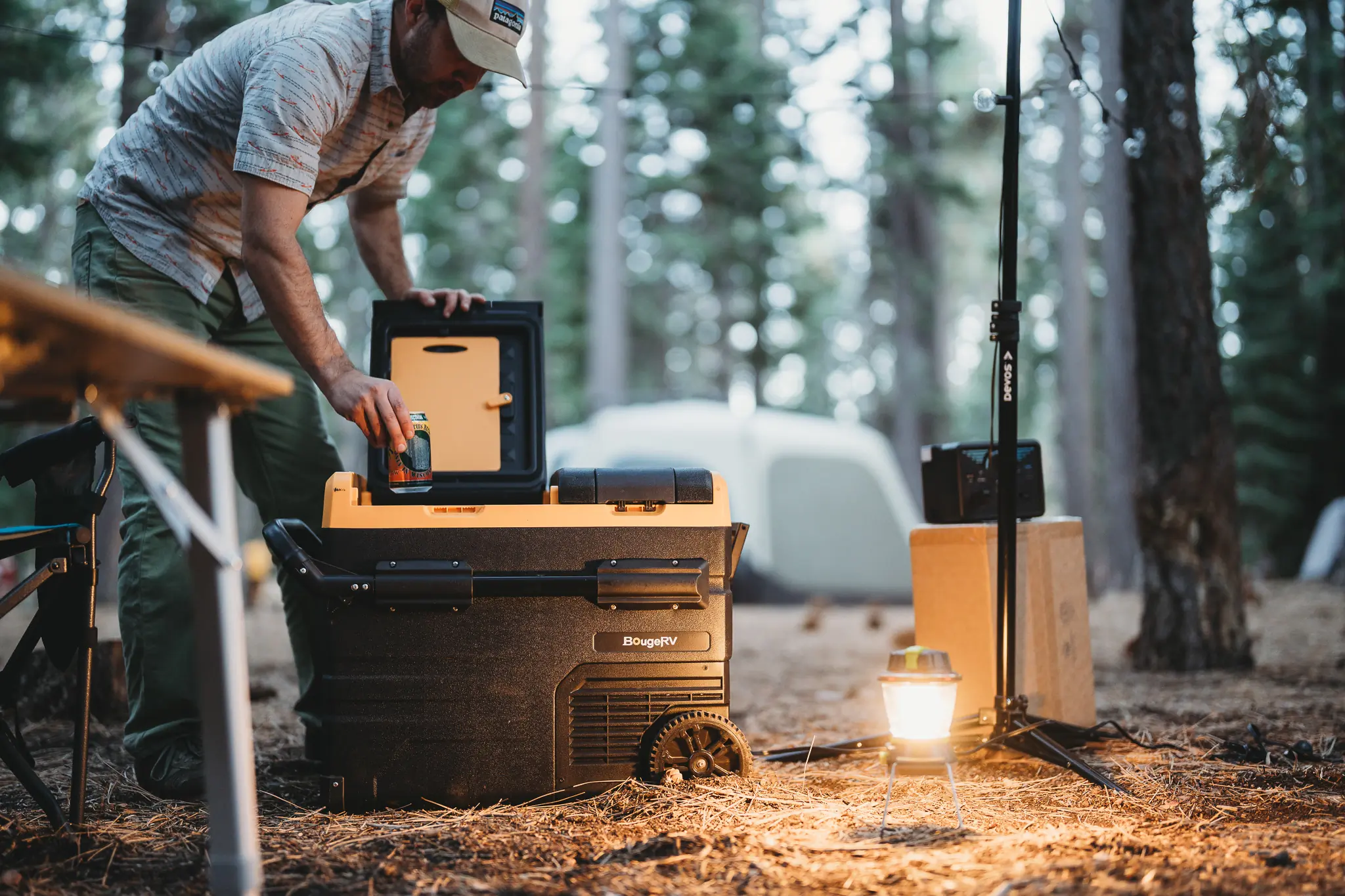

The Best Electric Coolers of 2025-2026
We tested the best electric coolers with options for every budget and need. Top picks include Dometic, Travoca, Engel, and more!
